




AUG 23 // COUNTRYROADSMAG.COM 2

// AUG 23 3
REFLECTIONS
A perch on the porch
by James Fox-Smith
8 NEWS & NOTEWORTHIES
42 HOUSE OF CARDS
A concrete refuge on the Prairie Basse by Jordan LaHaye
Fontenot
Mass at a tiny church, a treasure hunting guide & BRSO’s new music director 46
Events
HEAT INDEX
Ways to make the most of the hottest summer on record
THE LAST OF THE MASTERS
Chair craftsman Greg Harkins holds fast to his dying art by William Browning 48
RESTORING THE PINK PALACE
Architect Kevin Gossen’s plan to bring A. Hays Town’s most iconic building into the modern age by Caroline Alberstadt
On the Cover
THE LAST OF THE MASTERS
In his feature on page 46, contributor William Browning recalls the words of a cobbler he once knew, mourning that our “throwaway world” has undone its own need for craftsmanship. Browning drives out to the home of premier Mississippi chairmaker Greg Harkins. Harkins, now seventy-six, still creates chairs “the old way”—drawn from a trusted tradition that has gone untinkered with since the 1800s, passed down from one generation to the next.
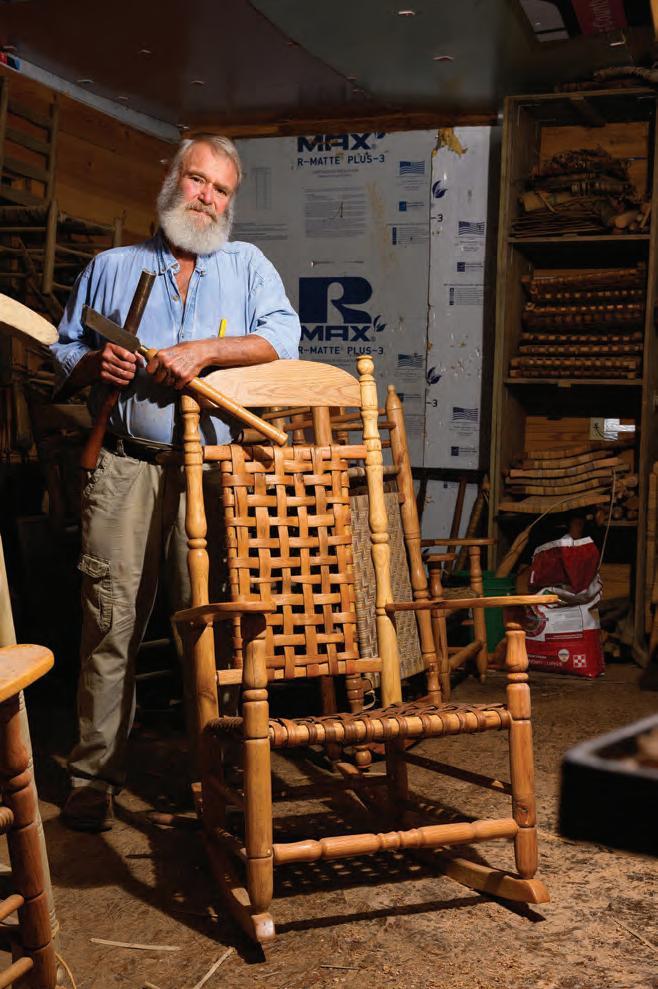
In the story, Browning obsesses over the anxieties of such a craft coming to an end, the possibility that the technique and the artistry will be inevitably lost with the last of the masters like Harkins. But while he worries over the future, and tries to get Harkins to worry with him, the craftsman keeps turning back to the past, speaking of his ancestors, his mentors, his hometown—the things that came before him, shaped him.
At the very same time, in Lafayette, Louisiana architect Kevin Gossen is making every effort imaginable to return an old iconic building to the glory of its past life (48). Students at the University of Louisiana-Lafayette are creating a haven of creative thinking using the most primitive of architectural forms (42). And New Orleans artist Carlie Trosclair is making art of broken plaster and torn wallpaper in abandoned buildings, meditating on the past and potential future inhabitants within their walls (70).
As insistent as the new may seem—the past presses forward, in our designs and
Cuisine Culture
SOUTHERN & WILD AS EVER
57
MEYER THE HATTER
Inside “The South’s largest hat store” by Poet Wolfe
Escapes
64
by April Hamilton
RISE & SHINE
Shreveport’s Kanya Michelle is living proof that a great biscuit can change your life
58
STRANGE TRUE STORIES PART III
Into plantation country we go by Nina Flournoy
62
63
UNSUNG DESIGNS
Stringbean supports & Birkenstock gate hinges by Ed Cullen
CRAPS: A MAN & A MYTH
The true story of Bernard de Marigny by Kent J. Landry
67
MCCARTYS
Internationally-known, quintessentiallyMississipi
by Mimi Greenwood Knight
PETRIFYING ANTICS
The fossilized forest in Flora by Chris Turner-Neal
Perspectives
70
ARCHITECTURAL SKINS


Explorations of space with New Orleans artist Carlie Trosclair by Jordan LaHaye Fontenot
Publisher James Fox-Smith
Associate Publisher
Ashley Fox-Smith
Managing Editor Jordan LaHaye Fontenot
Arts & Entertainment Editor
Alexandra Kennon Editorial Intern Audrey Livigni Creative Director Kourtney Zimmerman
Contributors: Caroline Alberstadt, William Browning, Kristy Christiansen, Paul Christiansen, Ed Cullen, Nina Flournoy, Mimi Greenwood Knight, April Hamilton, Chris Jay, Paul Kieu, Kent J. Landry, Shelby McClure, Kimberly Meadowlark, Christina Ogea, Kayland Partee, Chris Turner-Neal, Poet Wolfe
Cover Artist
Advertising
SALES@COUNTRYROADSMAG.COM
Sales Team
Heather Gammill & Heather Gibbons
Advertising Coordinator
Melissa Freeman President Dorcas Woods Brown Country Roads Magazine 758 Saint Charles Street Baton Rouge, LA 70802 Phone (225) 343-3714 Fax (815) 550-2272
EDITORIAL@COUNTRYROADSMAG.COM
WWW.COUNTRYROADSMAG.COM
Subscriptions
$21.99 for 12 months
$39.58 for 24 months
ISSN #8756-906X
Copyrighted. All rights reserved. No portion of this publication may be reproduced without permission of the publisher. The opinions expressed in Country Roads magazine are those of the authors or columnists and do not necessarily reflect the views of the publisher, nor do they constitute an endorsement of products or services herein. Country Roads magazine retains the right to refuse any advertisement. Country Roads cannot be responsible for delays in subscription deliveries due to U.S. Post Office handling of third-class mail.
AUG 23 // COUNTRYROADSMAG.COM
ISSUE
Contents VOLUME 40 //
8 AUGUST 2023
Chef Jordan Ramirez holds his own in Baton Rouge’s restaurant scene
52
11
6
Features Introduction
54

// AUG 23 5
Reflections
FROM THE PUBLISHER

Ispent last weekend building a set of gates for our front porch. Or I tried to. For an untrained amateur with a barnful of cheap tools and a propensity for biting off more than he can chew, the challenge of closing the eight-foot gap between the porch’s central pillars, while also matching railings built by a considerably better carpenter a century ago, has revealed various deficiencies in my handicraft skillset. But there is a reward: for the first time in twenty years we’ll be able to sit on this porch without first needing to kick animal bones out of the way. The goal is to exclude our three dogs, who regard the porch the perfect observation post upon which to lurk until the Amazon delivery man shows up to give meaning to their lives. When he does, they explode down the steps and surround the van bristling, barking, and snorting, while the poor delivery man sits inside trying to decide whether they really mean it. The regular guy knows that this rigmarole is all smoke and mirrors, and dispenses pats on his way
to leave packages on the steps. But we can tell when a new driver has been because that package is usually lying in the front yard after having been thrown out of the window. I feel bad about this but assume that for delivery people, dealing with melodramatic dogs is a hazard of the profession.
Our dogs take their sentry duties seriously, which I suppose is a good thing since we live in the exact middle of nowhere. If you’re wondering what kind of heartless dog-hater would want to exclude his staunch defenders from the front porch in the first place, know that our dogs are, usually, revolting. Being country dogs, they divide their summer days between sleeping in dust baths under the house, wallowing in ponds; and making life nasty, brutish, and short for squirrels, chipmunks, possums, raccoons, moles, and any other hapless varmint unfortunate enough to draw their attention. Winter adds mud and deer parts salvaged from the woods behind a nearby hunting camp to this evil-smelling equation. And at the end of the day, can you guess where our dogs most like to retreat to, to relish their conquests and perhaps gnaw on a possum jawbone or something? That’s right: the front
porch. Some days we come home and it looks like a cheap slasher film out there. Nothing says “Welcome to our home” like a front porch littered with animal carcasses. It certainly detracts from first impressions of the lovely garden that my wife has labored to create around it. Perhaps it’s a good thing the Amazon delivery man is occasionally frightened to get out of his van.
Were it not for the dogs, this porch could be a lovely place to while away a summer evening. According to my wife’s Aunt Frances, who grew up here with her grandparents, parents, and two sisters during the ‘40s and ‘50s, for decades the front porch was screened—same as the back porch is today. When she was a child, Frances remembers that on long, hot, pre-air-
conditioned summer nights, the doors at either end of the house’s central dogtrot hallway were thrown open to the porches. Then the whole family would gather on the front porch to share news, tell stories, play cards, or just sit and rock, while the old house ticked, settled, and cooled behind them, and the cold stars blazed overhead.
There’s something about sitting on a raised porch—with an unobstructed view before you and a sturdy house at your back—that feels right and good. No surprise, then, that there’s an architectural theory to explain what’s going on. Prospect and Refuge Theory holds that some environments simply make us humans feel secure. Chief among these is any place that provides us with an opportunity to observe goings-on (the “prospect” part), without actually being seen ourselves (“refuge”). So it stands to reason that when we’re perched in the deep shade of a porch, surveying our domain and secure in the knowledge that shelter is only a step away, everything seems right with the world. I suppose the dogs have had the right idea all along.
—James Fox-Smith, publisher james@countryroadsmag.com


AUG 23 // COUNTRYROADSMAG.COM 6
FranU Rising
With a stunning new building, Franciscan Missionaries of Our Lady University’s commitment to preparing graduates for successful healthcare careers grounded in love, faith, and community, is clearly visible
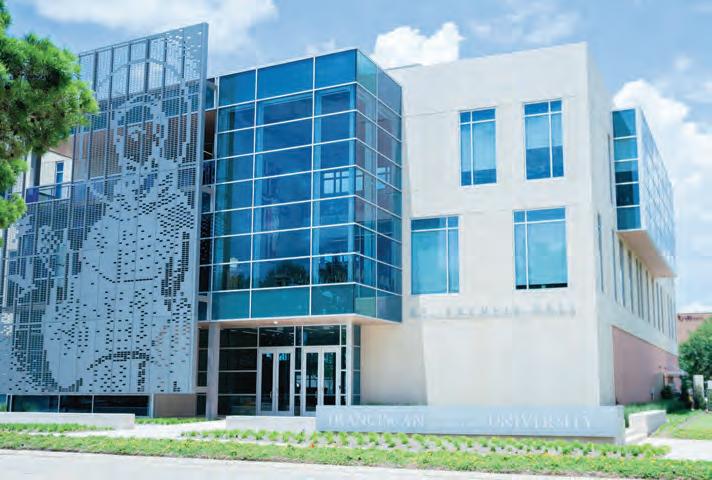
Summer, 2023, marks a major milestone in the evolution of Baton Rouge’s Franciscan Missionaries of Our Lady University (also known as FranU). In June the university welcomed faculty and students to St. Francis Hall, a soaring, light-filled landmark rising above Baton Rouge’s health district. Which represents the beating heart of the University and a major step in development of a master plan for campus expansion.
Since 2016, under the leadership of university President Dr. Tina Holland, FranU has undergone rapid transformation, evolving from a relatively unknown nursing school attached to Our Lady of the Lake Hospital, into an independent four-year academic institution offering highly-regarded health science and nursing programs delivered with a strong foundation in the liberal arts.

A $28 million, 75,000 square-foot facility, St. Francis Hall represents the first major building project in the hundred-year history of an institution that began on the banks of Capitol Lake. Speaking from her office on the third floor of St. Francis Hall, Holland discussed how FranU’s programs are preparing students for successful careers grounded in Franciscan values. She explained how this approach results in a richer educational experience for students, teachers, and employers.
In the nine years since, she has led FranU through a remarkable transformation, applying lessons learned helping Holy Cross College when at Notre Dame, Indiana, grow from a two-year commuter school into a fouryear residential college.

With St. Francis Hall housing classrooms, common spaces, a library, chapel, and stateof-the-art simulated teaching hospital known as SETH, Holland explained the institution’s commitment to fostering a relationship-based,
community learning environment is clearly visible. Over the next decade, the campus master plan will extend FranU’s footprint to a condensed three-block campus focused on students’ professional and personal development. As Holland says, “Gone are the days of indefinite growth in higher education institutions. Our mindset is to be the size and enrollment to meet community needs while preserving our Franciscan ethos.”
Education at FranU Develops in Response to Healthcare’s Evolution

As healthcare has become more technical while demanding greater emphasis on interpersonal skills, FranU’s curricula place emphasis on Catholic bioethics and medical ethics, preparing students to grapple with ethical questions arising from technical healthcare advancements.

To meet this need, FranU educates students for careers in healthcare and high-need care fields, while also providing a liberal arts foundation; and grounding in Franciscan values of service, reverence, love, humility, justice and joyfulness. Under Holland’s leadership, FranU has expanded programs in high-demand allied health fields such as medical lab science, respiratory therapy, physical therapy, and Applied Behavioral Analysis (ABA) therapy, which is used primarily to help patients with autism.
The institution’s community-centered approach carries over into clinical training. FranU partners with local healthcare providers including Our Lady of the Lake, Baton Rouge General Medical Center, Oschner Medical Center, and the Baton Rouge Clinic to help shape curricula and provide vital clinical experience for students. To reduce siloing accompanying specialized medical treatment, the university uses an interdisciplinary
approach in its simulation hospital, bringing together various healthcare professionals to solve real-world problems.
Holland believes in viewing education as more than career preparation, seeing the mastery of skills and the formation of character as equally important aspects of personal development. She maintains that the liberal arts have an essential role to play an a well-rounded education. As she says, “If we value and develop human potential, graduates contribute to society in social and moral, as well as economic ways.”
The 1,300-strong student body caters to a wide range of students, including many firstgeneration and Pell Grant-eligible students. While positioned to expand enrollment, Holland insists the focus remain on responsibly meeting community needs and remaining affordable. When planning courses, FranU factors tuition fees against potential earnings to ensure a just student debt burden.
This relationship-based education answers employers wanting professionals able to communicate, lead, and relate well to others. As Holland says, “Healthcare providers invest in our graduates because they’re qualitatively different.”
With St. Francis Hall now fully operational, Dr. Holland explained that plans call for continuing to update FranU’s buildings and consolidating the campus footprint while preserving the institution’s intimate, relationship-based community learning environment. Despite the University’s small size, Holland notes that today, FranU is the largest provider of health care professionals in the Greater Baton Rouge area. “We rely on the community and the community relies on us,” she says.
// AUG 23 7 A Special Advertising Feature from the Franciscan Missionaries of Our Lady University
Dr. Tina Holland
For more information, please visit franu.edu
Worship at the “World’s Smallest Church”
last century, when the eldest son of Italian sugar farmer Anthony Gullo fell ill. Gullo prayed to the Virgin Mary to help his son, and in exchange for her intercession, he promised to build a chapel in the Blessed Mother’s honor. When the child recovered, the farmer kept his promise and constructed the Madonna Chapel in 1903.

Shortly after the Madonna Chapel was built, Mass on the Feast of the Assumption of Mary, a Catholic holy day celebrating the entrance of Mary’s body and soul into heaven. With only a few exceptions, every August 15, the traditional Mass is held in the tiny chapel—honoring the woman whose intercession inspired its inception.
Off the beaten path in Iberville Parish, an unassuming, white chapel stands watch over the Mississippi River. A white picket fence encircles the property, forming a barrier between the tiny church and the neighboring homes with their wandering cattle. The church is easily

overlooked on a drive along River Road, overshadowed by larger attractions such as nearby Nottoway and the Plaquemine Lock State Historic Site. Yet, for more than 120 years, its presence here has been a constant reminder of gratitude for an answered prayer.
The story dates back to the turn of the
Built from Louisiana cypress donated by neighbors, the original structure measured only seven feet by seven feet and, according to local resident Betty Aucoin, was octagon-shaped. After a new Mississippi River levee was constructed in 1924, the chapel was moved and rebuilt to be slightly larger—at nine feet by nine feet. Now, the front and two sides are square, but the back still retains the original octagon profile. A sign notes that it was once listed in Ripley’s Believe It or Not as the “smallest church in the world”.
For the Love of Trinkets
Oh, the temptation of shiny, beautiful things! Just like magpies, humans have been susceptible to the draw of the artful knickknack since long before the throes of Western capitalism took over the world. The sparkle of crystal, the whorls of old wood—the surge of dopamine sparked by possessing gains a little bit of respectability when you start talking about handmade things, or antiques. Works of art and memory, promising to add character and story to your home. My particular weakness has always been boxes made beautifully, especially old ones. You can find these at each of the three locally-owned treasure troves below—along with much, much more.
The Corbel, St. Francisville
Founded in the purest of ways, by two brothers who loved to make old things new—The Corbel has been around for decades, but its recently-opened 10,000-square-foot showroom in downtown St. Francisville is the talk of the town. Find handmade furniture, often built from salvaged materials, displayed gorgeously alongside a curation of antique doors, high-end furniture, and an incredible curation of designer décor and art imported from around the world. Go start your dreaming at thecorbel.com, and then get an in-person visit at 5741 Commerce Street on your schedule, pronto. Open Monday–Saturday 10 am–5 pm.
Maetiques, Baton Rouge-Online
Started last summer by Maegan Durand from Baton Rouge, who is pursuing the great dream of turning her shopping addiction into her business, Maetiques sells a collection curated for the grandmillenial. Sourcing treasures from all over the world, which she styles fashionably for Instagram close-ups, Durand specializes in European heirloom antiques: hand-carved alabaster stone column bookends from Italy, wooden perfume boxes with floral inlay from the 1800s. She admits to having an obsession with French lamps. And girl does her research. Find her at @maetiques on Instagram.
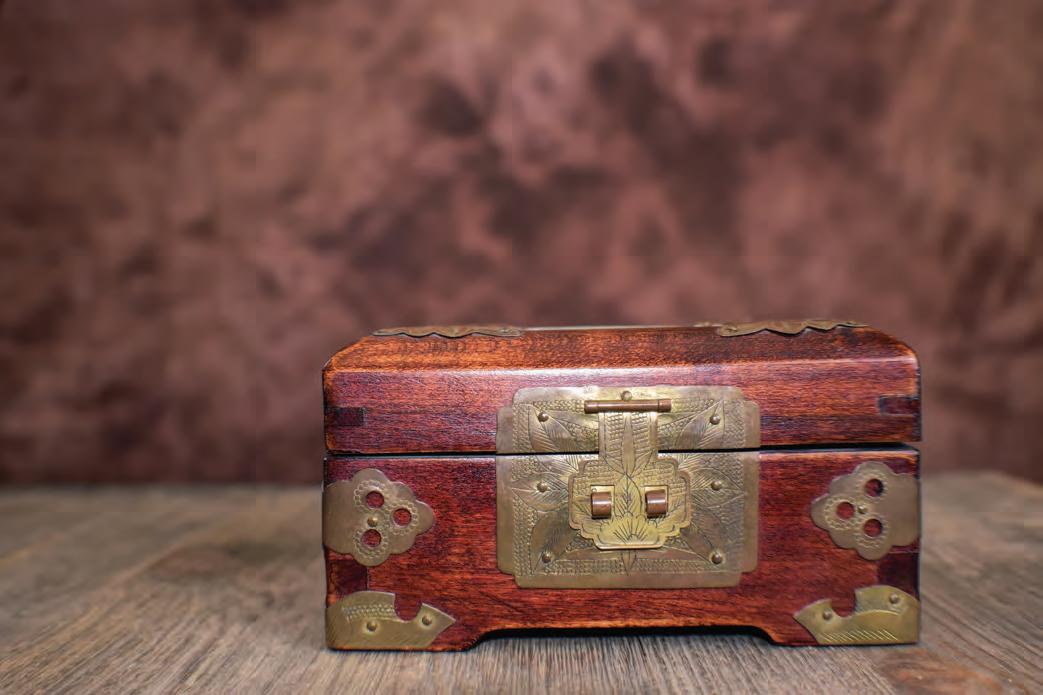
Sans Souci Gallery, Lafayette
For those of us who want to prioritize buying from our friends and neighbors, the Louisiana Crafts Guild’s Sans Souci Fine Crafts Gallery has been a go-to giftshop for over twenty years. Now in their brand-spanking new location right on Jefferson Street, the Guild has even more space for their inventory of locally-crafted works of art: jewelry, sculpture, ceramics, paintings, and even furniture. Everything in the store is made by Louisiana artists, inviting shoppers not only to support their local creative economy but also to explore the vast diversity of work being created by folks from around the corner. Learn more about the Guild at louisianacrafts.org, and visit the new space at 551 Jefferson Street, Wednesday–Saturday, 11 am–5 pm, Sunday 9 am–2 pm.
—Jordan LaHaye Fontenot
“Several hundred people come out here under the trees,” said Aucoin, who bakes cakes and Italian cookies for the annual Mass. “It’s hot out here, but they still come out. Every so many years, the original family comes down too. They moved to Chicago, though, and there’s not many of them left.”
Sisters-in-law LouAnna Canelle and Frances Temperano assumed the duties of keeping the church tidy and maintained after the previous caretaker, Mitzi Roppollo, moved out of town. The ladies hold a raffle and bake sale after the service, with proceeds supporting the church’s upkeep throughout the year. This year’s Mass begins promptly at 9 am on the chapel’s front lawn. The church is located on Highway 405 River Road, just north of Bayou Goula, a tiny town with a long Catholic history beginning with the missionary efforts of Father Paul Du Ru, who built the first chapel in Louisiana near here in 1700 and held the first recorded Mass.
Throughout the rest of the year, travelers are invited to stop and take a closer look on the church grounds. Though the building itself is often locked, the key is kept in a small mailbox beside the door. A walk inside reveals a small kneeler and an altar adorned with statues of Christ and his mother. Gullo ordered the large Madonna statue, which predates the chapel, from Italy. On the wall hangs a framed sheet of paper detailing the chapel’s history, and votive candles are available for purchase.
A sense of peace emanates from the interior, which offers a quiet respite from the outside world. Shaded by large pine and oak trees, the heart of the chapel is surprisingly cool even on a scorching summer day. Visitors are encouraged to sign the guest book and linger as long as they wish, enjoying the haven built by Gullo in honor of the Blessed Mother’s help in his time of need.
—Kristy Christiansen
AUG 23 // COUNTRYROADSMAG.COM 8 Noteworthy LOOK CLOSER NEWS, TIMELY TIDBITS, AND ASSORTED CURIOSITIES • AUGUST 2023
TREASURE
THINKING
3 LOUISIANA
SHOPS WE CAN’T STOP
ABOUT
IBERVILLE PARISH’S MADONNA CHAPEL WILL CELEBRATE ITS ANNUAL FEAST OF ASSUMPTION MASS THIS MONTH
Photos by Paul Christiansen.
A New Maestro Picks Up the Baton

A QUICK Q&A WITH BRSO’S NEW MUSIC DIRECTOR, ADAM JOHNSON

Society’s interest in differing musical genres tends to wax and wane as tastes shift from one generation to the next. Jazz is still beloved worldwide, but arguably has never been so popular as during the Jazz Age of the 1920s. Alternative rock hasn’t gone anywhere, but its mainstream following receded a bit at the end of the 2000s. The grandfather of both these genres and countless others, classical music, has arguably faced and overcome the greatest challenge, maintaining its relevance from the days of parlor performances well into our current era of digital streaming services like Spotify. How then does a musical genre often still associated with powdered wigs and pantaloons continue to grab audiences in 2023? It is largely thanks to organizations like the Baton Rouge Symphony Orchestra, which remains committed to delivering the magnificence of the classical canon in the form of regular, accessible, live orchestral performances. BRSO has recently welcomed a new Music Director, Maestro Adam Johnson, whose “charismatic and commanding presence” as a conductor and extensive experience—including conducting the Orchestre Symphonique de Montréal— promises to help the BRSO maximize its reach.
As we head toward Symphony Week, when free performances will be offered throughout Baton Rouge from August 6–10 (see calendar listing on page 22), we asked Maestro Johnson a couple of questions about how he hopes to share his love of classical and orchestral music with the capital city.
What do you hope to accomplish as Music Director of BRSO?


With the orchestra I want to create truly extraordinary musical moments that are inspiring for both the audience and for us on stage. By going beyond excellence through a deep love for both the music and the people we are sharing music with, I feel we can create something special.
Why do you think it's important that classical and orchestral music are carried into the future, and how do you think this type of musical performance can best be continued, in Baton Rouge and beyond?


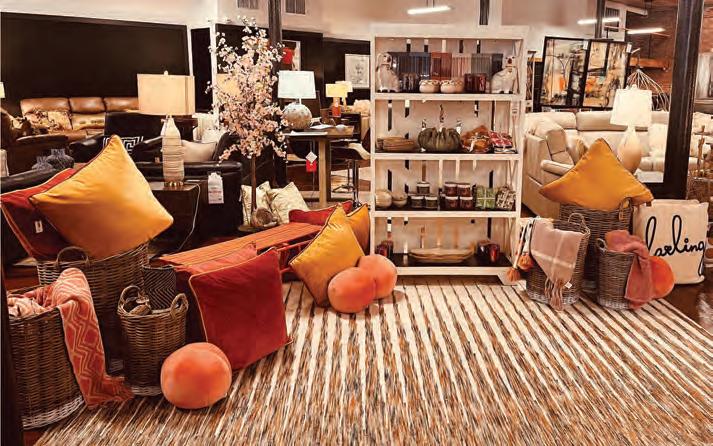

Great music transcends the time and place it was conceived, reaching us here and now. The power, brilliance and emotions contained in a symphony by someone like Beethoven touch on deep aspects of the universal human experience, so rather than being distant, the music is very relevant to each of us. We can come away from experiencing great music with renewed energy and perspective. The orchestral repertoire is so vast, drawing on hundreds of years of compositions by hundreds of exceptionally gifted creatives from around the world, and it's also an artform that continues to thrive today in many different styles, so it's important to give people access—we can't love what we don't know! For the best music to continue to live it requires performances that light up the audience; we at the BRSO are here to serve the city of Baton Rouge and beyond with thrilling concert experiences and meaningful music making.
—Alexandra Kennon
In addition to Symphony Week, Maestro Johnson is also taking part in a series of “Meet the Maestro” events to get to know the community from August 5–9 (see calendar listing on page 19) brso.org.
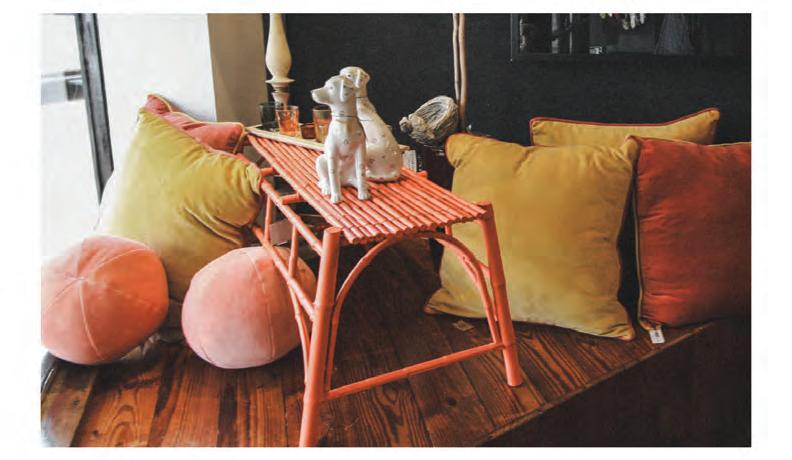
// AUG 23 9
Photo of Maestro Adam Johnson by Sean Gasser, courtesy of the Baton Rouge Symphony Orchestra”

AUGUST 23 // COUNTRYROADSMAG.COM 10
UNTIL AUG 26th
ART MEETS A/C
ELIZABETHAN GALLERY HOT SUMMER ART SHOW
Baton Rouge, Louisiana
Each summer the Elizabethan Gallery's summer art show showcases art by talented Baton Rouge artists of various mediums. Muted interpretive landscapes by Mickey Asche and colorful, figure-based abstracts by Keith “Cartoonman” Douglas will be featured. elizabethangallery.com. •
UNTIL AUG 27 th
SELF REFLECTION
NUNU COLLECTIVE
SELF PORTRAIT SHOW
Arnaudville, Louisiana

Arnaudville's vibrant culture and arts enclave, NUNU, is presenting a show of self portraits by its members in Galerie Coin Coin. nunuaccollective. homesteadcloud.com. •
Events



UNTIL AUG 31st
BEADED BEAUTY
VAIRIS, PERE ET FILS: SEQUIN ART FROM HAITI AT CITE DES ARTS
Lafayette, Louisiana
Father-and-son Haitian artists Georges and Valentin Valris return to Louisiana with a new collection of Haitian folk art using sequins called "Drapo Vodou"—to be exhibited this summer at Cité des Arts. Georges has long been friends with Lafayette, having inspired Festival International founder Tina Girouard's book Sequin Artists of Haiti, and his work is featured in the National Gallery of Art in Washington, D.C. citedesarts.org. •
UNTIL SEP 14th
JOY OF THE PROCESS
THE ART GUILD OF LOUISIANA WORKSHOP SHOW
Baton Rouge, Louisiana
Sometimes, a workshop setting and a little guidance can produce impressive
works of art. That's where the Art Guild of Louisiana's annual Workshop Show comes into play, giving these pieces their own chance to shine on the walls of the Independence Park Theatre Gallery. A reception will be held on August 6 from 2 pm–4 pm. artguildlouisiana.org. •
UNTIL AUG 26th
EXPLORE NEW MEDIUMS
STUDIO SATURDAYS AT LASM
Baton Rouge, Louisiana
The Louisiana Art & Science Museum has launched a new weekend program during the summer called Studio Saturdays, where local artists will teach the Baton Rouge community about a variety of mediums and walk them through creating their own unique works of art over the course of seven classes. This summer's workshop series will be led by local artist and illustrator Kelsey Livingston, who will guide participants in creating a mixed media wearable printed work, table linen, or tapestry that incorporates
//AUGUST 23 11
The Gueydan Duck Festival brings sportspeople and festival lovers alike to the small Southwest Louisiana town for competitions like skeet shooting and decoy carving, plus cook-offs, pageantry, and more. Pictured is 2022 Duck Festival Queen Jadyn Pauline Devillier, courtesy of the Duck Festival. See listing on page 36 for more information.
Events
Beginning August 1st - August 2nd
drawing, patterning, design, printmaking, and simple sewing. 10 am–noon each Saturday until August 26. $250 ($225 for LASM members) for all seven classes, which includes most supplies. Find more information and register at lasm.org. •
UNTIL OCT 8th
EXAMINING AMERICA
AMERICAN DEMOCRACY: A GREAT LEAP OF FAITH AT THNOC
New Orleans, Louisiana
See the traveling Smithsonian exhibition American Democracy: A Great Leap of Faith at the Historic New Orleans Collection through this fall. The collection examins the origins and evolution of American democracy from its inception in 1776 onward. Free. hnoc.org. •
UNTIL OCT 29
BLUE DOGS
THE RIVER IS THE ROAD: PAINTINGS BY GEORGE RODRIGUE AT THE WEST BATON ROUGE MUSEUM
Port Allen, Louisiana
George Rodrigue, beloved New Iberia painter of the "Blue Dog" and countless other symbols of Louisiana culture and lore, frequently utilized the image of the river to reflect his own Cajun background as well as his larger life journey. For the first time, an exhibition at the West Baton Rouge Museum organized by Rodrigue's Life & Legacy Foundation is tracing Rodrigue's use of the river throughout nearly five decades of his work—including forty-five original works from paintings, to sculptures, to metal works loaned from the private collections of Rodrigue's surviving wife Wendy Rodrigue, the George Godfrey Rodrigue, Jr. Family Trust, and various collectors. westbatonrougemuseum.org. •
UNTIL NOV 26th
PROJECT RUNWAY
FASHIONING AMERICA: GRIT TO GLAMOUR AT NOMA

New Orleans, Louisiana
The New Orleans Museum of Art's latest exhibition walks the viewer through over two centuries of innovations in American fashion design—highlighting fierceness that goes all the way back to the founding fathers. Fashioning America: Grit to Glamour celebrates under-recognized designers, marks seminal moments in the fashion industry, and explores the ways American fashion is reflected in international trends. noma.org. •
UNTIL JAN 28th
STAR STUFF
CELESTIAL IMAGININGS: ARTISTS EXPLORING THE GALAXIES AT LASM
Baton Rouge, Louisiana
The beauty and wonder of the night sky has captivated those of us on this floating rock called Earth for centuries.
The Louisiana Art & Science Museum (LASM)'s newest exhibition Celestial Imaginings: Artists Exploring the Galaxies celebrates these vast cosmos along with the twentieth anniversary of LASM's Irene W. Pennington Planetarium by inviting eight contemporary artists to offer their interpretation of the planets, stars, and night sky—which are on display in The Republic Finance Gallery. lasm.org. •
AUG 1st - AUG 29th
MUSIC IN THE AIR BALCONY CONCERT SERIES AT THE JAZZ MUSEUM
New Orleans, Louisiana
Appearances from New Orleans's best can be counted on atop the Jazz Museum's balcony, serenading all of Esplanade in true New Orleans spirit. Bring your blanket to sit on or comfortable shoes for dancing, as seats are not provided for this outdoor program. 5 pm–6 pm every Tuesday. nolajazzmuseum.org. •
AUG 1st - AUG 29th
AFTERNOON JAZZ
ARROWHEAD JAZZ BAND AT THE JAZZ MUSEUM
New Orleans, Louisiana
Come enjoy performances by the Arrowhead Jazz Band every Tuesday this August at the New Orleans Jazz Museum's Performance Center listening room. 2 pm–3 pm. Free. nolajazzmusuem.org. •
with Jane Dick. 4 pm–6:30 pm. $180 for one month.
August 18: Mugs and Merlot with Jane Dick. 6 pm–8:30 pm. $80. sttammany.art. •
AUG 2nd
PAINTING WITH PAIRINGS
BRUSHES AND BUBBLES AT MIDDENDORF'S SLIDELL
Slidell, Louisiana
Middendorf's Slidell is extending its offerings beyond the joys of eating and drinking this August for its Brushes & Bubbles event, hosted by European Master Chef Horst Pfeifer and Lorraine Streckfus of Constellation Brands— who will be bringing an exciting selection of sparkling summer wines for the occasion. She'll also be leading the evening as artist-in-chief, guiding guests through the creative process of creating their own masterpieces while they enjoy a gourmet meal. 6:30 pm. $100. middendorfsrestaurant.com. •
- AUG 30th
JAZZ FOUNDATION OF AMERICA OUTDOOR
The Jazz Foundation of America presents a free, outdoor music series at the New Orleans Jazz Museum in the Old U.S. Mint. Here's what to see Wednesdays in
Storyville Stompers
Leroy Jones & New Orleans' Matt Booth & The
The Original Royal Players
Colliding Currents The series will also be streamed live to the New Orleans Jazz Museum's Facebook Page. nolajazzmuseum.org. •
AUG 2nd - AUG 30th
TWO STEPPIN' CAJUN JAM AT THE BLUE MOON SALOON
AUG 1st - AUG 29th
TUNING & STRETCHING
JAZZ YOGA AT THE NEW ORLEANS JAZZ MUSEUM
New Orleans, Louisiana
Join instructor Adrienne Byrd for a one-hour session of mindfulness and meditation targeted towards local musicians, featuring improvisational movements drawn from yoga against a backdrop of live jazz music. 3:30 pm on Tuesdays and 10:30 am on Saturdays. Free. nolajazzmuseum.org. •
AUG 1st - AUG 31st
MAKE IT WORK
ST. TAMMANY ART ASSOCIATION WORKSHOPS
Covington, Louisiana
This summer, the St. Tammany Arts Association has created a variety of creative experiences with clay for artists of all levels. See the schedule below:
Tuesdays and Thursdays in August: Open Pottery Studio with Jane Dick. 4 pm–8 pm. $200.
August 6, 13, 20: Pottery Wheel Basics
Lafayette, Louisiana
Come to the Blue Moon for the generative magic of its weekly Cajun jam. Open to every skill level, the jam is a great opportunity to learn from the best and to make that special sound we know of as Cajun music. Never scripted, never the same, you never know who is coming or who might show up. But there is always plenty of dancing to be had (as well as free rice and gravy and an all-night happy hour). 8 pm on Wednesdays. Free. bluemoonpresents.com. •
AUGUST 23 // COUNTRYROADSMAG.COM 12
Teri Greeves, Abstraction: Kiowa by Design, 2014. Beads on canvas high-heeled sneakers, 11 1⁄2 x 10 x 4 inches. Crystal Bridges Museum of American Art, Bentonville, Arkansas. Photography by Edward C. Robinson III. Courtesy of NOMA, from their current exhibition Fashioning America: Grit to Glamour.

//AUGUST 23 13
Events
Beginning August 3rd
AUG 3rd
MEDITATIVE MUSIC PLANET M AT THE NEW ORLEANS JAZZ MUSEUM
New Orleans, Louisiana
Brought to you by the New Orleans Jazz Museum and performance educator Ryuta Iwashita, Planet M brings local musicans and movers together to explore jam as ritual. No one is audience—everyone is a participant, joining the group through three phases of awareness and meditation practices centered on music and movement. No experience required, but if you play music, please bring your instrument. 10 am–noon. $10–$20 donation encouraged. nolajazzmusuem.org. •
AUG 3 rd
SCHOOL OF ROCK
YOUNG BAND NATION
CONCERT SERIES
Baton Rouge, Louisiana
Curbside Burgers is joining forces with the Baton Rouge Music Studio to provide cool performance opportunities to young local bands on their outdoor

stage The Pig Pen. The Young Band Nation Concert Series will take place the first Thursday of each month during summer from 5 pm–8 pm, and the Young Band Nation Summer Camp Performance Series will take place every two weeks through summer at 3 pm. Free. curbsideburgers.com. •
AUG 3rd - AUG 6th
RECORD COLLECTIONS
THNOC ANTIQUES FORUM: MUSIC TO MY EYES
New Orleans, Louisiana
To celebrate music being such an integral part of New Orleans history and culture, The Historic New Orleans Collection's 2023 Antiques Forum will focus on the objects from throughout time that best illustrate Louisiana's musical legacy. This year's forum will discuss items like early glass jazz records, antique Mardi Gras ball dance cards, and even Sidney Bechet's clarinet. Speakers range from American Routes radio host and folklorist Nick Spitzer to Cajun accordionist André
Michot, with plenty of musicologists, authors, and other scholars in between. Besides talks and panels with these experts, other activities like a champagne reception and celebratory brunch will round out the weekend. This year, THNOC is offering individual day tickets ($150 for Friday or Saturday, $50 for Sunday), as well as a Young Professionals rate of halfpriced single-day tickets. Tickets for the full Forum are $300. Find the full schedule of lectures, brunches, cocktail parties, and more at hnoc.org. Read more about THNOC's 2023 Antiques Forum in Alexandra Kennon's story on pg. 21. •
AUG 3rd - AUG 24th
PAINT PROGRESS ACRYLIC WORKSHOP: PAINTING YOUR WORLD
Baton Rouge, Louisiana
The Art Guild of Louisiana is offering classes in how to recreate scenes from the world around you with acrylic paints, led by artist and instructor Larry Downs at the Studio in the Park. This workshop is recommended for those who have some experience working with acrylic paints. 3 pm–6 pm on Thursdays. $75. artguildlouisiana.org. •

AUG 3rd - AUG 31st
TICKLED IVORIES
PIANO HOUR AT THE NEW ORLEANS JAZZ MUSEUM
New Orleans, Louisiana
Every Thursday, join the New Orleans Jazz Museum and Jazz National Historic Park for a free live hour of professional piano performance in the museum's Performance Center listening room. 2 pm–3 pm. nolajazzmuseum.org. •
AUG 3rd - AUG 31st
WEEKDAY FRESH

THURSDAY FARMERS MARKET
Baton Rouge, Louisiana
BREADA's Red Stick Farmers Market is making a weekly appearance at Pennington Biomedical Research Center on Perkins— offering plenty of the usual fresh local veggies, meats, seafood, prepared foods, jarred and baked treats, and more. 8 am–noon. Free. breada.org. •
AUG 3rd - SEP 23rd


ARTFUL ABSTRACTIONS
DOYLE GERTJEJANSEN AT CALLAN CONTEMPORARY
New Orleans, Louisiana
See new work by Doyle Gertjejansen at Callan Contemporary this month. In this exhibit, Gertjejansen presents a collection



AUGUST 23 // COUNTRYROADSMAG.COM 14
,Country Roads - Aug.indd 1
Meet Linda shes a pro at standup paddleboarding, kayaking, and swimming, infusing every moment with pure joy. This is how she packs for joy in Lake Charles. How would you?
of abstract mixed-media paintings full of contrast in texture, medium, and gesture— connected by recurring themes and motifs all communicating with one another, but reverberating with contradiction. An opening reception will be held on White Linen Night on August 5, from 6 pm–9 pm. Free. callancontemporary.com. •
AUG 3rd - SEP 25th
PAINTING PLACE
RIVER ROAD ART SHOW
Baton Rouge, Louisiana
The River Road Show, sponsored by the Art Guild of Louisiana, is an annual national juried exhibition that's been going strong for over fifty years. This year's juror, who has made selections from a variety of mediums by sixty-five artists from across the nation, is oil painter and pastel artist Kim Casebeer. An award reception will be held on August 31 from 5 pm–7 pm at the Lousiana State Archives. artguildlouisiana.org. •
AUG 3rd - DEC 3rd
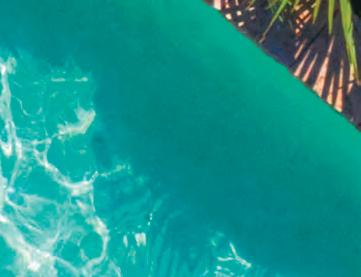




CONTEMPORARY COLLECTIONS
AFRICAN AMERICAN MASTERWORKS FROM THE PAUL R. JONES COLLECTION AT THE LSU MOA


Baton Rouge, Louisiana
Sixty paintings, sculptures, prints, and






//AUGUST 23 15
Sixty of the most influential works of contemporary art by Black artists are on display at the LSU Museum of Art as part of African American Masterworks from the Paul R. Jones Collection at the University of Alabama. Romare Bearden, Sorcerer's Village (1980, silkscreen), The Paul R. Jones Collection of American Art at the University of Alabama. Courtesy of the LSU MOA.
6/27/23 11:54
LAZY RIVER AT GOLDEN NUGGET LAKE CHARLES UnpackYourJoy.com
Events


Beginning August 4th
photographs by some of the country's most prominent Black artists will be on display at the LSU Museum of Art, on loan from The Paul R. Jones Collection at The University of Alabama. The Paul R. Jones Collection was founded with the intent of reinforcing Black artists' place of importance in the history of American art, and to allow younger generations access to their works. The show at the LSU MOA will include pieces by 20th century Black artists Sam Gilliam, Faith Ringgold, Jacob Lawrence, Howardena Pindell, Emma Amos, and Romare Bearden. An opening reception and concert will be held August 3, featuring a performance of Nina Simone classics by Chloé Marie at 6 pm. Free. lsumoa.org. •
AUG 4 th
HELPING OUR HEROES
VETERAN STAND DOWN
Opelousas, Louisiana
Veterans Point Louisiana presents its first annual Stand Down event, dedicated to providing quality of life services and resources to local homeless veterans. Free clothing, food, refreshments, and personal care items will be available, as well as services such as employment and training opportunities, health and wellness programs, housing resources, and counseling. 9 am–2 pm at the Yambilee Building in Opelousas. For details, call Veronica at (337) 6781094. veteranspointla.com. •
AUG 4 th
CAJUN MUSIC LEGACIES
FESTIVALS ACADIENS ET CRÉOLES LEGACY SERIES
Baton Rouge, Louisiana

Festivals Acadiens et Créoles continues its monthly Legacy Series, celebrating legendary local musicians and culture bearers with intimate concerts reminding audiences of their cultural contributions to Acadiana and beyond. Taking place on the first Thursday of the month at the Feed N Seed in Lafayette is "The Legacy of Clifton Chenier". 7 pm–9 pm. Free. festivalsacadiens.com. •
AUG 4 th
HISTORIC GROUNDS
VICKSBURG NATIONAL
MILITARY PARK FEE FREE DAY
Vicksburg, Mississippi
In honor of the anniversary of the Great American Outdoors Act,
visitors can enjoy free admission at the Vicksburg National Military Park at 3201 Clay Street. For more information, call (601) 636-0583. nps.gov. •
AUG 4th - AUG 6th
OPERATIC OGRES
PLAYMAKERS PRESENTS
SHREK THE MUSICAL JR.
Covington, Louisiana
An adaptation of the Dreamworks animated ogre-led fairytale love story is coming to the Playmakers Covington stage. $15–$30. Friday and Saturday at 7 pm, Sunday at 2 pm. bontempstix.com. •
AUG 4th - AUG 25th
MEALS ON WHEELS
FOOD TRUCK FRIDAY NIGHTS
Gonzales, Louisiana
Come enjoy nights of family fun at TRM Axe Throwing with an extensive lineup of vendors and performers including Summers Dawg Daze, Tre's Street Kitchen, Zora Christina Catering LLC, Wings on the run, Repicci's Italian Ice of Livingston, and Dee Be Chef. Free. 7 pm. visitlasweetspot.com. •
AUG 4th - AUG 25th
TASTY PARADES
FOOD TRUCK FRIDAYS AT OAK GROVE
Prairieville, Louisiana
On Friday evenings, folks flock to the Oak Grove Food Lot in Prairieville for live music, fun activities for all ages, and lots of local food trucks. 5 pm–8 pm. Free. visitlasweetspot.com. •

AUG 4th - AUG 26th
ICONIC VENUES
TIPITINA'S CONCERT SCHEDULE
New Orleans, Louisiana
The famous Tchoupitoulas venue continues bringing a wide variety of New Orleans’ favorite musical acts to Professor Longhair’s legendary stage. Here’s what’s happening:
August 4: Free Fridays Concert Series featuring Brass-a-Holics + Noah Young Band. 9 pm.
August 5: IKO Allstars. 9 pm.
August 11: Free Fridays Concert Series featuring Honey Island Swamp Band + Strange Roux. 9 pm.
August 12: Don B. and Friends: Unplugged. 8 pm.
AUGUST 23 // COUNTRYROADSMAG.COM 16
A Special Advertising Feature from the Arts Council of Greater Baton Rouge
Women Breaking Boundaries
Atthe2023LouisianaArtsSummit,renownedartsinnovatorsfromstageandscreenwillshowhow theartscanhelpsocietyandtheeconomyevolve.
Three nationally recognized women in the arts take the podium at this year’s Louisiana Arts Summit, introducing innovative ideas about how the arts done right can strengthen community. The annual summit will be held in October 4-6 at the Cary Saurage Community Arts Center in Baton Rouge. It was established in 2016 to promote the role of the arts in the regional economy and to connect artists and arts professionals with cutting edge ideas.
“We are so excited about this year’s summit and its dynamic panel of speakers,” said Arts Council of Greater Baton Rouge President and CEO Renee Chatelain. “The event is always about the business of the arts and is a great opportunity for networking. This year, we’re featuring three amazing women who are using their platforms to look at how the arts interpret important human events in both educational and civic settings.”
A national thought leader in creating a fiscally sustainable arts sector, Claire Rice will speak on building a stable financial infrastructure to support the arts. Rice serves as executive director of the statewide Arts Alliance Illinois.

“As we’ve come out of the pandemic, Claire speaks to the issue of seeing arts organizations get back on track and how we can use the arts to build and strengthen communities,” Chatelain said. “She will also discuss how innovative private-public partnerships can fuse the arts into different community challenges—even something as seemingly unrelated as traffic mitigation.”
Chatelain says artists and arts leaders will also leave the summit with new strategies for placing an appropriate market value on their time and work.
“Artists are typically so starved they’ll perform for pennies on the dollar, so it’s important to talk about fair wages,” she said.
The summit also features talks from national pioneers in the fields of theater and dance.


One is Garlia Cornelia Jones, a decorated New York City-based theater producer,
artist, photographer, and activist known for breaking barriers with her work in Black theater and in using digital platforms. Jones’ many accomplishments including being named the first ever director of innovation and new media at Off-Broadway’s The Public Theater in 2022.


“Using Tik Tok and other digital platforms is so key in interpreting world events and creating space for artists,” Chatelain says. “We’re really looking forward to hearing what Garlia has to say about this kind of work.”
Atlanta-based dance innovator Tracey Lang rounds out the three speakers and will share her experiences in challenging the physical space of the dance floor. While known for working in choreography, performance, and academia, Lang is also experienced at exploring AR and VR technology and other forms of collaboration that immerse audiences in powerful, transformative experiences.
The three-day summit’s talks, workshops, and programs will be held throughout the 12,000 square foot Cary Saurage Community Arts Center. Expect to find something dynamic going on in every corner of the building, from its conference rooms to the Virginia & John Noland Black Box Studio, and from the Shell Art Gallery on the first floor to the Turner-Fischer Rooftop Terrace overlooking downtown Baton Rouge.
Moreover, guests can enjoy a variety of arts related experiences downtown, including a Live After 5 outdoor concert on Friday, October 6, and a Geaux Bikes public art tour that guides visitors to some of Baton Rouge’s many public art installations on board an electric bike.
Taking place October 4—6, the Louisiana Arts Summit is presented by the Arts Council of Greater Baton Rouge in partnership with the Louisiana Division of the Arts. To learn more visit artsbr.org/louisiana-arts-summit.
//AUGUST 23 17
Garlia Cornelia Jones
Tracey Lang
Claire Rice
Events
Beginning August 4th - August 5th
August 18: Free Fridays Concert Series

featuring Billy Iuso + Vegas Cola. 9 pm.
August 19: Rebirth Brass Band. 9 pm.
August 20: Fais Do Do With Bruce
Daigrepont Cajun Band. 5:15 pm.
August 25: Free Fridays Concert Series
Presents Raw Deal: A Tribute to Earth, Wind, & Fire featuring Anjelika "Jelly"
Joseph + Zita. 9 pm.
August 26: 28 Years of Son Volt + Anders Parker. 9 pm.
Ticket prices at tipitinas.com. •
AUG 4th - AUG 31st
CREATIVE COMPETITIONS
HAMMOND ART GUILD
JUDGED EXHIBITION
Hammond, Louisiana
This annual judged exhibition at the Hammond Regional Arts Center continues the Hammond Art Guild's tradition of providing the Northshore with a display of art by some of the most talented creatives in the area. Pieces range from paintings, drawings, sculpture, jewelry, and more, with many available for purchase. This year's judge is Joshua Duncan, Executive Director of Twin Steeples Creative Arts Center. An opening
reception will be held August 4 from 5 pm–8 pm, during which guests will have the opportunity to vote on the People's Choice Award. A separate solo exhibition by Hammond Art Guild member Shanna D’Antonio, titled Beasts of a Season will simultaneously be on display upstairs in the Mezzanine Gallery. hammondarts.org.
AUG 5th
ARTISAN ANTICS
BATON ROUGE ARTS MARKET
Baton Rouge, Louisiana
Shop with artists from Louisiana, Mississippi, Texas, and Florida who will present original works of art in a variety of mediums including, pottery, jewelry, woodwork, textiles, photographs, glass, paintings, sculpture, hand-made soaps, and so much more. Performances will liven the market too, expanding what arts are on display. Don't leave the kids behind; a children's activity center is always set up between 8 am and noon. Held alongside the weekly Red Stick Farmers Market the first Saturday of each month from 8 am–noon at the corner of 5th and Main streets. Free. artsbr.org. •
AUG 5th
ARTY PARTIES
WHITE LINEN NIGHT
New Orleans, Louisiana
The New Orleans Arts District brings back its popular White Linen Night, transforming Julia Street's 300-600 blocks into one massive art party, with live music, cuisine and cocktails, and
exhibition openings throughout the Warehouse Arts District. Admission to the block party and art openings, held from 5 pm–10 pm, is free and cocktails and cuisine will be available for sale along Julia Street. Deck yourself out in your cleanest, chicest whites—and maybe put a Tide pen in your purse. Find the full roster of participating galleries at artsdistrictneworleans.com. •

AUGUST 23 // COUNTRYROADSMAG.COM 18
Don your coolest (in both senses of the word) white outfit and head to Julia Street in New Orleans's Warehouse Arts District for gallery openings at every turn, plus food and drink vendors set up in the street for the summer art party that is White Linen Night on August 5. Image courtesy of Arts District New Orleans.
AUG 5th
BACK-TO-COOL ASCENSION 4 YOUTH FEST
Donaldsonville, Louisiana
Kids and their adult counterparts can ensure they're ready for the school year with one last summer hurrah at the Wag Center, where there will be free food, a snow ball stand, music, stylists giving haircuts, uniform booths, arts and crafts, water activities, family services, immunizations, and giveaways for useful items such as backpacks and school supplies. 10 am–2 pm. Free. visitlasweetspot.com. •
AUG 5th
FRESH CATCHES
SEAFOOD AND FARMERS MARKET
Delcambre, Louisiana
First Saturday of every month, come show your support for wild-caught Louisiana seafood and locally grown, farm-fresh produce by shopping at the Delcambre Seafood and Farmers Market. Lots of fresh fare from area farms and local waters, tasting opportunities and recipes, live music, kids' activities, and various special events. 9 am–1 pm at Bayou Carlin Cove Boat Landing and Pavilion, 605 South Railroad Street. delcambremarket.org.
(800) 884-6120 ext. 7. •
AUG 5th
MUSICAL MOMENTS
ARTS COUNCIL OF POINTE COUPEE PERFORMING
ARTS SERIES: KIRK
SCHIEFLBEIN & FRIENDS
New Roads, Louisiana
The Arts Council of Pointe Coupee's annual Performing Arts Series for 2023 comes packed with high-energy musicians who have been favorites at the French Quarter Festival and Jazz Fest in New Orleans, as well as some strong regional vocalists who have come highly recommended by PAS patrons. This August, Baton Rouge musician Kirk Schieflbein will be playing alongside guests like former LSU professor of music Bill Grimes. 7 pm at the Poydras Center in New Roads. $29.25; $10.45 for students.
artscouncilofpointecoupee.org.
AUG 5th - AUG 6th
POPS PRESENTS
SATCHMO SUMMERFEST
New Orleans, Louisiana
This weekend festival dedicated to the memory of Louis Armstrong presents an extensive roster of performances by contemporary New Orleans musicians from many genres, paying homage to the musical and cultural legend. Bands coming
to play read like a who's who of traditional and contemporary jazz and brass bands; plus there's children's programming, seminars, special events, and tasty food, too. The two main stages are located at the Jazz Museum in the Old US Mint, 400 Esplanade Avenue. Daily admission $7 in advance, $10 at the door. satchmosummerfest.org. •
AUG 5th - AUG 6th
BIG LITTLE CONVENTIONS
MID CITY MICRO CON
Baton Rouge, Louisiana
Celebrate the brilliance of imagination and diversity with the Main Library's sixth annual Mid-City Micro Con. Enter into fantastical worlds and interact with comic book characters, creators, and fellow fans. Special events will include a panel on world building, acrobatic performances by The Acadian Circus, a panel on representation in pop culture, a live video game tournament, and more. All culminating—naturally—in a cosplay competition for teens and adults. 11 am–5 pm Saturday; 2 pm–7 pm Sunday. Free. For a full schedule of events, visit ebrpl.com/mcmc. •
AUG 5th - AUG 9th
BATON ROUGE'S NEW BATON BRSO'S MEET THE MAESTRO
Baton Rouge, Louisiana
As part of Symphony Week, the Baton Rouge Symphony Orchestra is hosting a variety of fun outings to allow audiences to get better acquainted with their new Music Director, Maestro Adam Johnson from Montreal. Meet him for yourself at one of these events:
August 5: Dinner at City Club of Baton Rouge, followed by a Celebration Concert in LASM's planetarium. 5:30 pm–10 pm. $150.
August 7: Music Trivia Night at the Cary Saurage Community Arts Center.
6:30 pm–8:30 pm. Free.
August 8: Golf Night at Golf Suites.
7 pm. $50 single or $200 for four golfers.
August 9: Symphony of Flavors tasting at Martin's Wine Cellar. 5:30 pm–7 pm. $50.
brso.org. •

AUG 5th - AUG 19th
CASINO CONCERTS SUMMER SHOWS AT L'AUBERGE
Baton Rouge, Louisiana
Here's the shows you can catch coming up at L'Auberge, when you want a safer bet than playing the slots:
August 5: Craig Ferguson. 8 pm. $25.
August 19: Don Felder. 8 pm. $30. lbatonrouge.com. •
//AUGUST 23 19
•
Events


Beginning August 5th - August 6th
AUG 5th - AUG 26th
FRESH FINDS
LAFAYETTE'S HUB CITY FARMER'S MARKET
Lafayette, Louisiana
Peruse local Acadiana vendors at the weekly Hub City Farmer's Market in Lafayette, held every Saturday in the Oil Center from 8 am–noon. Expect on offer pastured beef, pork, chicken, duck, and turkey—as well as dairy, raw honey, and bushels of fresh produce. Not to mention baked goods, seasoning blends, pickles, and other delightful locally-made products. hubcityfarmersmarket.com. •
AUG 5 th - AUG 26 th
PRODUCE PARTIES
MANDEVILLE TRAILHEAD COMMUNITY MARKET
Mandeville, Louisiana
One of the Northshore's most popular markets, bursting at the seams with local goodies from around the region. Find everything from artisan food products to fresh produce to jewelry and arts and crafts—frequently with
live music and fresh food to make for a lovely Saturday morning. Held every Saturday at the Mandeville Trailhead from 9 am–1 pm. cityofmandeville.com. •
AUG 5th - AUG 26th
DECK DANCING
SATURDAY LIVE MUSIC
AT THE GIDDY UP
Folsom, Louisiana
Local live bands play on the deck every Saturday afternoon at The Giddy Up, weather permitting. 2 pm–4 pm. Free. giddyupfolsom.com. •
AUG 5th - AUG 26th
COSMIC CONNECTIONS
SATURDAY STARGAZING AT LASM
Baton Rouge, Louisiana
Each weekend, you can experience stargazing during the day under the grand dome of LASM's planetarium. Learn fascinating facts about the stars and constellations in the local night sky during an interactive presentation, then enjoy a featured show for all
ages. Each week, you can even collect a new constellation trading card by clicking here. Cost included with the price of general admission and free for members. Every Saturday at 10 am. lasm.org. •
AUG 5 th - AUG 26 th
VEGGIES & CRAFTS
LAFAYETTE FARMERS & ARTISANS MARKET
Lafayette, Louisiana
Every Saturday, Acadiana's vibrant scene of local makers and farmers convene in the community gathering space of Moncus Park. Browse locallygrown produce, freshly prepared foods, and creative one-of-a-kind works by local artists. 8 am–noon. marketatmoncuspark.com. •
AUG 5 th - AUG 31 st
CRESCENT CITY CREATIVITY ON DISPLAY AT ARIODANTE
GALLERY IN AUGUST
New Orleans, Louisiana
Ariodante Art Gallery on Julia Street in New Orleans continues to cycle in fresh artists and their creations into the summer months. August's featured artist is Amy Sartin Carlisle, and other works include crafts by Gary Schiro, jewelry by Lisa Normand, and
other artwork by Kay Richoux in the Lagniappe Area. An artist reception will be held in conjunction with White Linen Night on August 5 from 5 pm–9:30 pm. ariodantegallery.com. •
AUG 6 th
ART & SCIENCE SUNDAY
LASM FREE FIRST SUNDAY
Baton Rouge, Louisiana
Every first Sunday of the month, guests can enjoy free admission to all art galleries, family activities, and for the first time even planetarium shows at LASM. Stop by with your family, or introduce the museum to your friends as one of Baton Rouge’s most beloved attractions. 1 pm–5 pm. 100 River Road South. lasm.org. •
AUG 6 th
ARTFUL OUTINGS
LSUMOA FREE FIRST SUNDAY
Baton Rouge, Louisiana
This month, First Free Sunday attendees can check out the current exhibition African American Masterworks from the from the Paul R. Jones Collection at The University of Alabama, create a work of art of their very own, or bring home an art kit for the kids. 1 pm–5 pm. Free. lsumoa.org. •
AUGUST 23 // COUNTRYROADSMAG.COM 20
Material World (of Sound)
THE HISTORIC NEW ORLEANS COLLECTION’S 2023 ANTIQUES FORUM PRESENTS NEW ORLEANS’S MUSIC HISTORY THROUGH OBJECTS
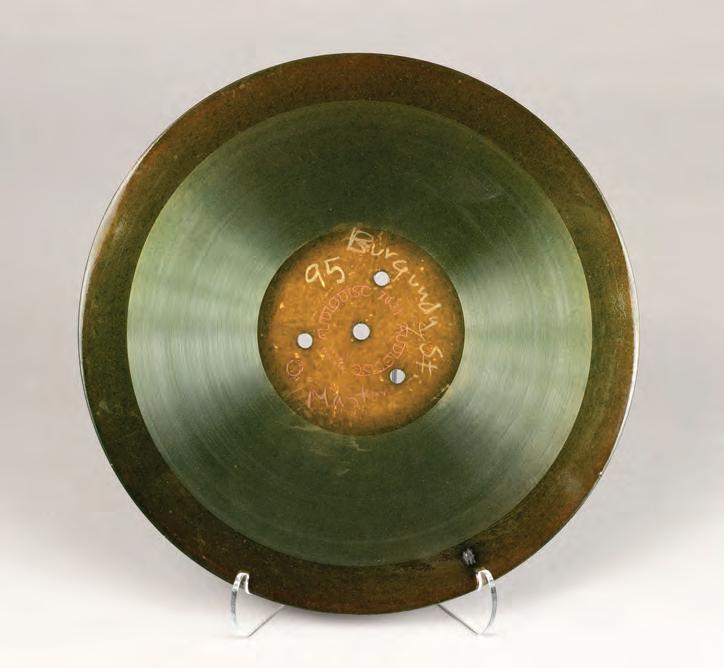 By Alexandra Kennon
By Alexandra Kennon
Picture it: an old Hohner accordion, squeezed and stretched by The Boswell Sisters trio back in jazz’s golden age. Yellowed dance cards left behind from a Mardi Gras ball, now decades past, still marked with pencil from the whirlwind night. A rare image of ragtime cornetist and jazz founding father Buddy Bolden—the only photograph of him remaining in existence. A 1944 recording of the George Lewis Trio’s 1940s hits “Burgundy Street Blues” and “I Can’t Escape from You”— pressed not into vinyl, but glass. A precious clarinet, once held to the lips of jazz great Sidney Bechet.

Each of these astoundingly-rare objects has had a life and story of its very own, an important part of the larger tapestry of New Orleans’s rich music history. This August, these items and many others will be carefully-yet-enthusiastically contextualized by experts as part of The Historic New Orleans Collection’s 2023 Antiques Forum—and brought out on display as part of the Backstage at the Museum(s) “show and tell” event the Thursday before the big weekend.
“Music is so important, obviously, to New Orleans and this region,” said Amy Williams, manager of programs at THNOC. “So we just thought it would be really fun to tell the history of music in our region, through the objects around music.”
THNOC is comprised of three parts: it functions as a publisher, a museum, and a research center—the latter includes “a million objects,” according to Williams. “It's the community's collection; we’re holding it for them,” Williams explained, noting that the collection is open to the public, and that anyone can come into the Reading Room with an appointment and access the objects stored there with the assistance of archivists, interpreters, and other staff. But for the annual Antiques Forum, some of THNOC’s most important items are highlighted by scholars under a unified theme—a continuation of THNOC’s efforts to better connect their holdings to the community they serve.
“ What we're doing is getting our curators to pick the things that they feel are most important to helping tell the musical culture of our city—pulling them all together at one time, which is a really rare
to authors, to historians, to musicians—even anthropologist and American Routes radio host Nick Spitzer is on the docket. With so many perspectives on Louisiana’s musical legacy lined up, Williams
conference,’” Williams said. “So it was really fun, you know, to try to narrow down the stories that we could tell because of the objects.”
Among the topics discussed will be major tenets of New Orleans music history, like its once-elaborate opera scene and parlor culture; alongside lesser-known facets of rural Louisiana music, like the Easter Rock tradition of a North Louisiana church that holds an allnight vigil the night prior to Easter.
"Easter Rock is this amazing tradition that the NEA just recognized and is dying, really,” Williams explained. “And it's just this glorious tradition that we didn't know a lot about, and wanted to be sure that we are sharing that when we're talking about the culture of music and our city.”
This year’s Antiques Forum will be different from years past, incorporating new types of media to illustrate and unpack the historical subjects covered. That includes a documentary hosted by Spitzer about Louisiana’s unique handmade vernacular instruments, like the diddley bow and cigar box guitar, titled Porch and Dancehall Culture: Louisiana’s Homemade Instruments. Another highlight, according to Williams, will be a talk with music and fashion author Holly GeorgeWarren about early country and western costuming in the South. Grammy-winning Cajun musician André Michot, of Les Fréres Michot and Lost Bayou Ramblers, will also present a talk on accordion building, followed by a courtyard performance at Friday’s Champagne Reception.
“I can't even stop smiling,” Williams effused. •
opportunity for folks to be able to come in and see them all together with our curators talking about them, and explaining why they're so important,” Williams explained. “So as you can tell, I'm super excited about this.”
The slate of speakers have a broad range of backgrounds, from curators, to musicologists,
said that the objects themselves provided helpful parameters for what stories will be told.
“ We constantly had to remind ourselves and our speakers: ‘ You have to tell the story through the items and the objects. People aren't coming to an ethnomusicology conference, they're coming to a material culture
This year, THNOC is making the Antiques Forum more accessible to the community by offering individual day tickets ($150 for Friday or Saturday, $50 for Sunday), as well as a Young Professionals rate of halfpriced single-day tickets. Tickets for the full Forum are $300. Find the full schedule of lectures, brunches, cocktail parties, and more at hnoc.org.
//AUGUST 23 21 ANTIQUES
UNPACKED
Top: Glass master recording of the George Lewis Trio’s “Burgundy Street Blues” and “I Can’t Escape from You”; 1944; recorded by Bill Russell for American Records; THNOC, gift of GHB Jazz Foundation, 2022.0108.2.1, © GHB Jazz Foundation. Bottom: The Boswell Sisters’ accordion; between 1900 and 1950; by Hohner, manufacturer (Trossingen, Germany); THNOC, gift of the Boswell Museum of Music, 2011.0315.251
Events

Beginning August 6th - August 7th
AUG 6th
OLD SCHOOL
BEHIND THE BARN DOORS AT THE WEST BATON ROUGE MUSEUM
Port Allen, Louisiana
The West Baton Rouge Museum's monthly "Behind the Barn Doors" event draws guests to the Big Red Barn on the museum's six-acre campus to learn more about traditional crafts and historic trades. Each month, artisans in the fields of blacksmithing, milling, woodworking, spinning, weaving, and more will offer demonstrations and workshops on the history and enduring practice of their trades. August's event will focus on forging and playing the t'fer (led by Ben Deshotels), woodworking (led by Gary Hart), and weaving Acadian brown cotton (led by Linda Collins). 2 pm–5 pm. Free. westbatonrougemuseum.org. •
AUG 6th
JAM SESSIONS
JAMBALAYA ACOUSTIC MUSIC JAM
Arnaudville, Louisiana
Every first Sunday at Arnaudville music
and repair shop Tom's Fiddle & Bow, they stop repairing and selling instruments and pick them up to play instead. Swing by for the JAMbalaya Acoustic Music Jam from 1 pm–4 pm. Free. tomsfiddleandbow.com. •
AUG 6th
CRAFTS & CRAFT BEER BEER GARDEN POP UP MARKET
Baton Rouge, Louisiana
More than a dozen creative local artists and makers will have their handmade creations displayed for sale, alongside brunch and craft beer at Baton Rouge's Mid City Beer Garden. 11 am. Free. Find the event on Facebook for more information. •
AUG 6th - AUG 10th
KEEPIN' IT CLASSICAL BRSO SYMPHONY WEEK
Baton Rouge, Louisiana
For a full week, the Baton Rouge Symphony Orchestra will offer free pop-up concerts at noon in various locations throughout Baton Rouge. Here's where to find them:
August 6: Perkins Rowe Center Fountain
August 7: Main Library on Goodwood
August 8: Main Street Market
August 9: Pennington Biomedical Research Center

August 10: North Boulevard Town Square
All at noon, all free. brso.org. •

AUG 6th - AUG 27th
TWO STEPPIN' BAL DU DIMANCHE
Lafayette, Louisiana
Vermilionville’s Bal du Dimanche (Sunday Dance) provides a weekly opportunity to let your legs lead the way through Cajun and zydeco rhythms from some of the area’s finest musicians.
1 pm–4 pm at the Vermilion Performance Center, 300 Fisher Road. All ages welcome, and refreshments are available. $10. vermilionville.org. •
AUG 6th - AUG 27th
MUSIC ON THE BAYOU CAJUN AND ZYDECO JAM AT BAYOU TECHE BREWING
Arnaudville, Louisiana
Sundays draw the musicians to the Teche—where craft beer compliments the sounds of Cajun and zydeco. Come out to Bayou Teche Brewing for front porch jams, wood-fired pizza, and eco-
friendly microbrews made with local ingredients. Bring your own instrument and your dancing shoes, and join in on the celebration of heritage. Zydeco from 11 am–1 pm, Cajun from 2 pm–5 pm. Free. bayoutechebrewing.com. •
AUG 6th - AUG 27th
MARKET VALUE
ABITA SPRINGS ART & FARMERS MARKET
Abita Springs, Louisiana
Fresh produce, locally-raised poultry, justcaught fish, local art, and the quintessential charm of Downtown Abita Springs—it can all be yours, every Sunday, rain or shine. Live music sets the scene from noon–3 pm. townofabitasprings.com. •
AUG 7th
LOCAL STAPLES
UNITED WAY OF SOUTHEAST
LOUISIANA WEST ST.
TAMMANY RED BEANS 'N' RICE
COOK-OFF
Covington, Louisiana
United Way will be celebrating the grand tradition of red beans on Monday for a good cause at their annual all-you-can-eat Red Beans ‘N’ Rice Cook-Off in the Slidell Auditorium. Proceeds will support suicide prevention, mental health services, and other programs offered by United Way in St. Tammany Parish.
AUGUST 23 // COUNTRYROADSMAG.COM 22
Learn more: www.pbrc.edu @pbrcnews @penningtonbiomed @PenningtonBiomedical Unlock a Healthier Future Join a clinical trial at Pennington Biomedical! Clinical trials are part of scientific research and at the heart of all medical advances. Pennington Biomedical offers clinical trials that cover topics such as weight-loss, diabetes, cancer, nutrition, and healthy aging. Compensation is provided for trial participants. www.pbrc.edu/clinicaltrials 225-763-3000 6400 Perkins Road, Baton Rouge, LA 70808
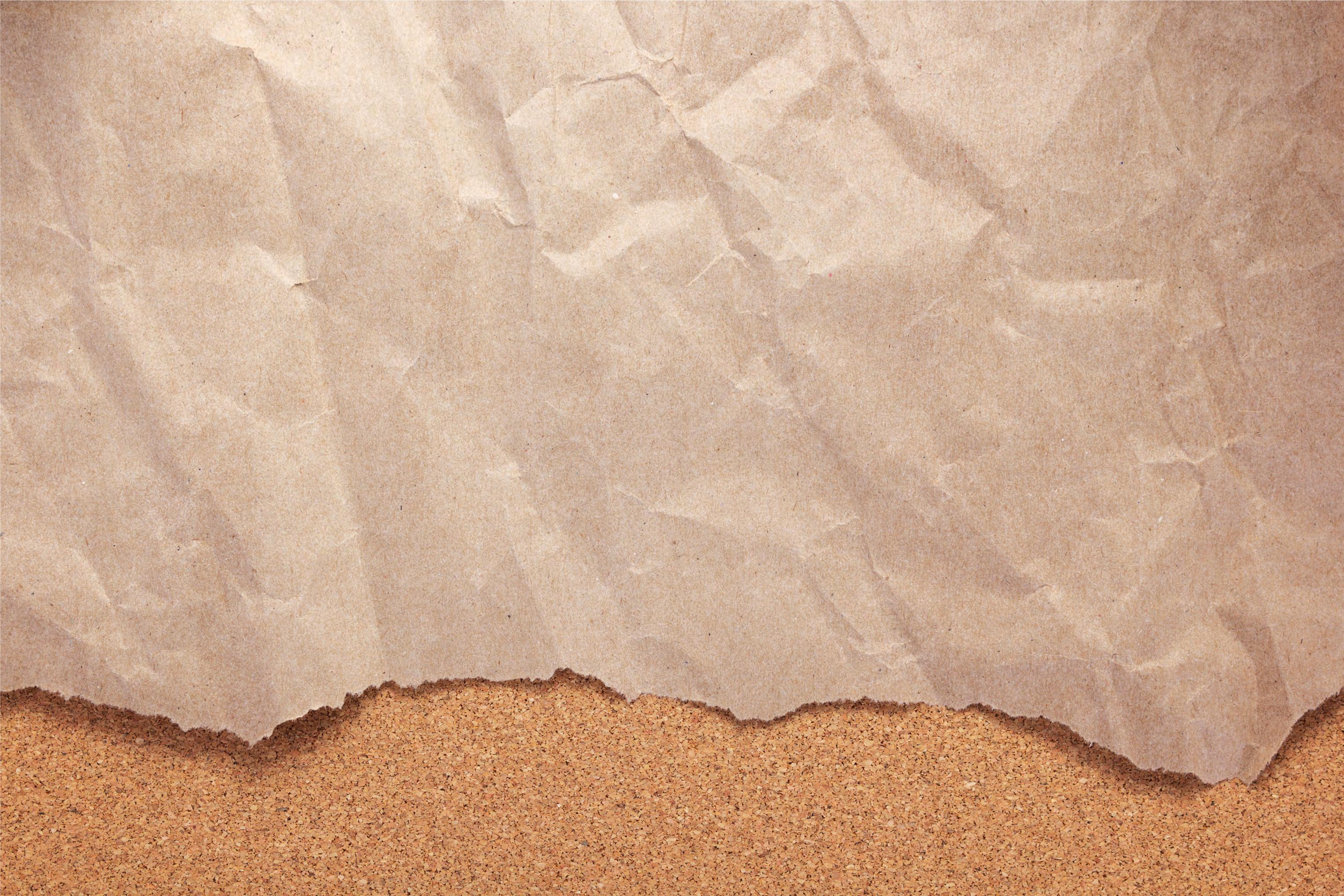


//AUGUST 23 23
Events
Beginning August 7th - August 11th
11 am–2 pm. $10 for all-you-can-eat red beans. unitedwaysela.org. •
AUG 7th - AUG 28th
MUSICAL MONDAYS
CITÉ DES ARTS MONDAY
BLUEGRASS JAM
Lafayette, Louisiana
Know a little bluegrass? Or a lot of bluegrass? Meet other players and dabblers alike at Cité des Arts' weekly Bluegrass Jam, held every Monday evening. All ages and experience levels welcome. 6:30 pm–10 pm. Free. citedesarts.org. •
AUG 7th - AUG 28th
DANCIN' SHOES
ZYDECO DANCE LESSONS
Opelousas, Louisiana
Festivals every which way you turn... but are you bringing your all? Holy Ghost Catholic Church in Opelousas kindly offers free zydeco dance lessons every Monday to assist you in making the most of celebrations all year long. Just bring leather-soled shoes, a partner, and a positive attitude. 6 pm–7 pm in the Cafeteria. 747 Union St. Opelousas.
Contact (337) 842-2732 for more information. •

AUG 8th - AUG 11th
FUTURE BALLERINAS
TIPPY TOES DANCE WORKSHOP
Baton Rouge, Louisiana
Pulse Dance Studio has teamed up with the East Baton Rouge Parish Library this summer to present the free dance program, Tippy Toes Dance Workshop. For small children ages three to seven who are interested in being introduced to the art of dance, the workshop will feature basic movements, feet positioning, and a short routine. 4 pm–6 pm both days (Tuesday and Friday). Register at (225) 274-4460. ebrpl.com. •
AUG 8th - AUG 26th
CREATIVE CLASSES
AUGUST AT CREATE STUDIOS
Baton Rouge, Louisiana
Whether you're brimming with ideas but can't paint within the lines, or you need a shove into the deep end of artistic inspiration—Create Studios, located at
546 Bienville Street in Baton Rouge's Capital Heights neighborhood, is the place to brush up. Here's what you can learn in August:
August 8: Blue Dog Your Dog. $55–$130
August 11: Resin Geode. $89.99–$99.99
August 12: Wine Glass Painting. $34–$37
August 17: Metal Stamped Jewelry. $42.50–$50
August 18: Mosaic Stained Glass. $55.
August 19: Oceanscape Resin Art. $75.99–$99
August 25: Broken Jewelry Resin Art. $39.99–$69.99
August 26: Resin Jewelry. $53.99–$59.99 evenbrite.com for more information. •
AUG 9th
HEARTH HOPPING
VIRTUAL GALLIER GATHERING: THE EVOLUTION OF THE GREAT AMERICAN KITCHEN Online
For its next virtual Gallier Gathering, the Hermann-Grima + Gallier Historic Houses are hosting a Zoom talk with architectural and culinary historian John Ota. Ota is the author of the best-selling book The Kitchen, which walks readers through history seeking the perfect North American kitchen while unpacking the roles of such spaces and the ways men,
women, and food culture interact with them. 6 pm. Free. Register at eventbrite.com. •
AUG 10th
STRINGING ALONG
JAZZ LISTENING ROOM: CHARLIE RAUH
Baton Rouge, Louisiana
New York City-based composer and guitarist Charlie Rauh will perform at the Cary Saurage Community Arts Center's Roland Black Box Studio as part of the Arts Council of Greater Baton Rouge's Jazz Listening Room Series. 7:30 pm. $20 at bontempstix.com. Details at artsbr.org. •
AUG 10th - AUG 13th
DELTA BLUES
SUNFLOWER RIVER BLUES & GOSPEL FEST
Clarksdale, Mississippi
Visit Clarksdale presents the Sunflower River Blues & Gospel Fest, a musicfilled weekend right in the heart of Blues Country. Some of the performances include the Delta Blues Museum Band, Jaye Hammer, Bill Abel, Terry "Harmonica" Bean, Mark "Mule Man" Massey, Christone "Kingfish" Ingram, The Sons of God, and many more. Friday 7 pm–12:15 am; Saturday 10 am–1:30 am; Sunday 3 pm–9:45 pm. VIP Sponsors are invited to a Grits,
AUGUST 23 // COUNTRYROADSMAG.COM 24
Get your week started right with some two-steppin' to Cajun and zydeco favorites at Vermilionville in

Greens & BBQ party on Thursday night to kick it all off, featuring music by Stan Street & Jaxx Nassar, Sean "Bad" Apple, and Deak Harp. Free. Visit sunflowerfest.org for the full lineup. •
AUG 11 th
CREATIVE COMMUNITIES
UNCORKED ART WALK
Sunset, Louisiana
Sip in Sunset with the locals for the Uncorked Art Walk. Galleries along Napoleon Avenue—including Artworks by Ted Bertrand, boho, The Funky Flea, and Jerilyn's Fused Glass Art Gallery—will be open for viewing and shopping, with many of the artists present to discuss their work. Café
Josephine will provide wine and horsd'oeuvres at each gallery. 6 pm–9 pm. Free. (337) 662-6222. •
AUG 11th
A SIDE OF CULTURE
A TASTE OF VICKSBURG
Vicksburg, Mississippi
Head to the Vicksburg Convention Center for a celebration of all things Vicksburg. Each monthly event features local entertainers, artists, or history buffs who will share highlights of Vicksburg's rich culture and history. This month, meet author and journalist Jordan Rushing. $15 includes a meal and the potential to take home door prizes. Tickets can be purchased at the Vicksburg Convention Center Box Office. (601) 630-2929 or erinp@vicksburg.org. •
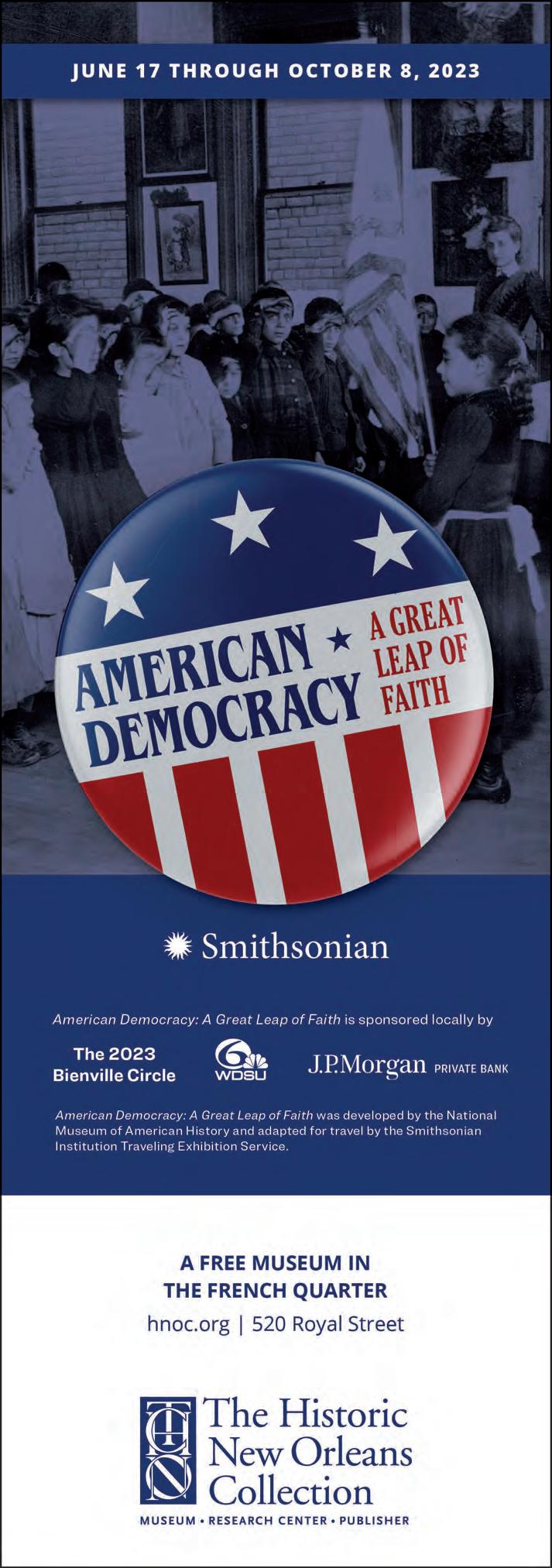
AUG 11 th
GIRL GROUPS
THE SHINDELLAS AT MID CITY BALLROOM
Baton Rouge, Louisiana
The Nashville girl pop vocal group
The Shindellas will perform a special
set at Mid City Ballroom. 8 pm. $15. bontempstix.com. •
AUG 11 th - AUG 12 th
VIVA LA VIVALDI
BRSO PRESENTS VIVALDI'S THE FOUR SEASONS
Baton Rouge, Louisiana
Enjoy an intimate Candlelight Concert presented by the Baton Rouge Symphony Orchestra at the Cary Saurage Community Arts Center, featuring Vivaldi's The Four Seasons (just because Louisiana's only two are "summer" and "not summer" doesn't mean we can't dream). 6:30 pm performances are sold out, 8:30 pm still available. $30–$55. brso.org. •
AUG 11 th - AUG 13 th
WITCHY BUSINESS NEW ORLEANS HEXFEST
New Orleans, Louisiana
This weekend, at the Bourbon Orleans Hotel convenes a community of New Orleans's witches, rootworkers, Voudou priests, and other magical folks from around the world. As the crossroads of Voodoo, Hoodoo, Witchcraft, and Christianity, New Orleans—the French Quarter in particular—has long been associated with spiritual power. For this special "Weekend of Witchery" presented by Brian Cain, Christian Day, and the Witches of New Orleans—forces align for a study and celebration of the city's spectrum of mysticism. The conference opens with a Riverboat Ritual and dinner held on an authentic steamboat on the Mississippi River, followed by two full days of workshops, drumming, and ritual. Between workshops and presentations by guest speakers, attendees can
//AUGUST 23 25
Lafayette's weekly Bal du Dimanche, or Sunday Dance. Pictured are RJ & Zydeco Smoove playing Vermilionville's Bal du Dimanche in fall of 2021. Photo by David Simpson. See listing on page 22.
Events

Beginning August 111h - August 12th

shop on-site powerful ritual tools, signed books, exquisite jewelry, and spellcrafts. $150 for day passes; $350 for full weekend with Riverboat ritual dinner. hexfest.com. •
AUG 11 th - AUG 15 th
EMERALD SCREEN

IRISH FILM FESTIVAL
Baton Rouge, Louisiana
May the road rise to meet you en route to Celtic Studios, where the annual Irish Film Festival makes Celts of us all. From full-length feature film screenings, to short films, to Irish Pub Night at Phil Brady's and beyond, this festival promises plenty of excuses to romanticize the Emerald Isle from Baton Rouge. $15 for three screenings. Find the full schedule of events and more information at batonrougeirishfilmfestival.com. •
AUG 12 th
GOOD TIMES & GOOD CAUSES
NEW ORLEANS
RED DRESS RUN
New Orleans, Louisiana
Scarlet-garbed runners flex their inner
vamps in this year's Red Dress Run. Sponsored by the Hash House Harriers, a self-proclaimed "drinking club with a running problem," the event offers not just a chance to imbibe in scarlet finery and unlimited beer, but to also support a good cause, with proceeds supporting more than one hundred local charities. Hashers are offered special red-themed running events like the Red Lingerie Run on Friday night and the Hangover Run on Sunday. This year's run begins at the corner of N Peters and Marigny Streets at 9 am and heads into the French Quarter. $65 to register at nolareddress.com. •
AUG 12 th
SHOP LOCAL SHOP ST. DENIS FEST Natchitoches, Louisiana
Louisiana's oldest settlement is proving it knows how to party at Shop St. Denis Fest—a block party along the Cane River on Front Street featuring live music, food trucks, and other local vendors. 10 am–5 pm. Free. natchitoches.com. •
Celebrating 40 Years of
AUGUST 23 // COUNTRYROADSMAG.COM 26
AUG 12 th
MEET THE ARTIST VISUAL ARTISTS DAY: SEE, MEET, AND VISIT
Arnaudville, Louisiana
On the second Saturday of each month, NUNU Arts and Culture Collective celebrates the work of a Deux Bayous exhibiting artist, while inviting the public to meet them in person and engage directly with their work. 11 am–4 pm. Free. nunuaccollective. homesteadcloud.com. •
AUG 12th
ADOPT AND SHOP
SECOND SATURDAY MARKETPLACE AT GIDDY UP FOLSOM
Folsom, Louisiana
Peruse local crafts and handmade goodies to a soundtrack of live music from the Northshore Traditional Music Society in the Paddock at Giddy Up Folsom. Maybe even bring home a new furry friend to complete your household, as the market will double as a St. Tammany Humane Society Adoption Event. giddyupfolsom.com. •
AUG 12th
LIGHT UP HUMOR
THE GLOW SHOW WITH JOEY Z
Lafayette, Louisiana
Experience the distinctly-unique touring comedy variety show by Austin-based comedian and entertainer Joey Z that the Austin Chronicle called "a definite must-see". From the light-up set to other audience members armed with glow sticks, Joey Z immerses viewers into a psychedelic glowscape as he recounts tails from parties and other misadventures. 8:30 pm. $15 in advance, $20 at the door. lafayettecomedy.com. •
AUG 12th
GOING UP
ZACHARY REALLY HOT AIR BALLOON FESTIVAL
Zachary, Louisiana
This new Zachary festival won't be all hot air—because in addition to the colorful, soaring balloons dazzling spectators and offering tethered rides, there will be food vendors, live music by the Eddie Smith Band, artisan vendors, kids' games, and other fun in Zachary Community Park. 4 pm–10 pm. Free. Visit their Facebook page for more information.
AUG 12 th
LOCAL HISTORY ALIVE WOMEN OF OAKLEY TOUR
Saint Francisville, Louisiana
A special tour curated by Audubon
Oakley House State Historic Site
Interpretive Ranger Michaela Brown traces the lives of five women who lived on the property where Audubon once painted his Birds of America —from Silvia Freeman, who was born into slavery in 1855 and remained a cook at Oakley even after she was freed in her youth; to Audubon's pupil Eliza Pirrie. This month, the tour will be offered at 11:30 am, 1:30 pm, and 3:30 pm. $10 adults, $8 seniors, $6 students. lastateparks.com.
Read more about the Women of Oakley tour in Alexandra Kennon's story on page 31. •
AUG 12 th
CREATIVE ACADIANA DOWNTOWN LAFAYETTE ARTWALK
Lafayette, Louisiana
ArtWalk showcases the creative side of Downtown Lafayette’s cultural district. Museums, independent galleries, studios, craft stores, and art houses of the downtown area all participate in the monthly showcase of Acadiana’s artistic talent. ArtWalk takes place every second Saturday of the month—rain or shine. There is no one organization responsible for planning the activities. Instead, each museum, gallery, or studio hosts their own unique event, featuring local artists and performers. facebook.com/ artwalk.downtownlft. •
AUG 12 th
LEAF IT TO THE EXPERTS GARDEN DISCOVERIES SERIES: WHAT TO DO IN YOUR VEGETABLE GARDEN IN AUGUST
Baton Rouge, Louisiana
LSU AgCenter Horticulturalist
Kathryn “Kiki” Fontenot will lead a lesson on how to get the most delicious, healthiest vegetables out of your home garden—yes, even in the heat of August. 10 am at the Main Library on Goodwood. Free. ebrpl.com. •
AUG 12 th
GREEN THUMBS
BOTANIC GARDEN SUMMER PLANT SALE AND EXPO
Baton Rouge, Louisiana
Could your garden use a refresher following this heat wave? Find a wide variety of summer plants for sale at the twenty-second annual BREC Botanic Gardens Summer Plant Sale. Daylilies, irises, ginger lilies, butterfly plants, herbs, roses, fruit trees, and more will be available for you to take home and plant. Proceeds go toward the development of the Botanic Garden.

//AUGUST 23 27
•
Events
Beginning August 12th - August 15th
8 am–noon. Find the Baton Rouge Garden Club on Facebook for more information. •
AUG 12th
ACCESSORIZING
CHAPEAUX PARTY AND TEA AT THE COTTAGE CAFE
Central, Louisiana
Join Chapeaux designers Karla and Jenn to learn the process of designing and creating your own festive fascinator—
AUG 13th
THROWBACKS
OLD TIME MUSIC OPEN JAM AT THE WBR MUSEUM
Port Allen, Louisiana
On the second Sunday of each month, musicians of all varieties and abilities are invited to the West Baton Rouge Museum for an Old Time Music Open Jam. Bring your guitars, basses, fiddles, dulcimers, and even your triangles to the
activities including live music, art, cooking, accordion construction and repair, spinning and weaving, wood carving, and more. Free. 10 am–5 pm at 300 Fisher Road. vermilionville.org. •
AUG 13th - AUG 27th
LOCAL LITERATURE CASEY E. O’BANION DEBUT NOVEL TOUR
Baton Rouge and New Orleans, Louisiana
C.E. O'Banion's debut novel Chinese New Year follows a retired literature professor living in Baton Rouge as he navigates the pains of moving into a semi-independent senior community—along with the robotic
AUG 14th - AUG 16th
GALLERY HOPPING LE DEUXIÈME: ARTS IN ACADIANA ALL WEEKEND LONG
Arnaudville, Louisiana
In Acadiana, the second weekend of the month is dedicated to the arts. Plan your trail, or take in bits and piece of the various celebrations of local art taking place along the Corridor des Arts from Lafayette to Arnaudville and in surrounding towns. Start on Fridays at the Sunset "Uncorked" Artwalk— when galleries along Napolean Avenue will be open for viewing and shopping, with many of the artists present to discuss their work. Saturday during the day, travel along the ArnaudvilleDeux Bayous Cultural District, making time for special stops at The Hive Marketplace, The Kitchen Shop, and NUNU Arts & Culture Collective— where you're just as likely to find artists putting on demonstrations, workshops, or gathering to tell stories. At St. Luc French Immersion Cultural Campus, take part in cultural language and history tables, geneaology workshops, and tradition workshops like quilting. Then, make it back in time for Lafayette's grand ArtWalk downtown, showcasing the city's creative cultural district—including museums like the Acadiana Center for the Arts, craft stores, galleries, and various independent artists who all come out •
FÊTE DIEU DU TECHE BOAT PROCESSION
Along Bayou Teche, Louisiana
determined to keep their Prom night vow to be bridesmaids at each other's weddings no matter what comes to the 30 by Ninety stage. 8 pm Friday and Saturday, 2:30 pm Sunday. $14–$22. 30byninety.com. •
AUG 13 th
UNIQUE VENUES
STOP THE CLOCK COWBOY JAZZ AT THE FEED N SEED
Baton Rouge, Louisiana
Every second Sunday of the month is a day for cowboy jazz at the Feed N Seed Lafayette. Join local musicians from the Stop the Clock Cowboy Jazz band for a monthly hee haw on the dance floor. 6 pm. $10. Details on the Feed N Seed Lafayette Facebook page. •
in genres like folk, Cajun, country, gospel, and bluegrass. Free. 3 pm–5 pm. westbatonrougemuseum.com. •
AUG 13th
EMBRACING HERITAGE ACADIAN CULTURE DAY
Lafayette, Louisiana
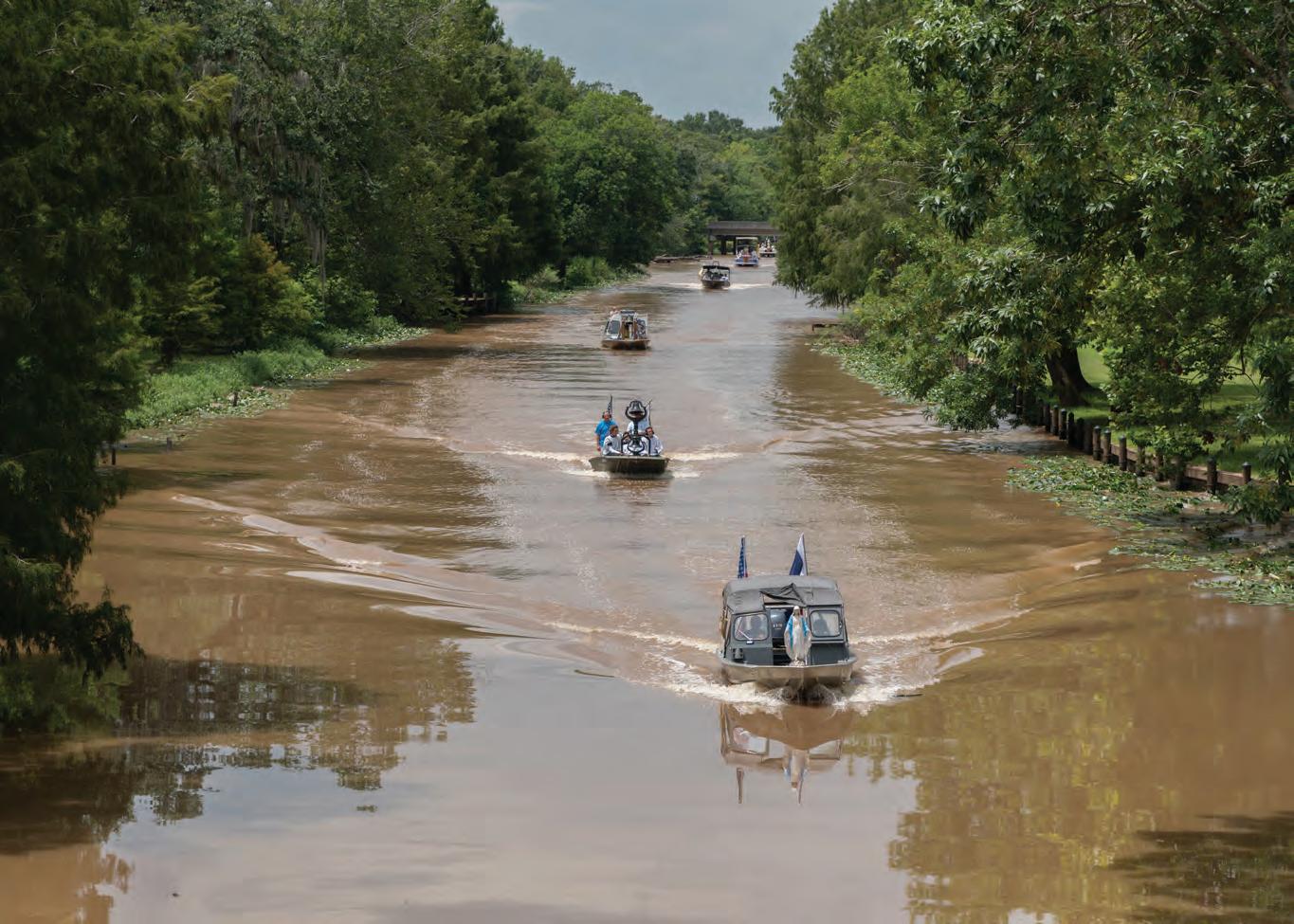
Over 250 years of rich cultural heritage will be celebrated at Vermilionville during its Acadian Culture Day. The day will focus on family folklore and
with the territory. Oh yeah, it's also set in the distant future, "for no apparent reason," its author admits. Chat with the author and have him sign a copy of his eccentrically-humorous first fiction release at the following signing events:
August 13: East Baton Rouge Parish Library (On Independence). 2 pm.
August 27: Blue Cypress Books in New Orleans. 1 pm. Free. ebrpl.com. bluecypressbooks.com. •
On August 15, Catholics worldwide celebrate the Feast of the Assumption. In Acadiana, though, the date is also celebrated as the anniversary of the arrival of the French Canadian immigrants who brought this faith to Louisiana after years of great trials and suffering. In celebration, a Eucharistic procession takes place along Bayou Teche from Leonville to St. Martinville, retracing the voyage of the Acadians from Canada over 250 years ago. During this procession, fifty boats will disembark at 9:30 am and travel along Bayou Teche. The fortymile procession will make several stops along the way for a recitation of the rosary and Benediction of the Blessed Sacrament. Families and individuals are encouraged to register a boat or gather to observe from one or more of the stops along the banks of the Bayou Teche on the procession route. fetedieuduteche.org. •
AUGUST 23 // COUNTRYROADSMAG.COM 28
Each year on August 15, the heavily-Catholic, Acadian towns along Bayou Teche from Leonville to St. Martinville celebrate the Feast of the Assumption, also coinciding with the anniversary of the arrival of the Acadians from Canada to Louisiana. Image courtesy of St. Landry Tourist Commission.

//AUGUST 23 29
Events





Beginning August 15th - August 17th
AUG 15th - AUG 30th
LITERATI AUTHOR TALK SERIES AT THE EAST BATON ROUGE PARISH LIBRARIES
Online
The East Baton Rouge Parish Library is carrying on its Author Talk virtual series into 2023, connecting bestselling authors with their readers through interactive, live online Q&A sessions.
August 15: New York Times bestselling author Robert Jones, Jr. will talk about his debut novel The Prophets. 3 pm.
August 23: Bestselling author Cassandra Clare will unpack her latest release, the final book in The Last Hours series, Chain of Thorns. 7 pm.
August 30: Bestselling author Jeff Selingo will discuss his nonfiction book Who Gets In and Why: A Year Inside College Admissions, named one of the "100 Notable Books of 2020" by the New York Times. 1 pm. ebrpl.com. •
AUG 16th
HABITATS SPECIAL COLLECTIONS
LECTURES: LEARN ABOUT THE WADDILL WILDLIFE REFUGE
Baton Rouge, Louisiana
As part of the East Baton Rouge Parish Library's Special Collections Lecture Series, biologist Joelle Constant will present a lecture on the history and modern-day function of the wildlife refuge just outside of Baton Rouge, Waddill Wildlife Refuge. 6 pm. Free. ebrpl.com. •
AUG 16th - AUG 20th
SHRIMPLY AMAZING
DELCAMBRE SHRIMP FESTIVAL
Delcambre, Louisiana
For anyone who has ever pulled to the side of a two-lane road somewhere in South Louisiana, lured to a little shack by a hand-painted sign reading "fresh shrimp," this one's for you. This Wednesday through Sunday festival offers carnival rides, a firemen water fight, and fais-do-dos every day. Plus live music from local legends the likes of Matt Castille, Jamie Bergeron & the Kickin' Cajuns, Dustin Sonnier, Ryan Foret, and more. Hungry revelers will also be able to enjoy their shrimp in every conceivable iteration. All held at the Shrimp Festival Grounds, 409 East Main Street. $10 gate fee on Friday and Saturday; Free Wednesday, Thursday, and Sunday. shrimpfestival.net. •
AUG 17th
COMPOSING COMMUNITY ABITA SPRINGS SONGWRITERS CIRCLE
Abita Springs, Louisiana

On the third Thursday of each month, songwriters from far and wide circle up at The Abita Springs Town Hall for a night of creative collaboration, sharing, and encouragement. 7 pm–10 pm. Free. Contact Todd Lemoine at forkarmabooking@gmail.com for more information. •
AUG 17th
COME TO THE CABARET ONSTAGE: LIGHTS UP! AT THE CORNER OF COVINGTON AND BROADWAY
Covington, Louisiana
Ten talented local actors and vocalists will deliver a cabaret-style performance of some of Broadway's most beloved hits at the Fuhrmann Auditorium, accompanied by a live four-piece band. 7 pm. $20. bontempstix.com. •
AUG 17th - SEP 13th
CREATIVE COMMUNITY MEMBER'S PLUS EXHIBITION
Baton Rouge, Louisiana
Each year, the Arts Council of Greater Baton Rouge proudly highlights the artwork created by its own member artists from across its eleven-parish reach for its Members+ exhibition. This year, the artists reflected on the unique roads and byways used each day to travel across Louisiana for inspiration. An opening reception will take place August 17 from 5:30 pm–7:30 pm. Free. artsbr.org. •
AUG 17th - DEC 13th
CUTTING-EDGE ART 2023 SOUTH ARTS SOUTHERN PRIZE & STATE FELLOWS EXHIBITION
Biloxi, Mississippi
See the work of this year's South Arts Southern Prize and State Fellows for the Visual Arts on display at the Ohr-O'Keefe Museum of Art in Biloxi (including Louisiana's Fellow, New Orleans installation artist Carlie Trosclair). This year's Southern Prize for Visual Arts winner and finalist will be announced at the exhibit's opening ceremony. Afterwards, the exhibit will tour across the country throughout 2024. southarts.org. Read more about South Arts Fellow Carlie Trosclair in Jordan LaHaye Fontenot's Perspectives profile on page 70. •
AUGUST 23 // COUNTRYROADSMAG.COM 30
Between the Lines of Audubon's Diary
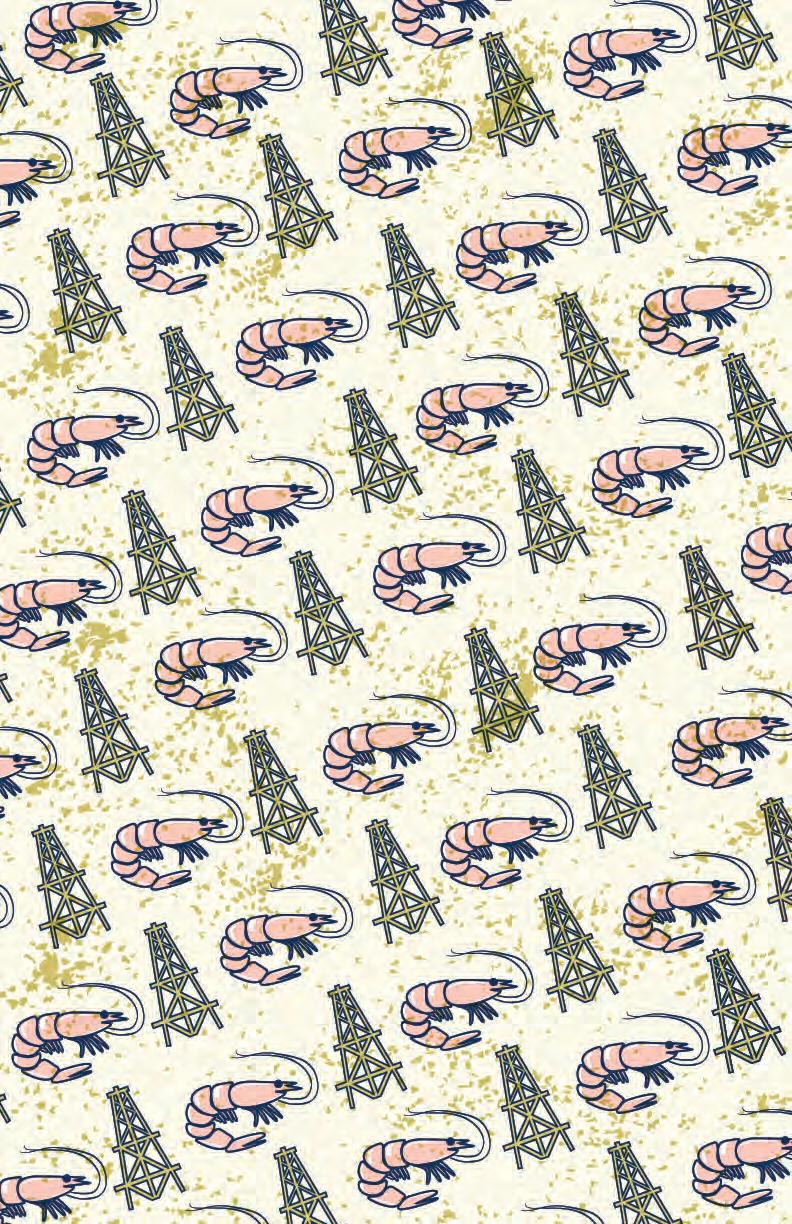
A NEW TOUR LOOKS AT THE REMARKABLE LIVES OF THE WOMEN WHO RAN AND OPERATED OAKLEY HOUSE
By Alexandra Kennon
Though John James Audubon only lived and worked there for a few months in the summer of 1821, the story of Oakley House in St. Francisville is often told from his perspective. Part of the reason for this, besides the enduring fame of the Birds of America series he worked on there, is that Audubon was a prolific journaler—writing down all of his experiences, not sparing any thoughts or opinions. Biases and limitations aside, it makes for interesting reading.
A new tour of Oakley House curated and led by Interpretive Ranger Michaela Brown, who came to Oakley in October 2022 after completing her Masters in Anthropology at Tulane, looks beyond Audubon’s journals to the lives of the multiple generations of women who were responsible for running and operating the plantation. Brown is diligent about not only bring to life stories from the lives of the Pirrie women, including Lucretia and her daughter Eliza—who was Audubon's student—but also to elevate the experiences of the enslaved women who also resided at Oakley. These include Silvia Freeman, who was one of multiple generations of women who served as cooks, and continued in that role even after the Civil War as the plantation transitioned from slavery to tenant farming.
This kind of historical research and presentation isn documents often in the form of letters or journals written by those who lived in the house, filling in the extensive gaps of the experiences of those who could not or did not write, and then presenting it all to contemporary visitors in a way that is engaging. Brown, with her Tulane anthropology education and background in theatre, is uniquely up to the task—from the tour’s first stop, her lively presentation and excitement about her ongoing research was contagious, captivating everyone in the tour group I joined on a July afternoon, even a young boy who looked to be around six.
From the first stop, Brown had us thinking about history in new ways. We giggled as she read Audubon’s judgemental thoughts about the women of Oakley House, from Eliza’s plainness to Lucretia’s stubbornness. Then, we became more contemplative as she reminded us to consider Audubon’s biases, and the context in which he was writing— would he have ever before encountered a woman running her own household? Might his disdain for Lucretia, who eventually fired him just a few months into his post for his disrespect towards her, have had something to do with inherent 1800s misogyny? And beyond that, Brown reminded the group to consider that the entire home was built and operated by enslaved individuals, whose lives were as full and complex as either Audubon’s or Lucretia’s, even where records are lacking. From an archeaological discovery of an 1855 metal coin charm at the site of the cook's cabin, likely once worn by Silvia as she carried on the African tradition of wearing a coin with her birth year as a necklace, to Eliza's secret love letters that conclude in romantic tragedy, Oakley presents an old property in a new—and fascinating—light.
The Women of Oakley tour will be offered on August 12 and September 9 at 11:30 am, 1:30 pm, and 3:30 pm. $10 adults, $8 seniors, $6 students. lastateparks.com.
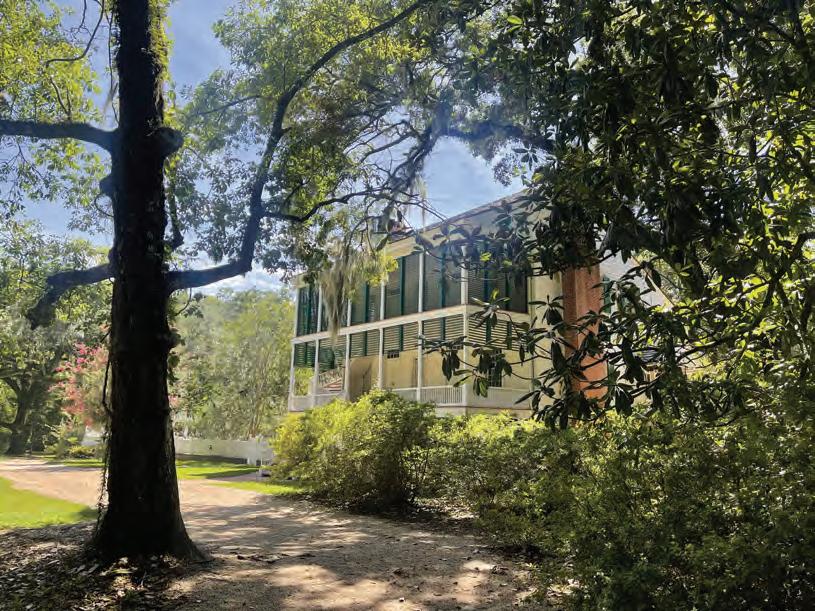
88TH 88TH 88TH
LOUISIANA LOUISIANA LOUISIANA
SHRIMP & SHRIMP & SHRIMP & PETROLEUM PETROLEUM PETROLEUM FESTIVAL FESTIVAL FESTIVAL

AUGUST 31ST -
SEPTEMBER 4TH
LABOR DAY WEEKEND
MORGAN CITY, LOUISIANA CRAFTS, FOOD, MUSIC & RIDES
 RE-EXAMINING AUDUBON
RE-EXAMINING AUDUBON
CELEBRATE LOUISIANA'S OLDEST CHARTERED HARVEST FESTIVAL FOR MORE INFORMATION & SCHEDULE OF EVENTS VISIT WWW.SHRIMPANDPETROLEUM.ORG
COME
Events






Beginning August 18th - August 19th

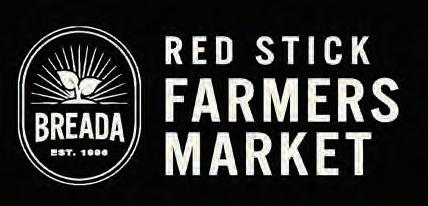
AUG 18th
MUSICAL THROWBACKS
HISTORICAL HAPPY HOUR AT THE WBR MUSEUM

Port Allen, Louisiana
For its regular Historical Happy Hour events, the West Baton Rouge Museum hosts local musicians and storytellers, featuring intellectual discussions, music, panels, speakers, and—of course—drinks, though those are up to you. So pack up your favorite libations, and open your mind to the history of our community. This month’s Happy Hour will feature the band Sariah Storm and the Mysteries, returning to the museum with a set of blues and jazz favorites from the 1920s to celebrate the second installment for the exhibition Angela Gregory: Portraits and Process. 6 pm–8 pm. Free. westbatonrougemuseum.com. •

AUG 18th - AUG 19th
DASTARDLY DINNER PARTIES
NEIL SIMON'S RUMORS AT SULLIVAN THEATER
Central, Louisiana
Neil Simon's celebrated farce about a dinner
party gone awry is coming to Central's newest performing arts venue, the Sullivan Theater. When the guests arrive at a tasteful townhouse to find the host injured and bloody and his wife missing, the theories and miscommunications mount into sheer hilarity. Friday and Saturday at 7:30 pm, Sunday at 2 pm. $25. sullivantheater.com.
AUG 18th - AUG 20th
TOKYO TO GONZALES
ANIME TOWN MERCHANTS 2023
Gonzales, Louisiana

Come out to the Lamar Dixon Expo Center for a display of merchants and art vendors ready to fill all your creative and/or anime-adjacent needs. The three-day event includes local crafts and artwork available for purchase. Doors open at 3 pm. tixr.com for more information. •
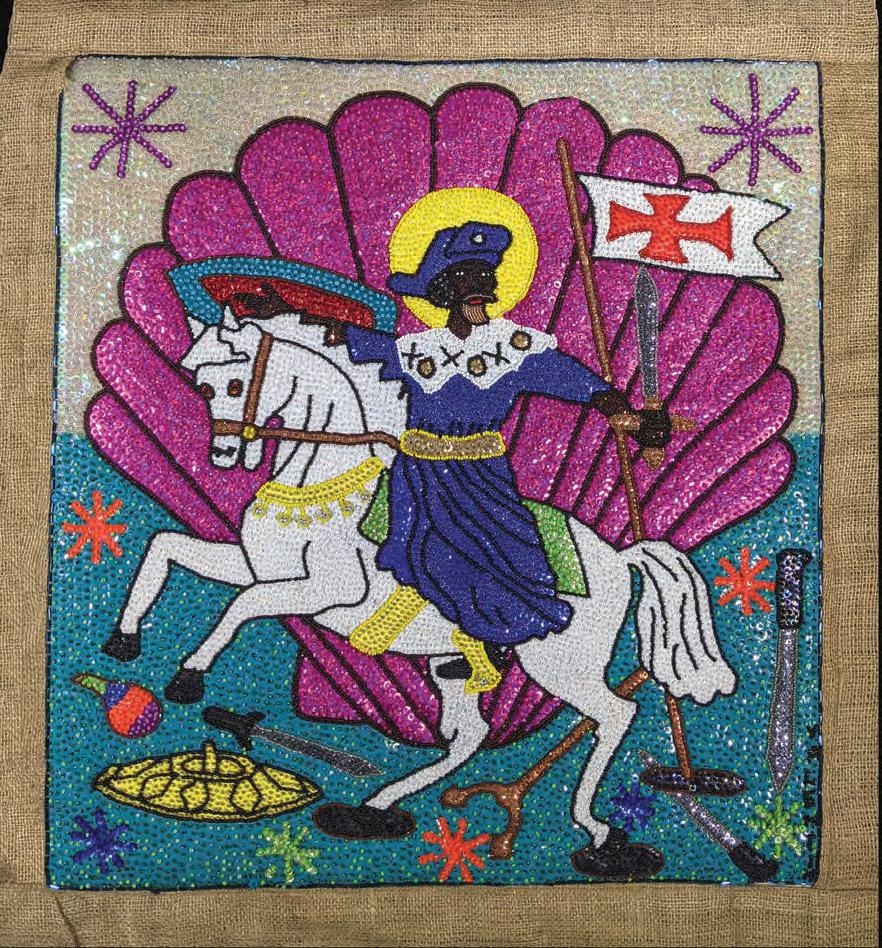
AUG 18th - AUG 11th '24
LOUISIANA'S SCULPTRESS
ANGELA GREGORY: PORTRAITS AND PROCESS AT THE WBR MUSEUM


Port Allen, Louisiana
The second exhibition in the series
THURSDAY, SEPTEMBER 28TH
AUGUST 23 // COUNTRYROADSMAG.COM 32
MUSIC WITH: The John Gray Jazz Trio
An exhibition of intricately-beaded and sequined Haitian "Drapo Vodou" by father-son duo Georges and Valentin Valris is on display at the Cite des Arts Gallery in downtown Lafayette until August 31. Drapo artwork of St. Jaques by Valentin Valris, Courtesy of Cite des Arts. See listing on pg. 11.
LIVE
www.breada.org
PURCHASE TICKETS AT: farmfete.org
THANK YOU TO OUR MAJOR SPONSORS: All proceeds benefit BREADA's programs.
Tricia Day and Joe Simmons | Lynne Pisto and John Hollingshead
Susan Turner and Scott Purdin
Betty Simmons | John G. Turner and Jerry G. Fischer
Angela Gregory: Doyenne of Louisiana

Sculpture, guest-curated by Elizabeth Chubbuck Weinstein at the West Baton Rouge Museum, focuses on the "doyenne of Louisiana sculpture's" portraiture and artistic process. The opening will be celebrated at the Museum's monthly Historical Happy Hour on August 18. westbatonrougemuseum.org. •
AUG 19th
CREATIVE COMMUNITIES

AMITE ART CLUB SHOW, SALE, AND RAFFLE
Amite, Louisiana
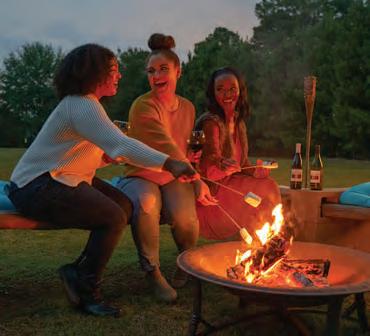
The Amite Art Club, founded in 1961 with the goal of fostering a community of visual artists, returns with its annual art show. Works will be featured in mediums including watercolor, oil, pastel, drawing, acrylic, mixed media, and pottery, as well as children's art—all of which will be for sale. The public viewing and reception will take place from noon–4 pm, with a raffle at 2 pm. Free. amiteartclub.com. •
AUG 19th
ARTFUL EXCURSIONS

COVINGTON WHITE LINEN
NIGHT FOR PUBLIC ART
Covington, Louisiana
Covington's White Linen for Public Art, presented by the Covington Business
Association, is a community affair which endeavors to brighten up downtown with meaningful works of art. Music, shopping, libations, and art are all on the docket, with a percentage of local business sales going toward the Covington Public Art Fund. 6 pm–9 pm in historic downtown Covington. facebook.com/covwhitelinen. •
AUG 19th
CULTURE DOCUMENTARIES
HENRY TURNER JR'S LISTENING ROOM MONTHLY FILM SERIES
Baton Rouge, Louisiana
Henry Turner Jr.’s Listening Room
Museum Foundation is pleased to announce the second quarter monthly film series for July, August, and September. This series focuses on music, arts, and industry. August's screening is of Emphasis on Art, a documentary film about fine artists that includes interviews with architect and artist Frank Gehry, politician Bobby Shriver, contemporary mixed media artist Tony Berlant, and conceptual artist John Baldessari. The film will be followed by an acoustic performance by Henry Turner Jr. Beverages and snacks are available for purchase. 8:30 pm. $10 and includes a Soul Food Side Dish. htjmuseum.org. •
AUG 19th
HANDS-ON TEEN STEAM: KEVA PLANKS
Baton Rouge, Louisiana
Teens are invited to the Jones Creek Regional Branch Library for a Saturday spent working with wood—learning to build wooden models and complete engineering challenges. 2:30 pm–4 pm. Free. ebrpl.com •
AUG 19th ROCK ON DASH RIP ROCK AT MID CITY BALLROOM
Baton Rouge, Louisiana
High-energy New Orleans trio Dash Rip Rock is bringing their punk-infused roots rock to Mid City Ballroom. 8 pm. $30. bontempstix.com. •


AUG 19th CHORUS LINES BRBT PRESENTS BROADWAY AT THE BALLET
Baton Rouge, Louisiana
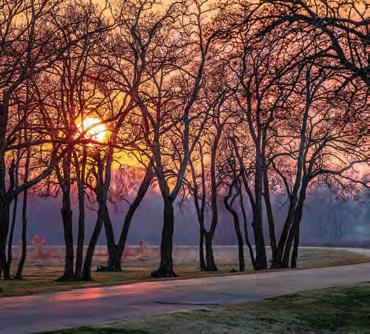
Baton Rouge Ballet Theatre is joining the talents of their dancers with some of Baton Rouge's most impressive musical and vocal entertainers for one night of show tune favorites from Evita, Wicked, A Chorus Line, The Lion King, and more.
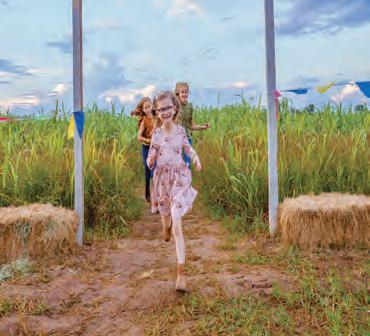
Alongside the Broadway inspired song and dance there will be a silent auction, light nibbles, and wine and beer with a cash donation. 6:30 pm–9:30 pm. $60 in advance, $70 at the door. batonrougeballet.org. •
AUG 19th
LITERATURE LOVERS MISSISSIPPI BOOK FESTIVAL
Jackson, Mississippi
Authors and literature lovers from across the South and beyond will flock to downtown Jackson for the ninth iteration of the Mississippi Book Festival. From book signings, to author talks, to family activities, to panel discussions, the free festival packs a huge variety of bookish education and fun into air-conditioned venues and on the lawn surrounding the Mississippi State Capitol. Attending authors this year include Harrison Scott Key, Jason Reynolds, Katy Simpson Smith, Tom Piazza, and close to 200 others. 9 am–5 pm. Free. Find more information at msbookfestival.com. •
AUG 19 th
KEEPIN' IT COUNTRY GRAND COUNTRY JUNCTION
Livingston, Louisiana


Livingston's most happenin' live music event, "Your Hometown Branson Show" is back in action. Every third Saturday,


//AUGUST 23 33
UPCOMING FESTIVALS: Highland Jazz and Blues Festival Sept. 16 Red River Revel Sept. 30 - Oct. 8 Prize Fest Oct. 13 - 22 State Fair of Louisiana Oct. 26 - Nov. 12 Love SHREVEPORT-BOSSIER WITH IN
VISITSHREVEPORTBOSSIER.ORG For more information:
FAll
Events
Beginning August 19th - August 22nd
come out to Suma Crossing Theatre in downtown Livingston for the hottest local country music acts. 7 pm. $15 for adults, $10 for kids; free for children younger than three years old. grandcountryjunction.com. •
AUG 19th
FOOTBALL'S BACK
SWEET BATON ROUGE'S ULTIMATE TAILGATE
Baton Rouge, Louisiana
Embrace two of Baton Rouge's most beloved pastimes—tailgating and shopping— together in harmony at the return of Sweet Baton Rouge's annual Ultimate Tailgate at Perkins Rowe. On top of favorite tailgate songs spun by multiple DJs, there will be a crafts table for the kids. Noon–5 pm. Free. sweetbatonrouge.com. •
AUG 19th - DEC 16th
LAST CHANCE EXHIBITS
2022 SOUTH ARTS SOUTHERN PRIZE & STATE FELLOWS EXHIBITION
Lafayette, Louisiana

As the last stop for the traveling South Arts 2022 Southern Prize State Fellows
Exhibition, the Hilliard Art Museum welcomes the work of Jenny Fine, GeoVanna Gonzalez, Antonio Darden, Crystal Gregory, Gloria Gipson Suggs, Marcus Dunn, Brittany M. Watkins, Sarah Elizabeth Cornejo, and Louisiana's own Hannah Chalew—who was the 2022 Southern Prize winner. hilliardmuseum.org. •
AUG 20th
ADVOCATE ACTIVITIES
CASAS FOR CASA FIESTA
Baton Rouge, Louisiana
Capital Area's Annual Casas for CASA Fiesta acts as a fundraiser for CASA as they help navigate a child's best interest as they journey through court and child protection proceedings in the Baton Rouge area. Some activities of the night include a silent auction, wine pull, food from Superior Grill, complimentary beer, wine, and soft drinks, as well as a cash bar. The night will round out with music by Kirk Holder and a photo booth, this year at Red Stick Social. $60 per person. 5 pm–8 pm. casabr.com. •
AUG 20th
FIDDLES & ACCORDIONS
CAJUN MUSIC JAM
Port Allen, Louisiana
In the West Baton Rouge Museum's Brick Gallery, area musicians and music-lovers alike are invited to gather each month for a Cajun French Music Jam, sponsored by the Baton Rouge Cajun French Music Association Chapter. A different musical artist will lead the jam each month. So get out your instrument, or your dancing shoes, and join in. 3 pm–5 pm. Free. westbatonrougemuseum.com. •
AUG 20th - AUG 25th
ICONOGRAPHY
THE HOLY FAMILY ICON PAINTING WORKSHOP
Baton Rouge, Louisiana
Learn the techniques to create your own Holy Family icon painting from trained iconographer artists in the lovely setting of the Botanic Gardens at Burden. Sunday from 1 pm–3 pm, then Monday through Friday from 8 am–5 pm. $375. lsu.edu/botanic-gardens. •
AUG 20th - AUG 27th
NEAT FREAKS GET ORGANIZED! AT EBRPL
Baton Rouge, Louisiana
Louisiana's sole Certified Professional
Organizer (yes, it's apparently "A Thing"), will be on hand at the East Baton Rouge Main Branch Library to help you get your stuff in order at the following events:
August 20: Why am I Disorganized?
August 27: Overcoming Procrastination. Both programs are at 3 pm. Free. ebrpl.com. •
AUG 22nd
MIDDAY CULTURE
ART AT LUNCH AT LSU MOA
Baton Rouge, Louisiana
The LSU Museum of Art is helping inject some art and culture into lunch breaks with this program held on the third Tuesday of each month. Bring a bag lunch, and the museum will provide water, sodas, and an insightful and inspiring artist talk. This month, listen to museum educator Brandon Lewis present a discussion on Crowns: The Impact and Significance of Hats in African American Culture. Noon. Free. lsumoa.org. •
AUG 22nd
CARRYING ON CRAFTS NEEDLE SIMPLE EDGING WORKSHOP
Port Allen, Louisiana
Louisiana artist Christy Benoit Castille will lead a workshop in the historic
AUGUST 23 // COUNTRYROADSMAG.COM 34

//AUGUST 23 35
Events
Beginning August 24th - August 26th

art of shuttle tatting, which involves knotting double thread and dates back to the 1700s. 1 pm–3 pm. $30. westbatonrougemuseum.org. •

AUG 24th - AUG 27th
FEATHERED FESTIVALS
GUEYDAN DUCK FESTIVAL
Gueydan, Louisiana
Before Jean Pierre Gueydan founded the town named after himself, he lived in Abbeville, which was thirty miles west of a hunter's paradise that Gueydan visited often. What else could a dyed-in-the-wool hunter do but found a town for himself bang in the middle of all that bounty? That fair-feathered reputation follows the town of Gueydan into the present day and is celebrated at the town's annual Duck Festival. All the usual small-town festival fare is available, along with duck-and goose-calling competitions, cook-offs, skeet shooting competitions, dog trials, pageantry, rides and games, duck carving, and other unique activities. This year's musical entertainment includes Richard
LeBouef & Two Step, Wayne Toups & Zydecajun, Swampland Revival, and many more. Free. Find the full schedule at duckfestival.org. •
AUG 25 th
MEMPHIS AT THE MANSHIP
SOUTHERN AVENUE AT THE MANSHIP
Baton Rouge, Louisiana
The Manship Theatre presents an electrifying blues performance by Grammy-nominated Memphis band, Southern Avenue, who are bringing their award-winning albums, along with their recent single "That's All" to the Hartley/Vey Theatre stage. 7:30 pm. $30. manshiptheatre.org. •
AUG 25 th
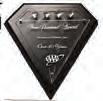
COMMUNITY OCCASIONS
COLUMBIA STREET BLOCK PARTY
Covington, Louisiana
This long-running last-Friday-of-themonth event closes the 200 to 500 blocks of Columbia Street to anything
with an engine, providing lots of opportunities for fun on foot instead. The classic car people and the shop owners will be handing out goodies accordingly, plus live music at local venues. Shops and restaurants open late, too. 6 pm–9 pm. Free. covla.com. •
AUG 25 th - AUG 26 th
DINNER THEATRE MURDER MYSTERY DINNER THEATER AT THE STRAUSS THEATRE CENTER
Monroe, Louisiana
We can't explain why dinner pairs so well with murder mysteries, but the timeless combination is reuniting at the Strauss Theatre Center in Monroe this month when they present You Have the Right to Remain Dead. 7 pm Friday and Saturday. strausstc.com. •
AUG 25 th - AUG 27 th
BLOWING SMOKE
LOUISIANA CIGAR FESTIVAL

Baton Rouge, Louisiana
There'll be plenty of smoke being blown when the Louisiana Cigar Festival comes to Johnson's Courtyard in Baton Rouge—bringing with it a cigar-infused brunch, a smoke 'n' paint event, and more. $25–$130. Find more information at eventbrite.com. •

AUG 25 th - AUG 27 th
PRISON PLAYS
225 THEATRE COLLECTIVE PRESENTS THE SHAWSHANK REDEMPTION
Baton Rouge, Louisiana
Andy Dufresne's friendship with Red that unfolds within the walls of Shawshank Prison has long captured the hearts of those who have read or seen the film adaptation of the Stephen King novella. Now, 225 Theatre Collective is bringing the classic to the stage of the LSU Studio Theatre (minus Morgan Freeman and Tim Robbins, but plus a talented cast of local actors). 7:30 pm Friday and Saturday, 2:30 pm Sunday. $25, students $15. 225theatrecollective.com. •
AUG 25th - AUG 27th
GOOD EATS & TIMES
LOUISIANA SOUL FOOD FALL FEST
Shreveport, Louisiana
Empire Queenz presents Shreveport's 3rd annual Louisiana Soul Food Fall Fest, a three-day festival celebrating diversity, music, and culinary arts. The weekend will be full of familyfun, including Southern cuisine, competitions from seafood-boiling to donut-eating, live music, a dog showcase, dance groups, vendors, and
AUGUST 23 // COUNTRYROADSMAG.COM 36
more. Noon–9 pm. $10. For details, visit louisianasoulfoodfallfestival.com. •


AUG 26 th
CREEPY CRAWLIES INSECT DAY AT THE LAFAYETTE SCIENCE
MUSEUM
Lafayette, Louisiana
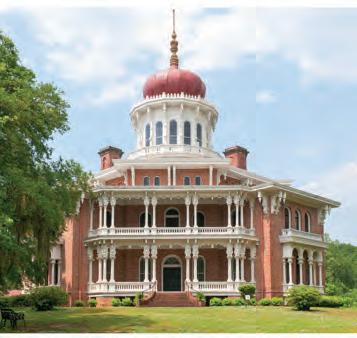
Things are getting creepy crawly at the University of Louisiana-Lafayette's Science Museum for its summer Insect Day event. Guests can explore the wild and mysterious world of bugs through displays of live and preserved insects, featuring specimens from here in Louisiana as well as far, far away. 11 am–4 pm. Free. lafayettesciencemuseum.org. •
AUG 26th
SEASON STARTERS
ULTIMATE TAILGATE PARTY AT THE COVINGTON TRAILHEAD
Covington, Louisiana
Your biggest dilemma for this event will be "What color do I paint my face?!" The Ultimate Tailgate Party promises a blowout for Tiger fans, Saints fans, and the large cross-section of those who root for both, themed around a Sports Tailgating Experience featuring a barbecue competition, live
music from Four Unplugged, an online auction, and a large variety of food and drink. 7 pm–10 pm at the Covington Trailhead. $75. Proceeds go to benefit the West St. Tammany Exchange Club as they raise money to help local youth. ultimatetailgateparty.org. •
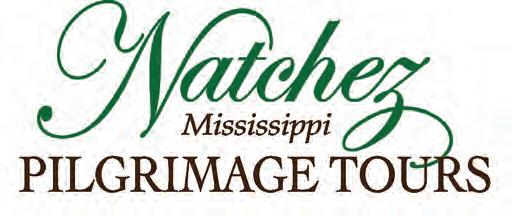
AUG 26 th
TRIP THE LIGHT FANTASTIC BATON ROUGE BALLROOM
PRESENTS A SUMMER AFFAIR
Mandeville, Louisiana
Baton Rouge Ballroom is presenting an elegant evening of ballroom dancing and dinner at the Lake House for their Fall Showcase and dance. 6 pm–9 pm. $35. For tickets, contact Janice Barrios at (225) 324-6395. •
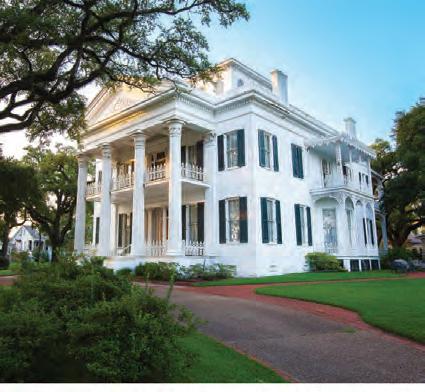
AUG 26 th - AUG 27 th
HGTV HOPEFULS
FALL PONTCHARTRAIN
HOME SHOW & LOUISIANA FOOD FEST
Kenner, Louisiana
The Fall Pontchartrain Home Show— Louisiana’s largest and longest running fall home show—returns to encourage (and enable) your DIY dreams. This year’s event will feature exhibitors boasting the latest trends in kitchens, remodeling, flooring, outdoor living, and so much more. While you're there,





//AUGUST 23 37
Dr. Lauren Cross will give a lecture on "Reclaiming African American Traditions in the Decorative Arts as part of the LSU Museum of Art's Decorative Arts Lecture Series on August 29. See listing on page 39. Image courtesy of the LSU MOA.
Events



















Beginning August 26th

don't miss the Langenstein's Food Fest, where there will be free samples, tastings, coupons, and recipes from over thirty brands. Every participant at the show has a chance to win door prizes, including spa days, restaurant certificates, and much more—and one lucky winner will leave with a $500 grocery gift card. 10 am–5 pm. $8; children younger than twelve are free. jaaspro.com. •



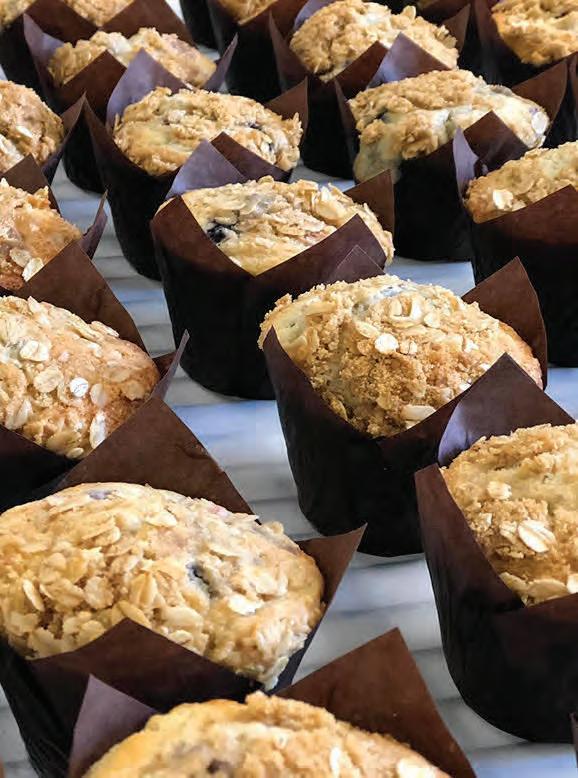

AUG 26 th - AUG 28 th
GET OUTSIDE
MISSISSIPPI RIVER
NATURE WEEKEND
Vicksburg, Mississippi
Tara Wildlife Conference Center in Vicksburg welcomes outdoorsmen of every sort to a weekend celebrating Mississippi's great outdoors. Day passes ($138 for adults, $50 for children) allow for a Saturday spent mountain biking, kayaking, river romping, and birding. Weekend or overnight packages include lodging and food as well. Visit msriverweekend.com for more information. •
Juban's is continuing their Chef & Somm Series with an interactive five-

AUGUST 23 // COUNTRYROADSMAG.COM 38
at every bend DELIGHTFUL DISCOVERIES visitiberville.com (877) 310-8874 Visitors Center located o I-10 @ Grosse Tete Forte Grove
Grosse Tete Farmers Market Firefly Market Under the Moon
Morgan City's Shrimp & Petroleum Festival from August 31–September 4 is one of Louisiana's oldest agriculture festivals, including its historic Blessing of the Fleet Boat Parade, live music, and of course a huge Cajun cook-off. See listing on page 39. Image courtesy of Cajun Coast.
Bakery
course live cooking demonstration led by Chef Chris Motto, accompanied by fine wine pairings. 6:30 pm. $125. bontempstix.com. •
AUG 29th
ART ACADEMIA DECORATIVE ARTS LECTURE
 BY DR. LAUREN CROSS
BY DR. LAUREN CROSS
Baton
Rouge, Louisiana
As part of the LSU Museum of Art's Decorative Arts Lecture Series, Dr. Lauren Cross, the Gail-Oxford Associate Curator of American Decorative Arts at The Huntington Library, Art Museum, and Botanical Gardens in San Marino, California will present a discussion on the subject of "Reclaiming African American Traditions in the Decorative Arts". 6 pm. Free. lsumoa.org. •
AUG 30th
KID STUFF
"CONFIDENT KIDZ: BOOSTING SELF-ESTEEM THROUGH PLAY" AT MONCUS PARK
Lafayette, Louisiana
The Confidence Campaign of Acadiana's Confident Kidz program sets up a transformative journey of self-discovery guised as good old-fashioned fun, all at Moncus Park. Held on the last Wednesday of the month, each session will focus on a different area of kids' development. This month, kids will learn how to use dish soap and water to make bubbles, while engaging in thoughtful conversations about embracing differences with kindness. 11 am–noon at the Play Area. Free. moncuspark.org. •
AUG 31st - SEP 4th
AS LOUISIANA AS IT GETS
SHRIMP AND PETROLEUM FESTIVAL
Morgan City, Louisiana
Booth after booth after booth of festival food is the calling card of the long-running Shrimp and Petroleum Festival, which has returned to Morgan City every summertime for over eighty years. Famous for its historic Blessing of the Fleet and boat parade, which features decorated shrimp boats, pleasure crafts, offshore supply boats, and some of the biggest "muscle" boats of the offshore industry, this festival has been rated a top 20 Southeast Tourism Society event. Time magazine described the festival as "...the best, the most unusual, the most downhome, the most moving and the most fun that the country has to offer." This five-day crustacean celebration is one of Louisiana's oldest harvest festivals, and with loads of events, there is something for everyone. The
entertainment includes continuous live music by local and national acts, an arts & crafts show and sale, a children's village, fireworks, a car show, bass & softball tournaments, the huge Cajun Culinary Classic cooking contest, and lots more. Event locations vary, with most of the action centered around downtown Morgan City's Lawrence Park. Free. shrimpandpetroleum.org. •
AUG 31st - SEP 4th FLAMBOYANT FESTIVITIES SOUTHERN DECADENCE
New Orleans, Louisiana
Back in 1972, friends living in a cottage in Tremé threw together a small "Come As Your Favorite Southern Decadent" party and impromptu parade, and through the years that intimate fête has mushroomed into a full-blown carnival, featuring a parade and all sorts of flamboyant (and risqué) festivities. Since the early eighties, Southern Decadence has evolved to become New Orleans's "Gay Mardi Gras," celebrating the South's LGBTQ+ communities with live music from local musicians and DJs, street dancing, costume contests, and so on. It all leads up to the annual Southern Decadence Parade on Sunday, which gathers steam from Royal Street's Golden Lantern (at Barracks). Recent iterations have attracted more than 100,000 visitors to the French Quarter over the Labor Day weekend. Full details at southerndecadence.com. •
For our full list of August events, including those we couldn’t fit in print, point your phone camera here.

//AUGUST 23 39

AUGUST 23 // COUNTRYROADSMAG.COM 40

//AUGUST 23 41
CONCRETE VIRTUE
HOUSEofCARDS
THE STORY BEHIND THE CABIN AT HONEY LOCUST
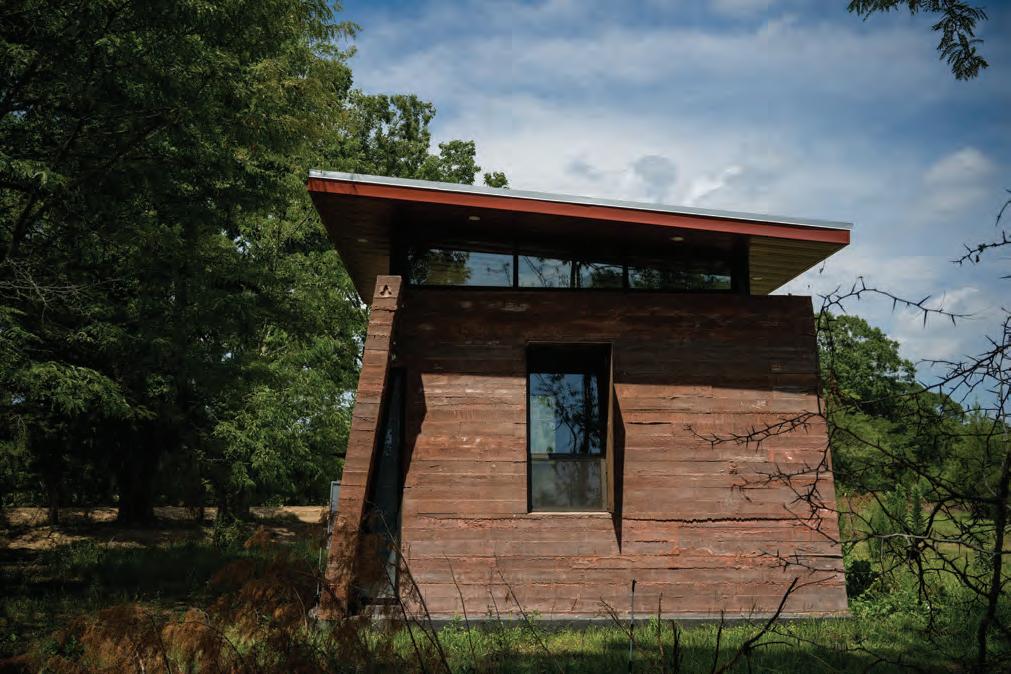
 Story by Jordan LaHaye Fontenot •
Story by Jordan LaHaye Fontenot •
You’ve got four massive precast panels of concrete: “cards”. What is the best way—keeping visual aesthetics, basic physics, and maximization of space in mind—to arrange them into a dwelling?
Architecture professor W. Geoff Gjertson turned this challenge into a design game for his Fall 2021 studio course at the University of Louisiana-Lafayette. Using a “deck” of fifty-four 2’x4’ concrete cards, students Ava D’Amato and Zachary Broussard played, until there it was: the four walls leaning inwards at an angle, drawing from the same philosophies on perspective used by the architects of the Parthenon. “The shape just became iconic,” said ULL Professor W. Geoff Gjertson. A house of cards.
This project would be the seventeenth to be completed through ULL’s Building Institute, founded in 2003 by professors Hector LaSala, Edward Cazayoux, and Gjertson. The educational program provides students within the School of Architecture and Design opportunities
Photos
by Paul Kieu
to gain hands-on experience working on sustainable, regenerative, community-oriented construction projects, startto-finish—with the assistance of local sponsors. Past projects include a series of energy-efficient infill homes in older Lafayette neighborhoods, including a tiny home and one built from shipping containers.
The original concept behind the HOUSEofCARDS, the Institute’s 20212022 award-winning project, was to construct a concrete building in a rural setting—new terrain for the Institute on all fronts. Concrete makes for an economical and sustainable building material, requiring little maintenance across its lifetime, promising longevity, and being weather resistant. Inspired by Henry Thoreau’s Walden, Gjertson hoped to create something to serve creatives living in or visiting Acadiana’s rural communities.
“The concept was that it would be an artist’s studio—a cabin where you could go write your book or paint your painting,” he said. “So, then it was just a matter of finding somebody that wanted some-
thing like that.”
The HOUSEofCARDS found its home in Arnaudville as many such ventures do, via the far-reaching network of the NUNU Art & Culture Collective— artist George Marks’s creative placemaking experiment that has been drawing artistic spirits to this rural hamlet just outside of Lafayette for almost twenty years.
Marks knew what Gjertson was looking for, and he knew a New Orleanian who, craving a quieter sense of creative community, had just bought thirty acres of old pastureland on the Prairie Basse along Bayou Bourbeaux. “Before we had a road in, before we had a well or water to mix concrete, George is like ‘alright we’re gonna start,’” laughed Hayden Reilly, who has now designated her property as the Honey Locust Artist’s Retreat.
Reilly’s first priority at Honey Locust has been to heal the overgrazed land she’s acquired, a process that is ongoing. “It’s taken me a while to understand how I want to exist on the land, with the ecology—to try and remove what should be removed and replace it with natives, and to start to rehabilitate,” she said. “But I knew that I wanted to be able to host and invite friends and artists.”
By partnering with Gjertson and the Building Institute, Reilly was able to delegate the task of getting her first piece of infrastructure established while devoting

more of her own time to revitalizing the land itself. “It was a really mutually beneficial relationship,” she said.
Structured as a studio class offered in Fall 2021 semester and electives in the Spring and Summer of 2022, the Building Institute invited upper-level undergraduates to apply, with an essay, to be part of the project. The course was also opened up to graduate students as an elective. In total, twenty-two undergraduate architecture students and seven graduate students contributed to the project—starting with the design process.
“So the way it worked, these guys broke into two groups, and they each drew up a master plan for the whole property,” said Gjertson. They established the ideal location for the HOUSEofCARDS as hidden from the road, becoming visible as you round the corner along the edge of the property’s biggest pasture, windows looking out on the pond (which Reilly is currently in the process of restoring). In addition to practical and aesthetic concerns, the location was selected with energy consumption in mind—planning around the sun’s impact on the space. The students also envisioned future infrastructure for Honey Locust that includes up to five more artist studios, a common building for workshops and meetings, a central showering facility, spaces for plantings, and more. Then they started working on the building itself. “We had
AUG 23 // COUNTRYROADSMAG.COM 42 Features AUGUST 2023 ADAPTABLE AESTHETICS 42 A CONCRETE RETREAT ON THE PRAIRIE // 46 THE CHAIRMAKER NANCY REAGAN MADE FAMOUS // 48 A. HAYS TOWN’S MOST ICONIC PUBLIC BUILDING SOON TO BE PINK AGAIN •
The House of Cards, situated on artist Hayden Reilly’s Honey Locust Artist Retreat in Arnaudville, was the 2022 project of the University of Louisiana-Lafayette Architecture School’s Building Institute. It was constructed of concrete board-formed using wood salvaged from a barn onsite. Board forming is a technique that imprints the texture of wood onto concrete, giving it a more natural, hand-hewn appearance.
to figure out how to work with the angles, how that was really going to work,” said student Matthew Dufrene.

Once the building’s “house of cards” design was settled on, “they got thrown into it,” said Gjertson. “They were working in software to detail all the steel around the windows, all the connections.” The original plans to use precast panels of concrete were shelved when the students determined that cast-in-place concrete would be more cost- and energy-efficient, reducing the associated burdens of transportation and allowing the students the opportunity to engage even more intimately with the material itself.
Onsite, the first step in the building process was actually a demolition. An old, dilapidated barn was obscuring the view of a live oak from the studio site and was a hazard in itself. It also provided an opportunity to make use of salvaged materials and incorporate board-forming techniques into the design. The barn’s weathered wooden boards would ultimately provide the wood-grain texture cast into the building’s concrete panels.
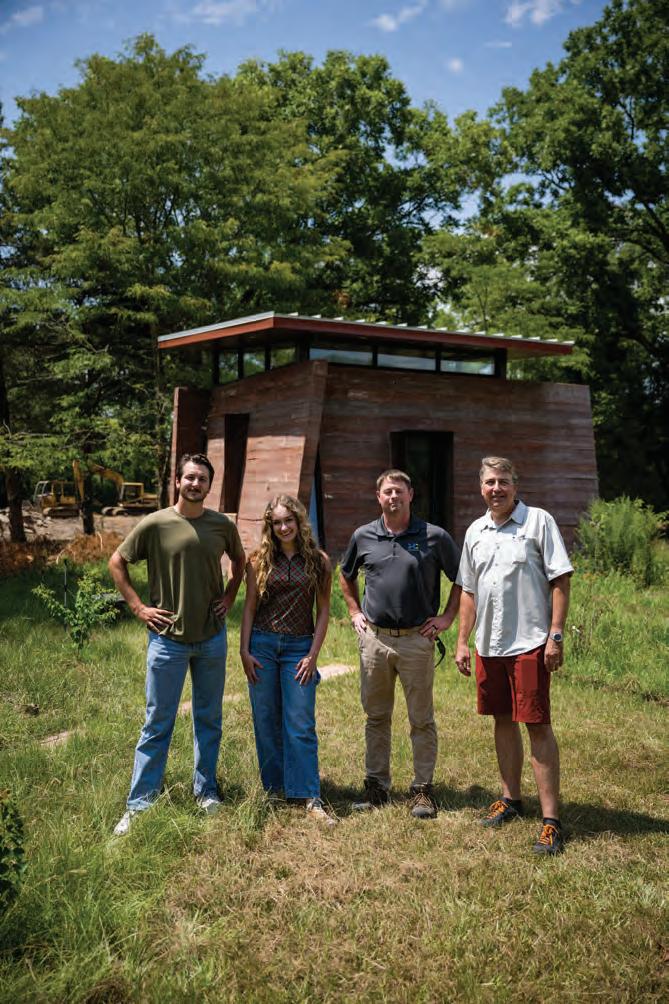
Using the salvaged wood, the students began constructing the scaffolding formwork in October 2021. Over the course of the semester, they installed insulation, tied rebar, and started hand mixing almost forty tons of concrete, before dying it a terra cotta red. “One student’s arm was red for months,” recalled student Christian Willis.

When it came time to pour the con-


crete, the work unfolded in a highly coordinated choreography, which Dufrene described as a spiral. Teams were designated to mix the concrete and hand off the five-gallon buckets to students waiting on the lifts, who were at the same time nailing in the barn boards for the forming, before dumping it all in. “As it got higher and higher up, it just got harder and harder to pull up the concrete,” said Dufrene.
“I think what was cool about the building process was that all the students got to experience all the different skills you need to build a house like this,” said student Gabrielle LeBlanc. “Now I know how to cut rebar, and put in installation. And in the beginning, we all experienced those different things, and then at the end, when we really had to kick it into gear and finish pouring the concrete before the end of the semester, we all had kind of developed our specialties.”
By the end of the year, the concrete was waterproofed, the roof placed. Final touches were made in the spring, including window installations on each wall, as well as in clerestories above. The interior includes butcher block countertops and a desk built using the rafters salvaged from the old barn, as well as a bed—all constructed by students. The house receives electricity from the grid, although there are plans in place to someday transition to partial solar. There is a wall-mounted air conditioner, a refrigerator, an outdoor shower that runs on well water and
The Louisiana Food & Wine Festival is a showcase of Louisiana’s unique culture and cuisine, from its culinary superstars and beverage experts to its artisans and live music. Enjoy a variety of all-inclusive food and drink tasting events with celebrity guest chefs and hundreds of varieties of wine, beer and spirits.






// AUG 23 43
Some of the ULL architecture students who designed and constructed the House of Cards, from left to right: Christian Willis, Gabrielle LeBlanc, and Jason Funderburgh with professor W. Geoff Gjertson.
Louisiana’s Best Week of Food & Drink September 14 - 17, 2023 Lake Charles, Louisiana Make Your Plans to Attend Now! louisianafoodandwinefestival.com HOSTED By PARTNERS PRESENTED By Celebrity Chefs ParticipatingMore to Come! John Currence City
Meg Bickford
Palace Edgar “Dook”
IV
IV David
Television
Ryan Hacker Brennan’s Benchawan
2023
Best
Texas, Street
Grocery Restaurant Group
Commander’s
Chase
Chapter
Rose
Chef/Author
Painter
James Beard Foundation
Chef
to Kitchen
an electric water heater, and a compost toilet—but no WiFi. The floors are, of course, polished concrete.
When I visited in early July, the interior had been totally rearranged, the bed altogether removed and replaced by a wall of photographic scraps, sketches, and paintings. Since February, painter Jacob Broussard had been using the space as a studio while preparing for his summer exhibition at Towards Gallery in Toronto, Canada. “He needed a flat wall,” said Reilly. “So, I said, ‘we can build a flat wall for you, no problem.’ He’s been here every single day and has just been cranking out work.”
The adaptability of the space is important, said Willis. “It has to be able to change according to what people need.” Gjertson said he envisions it being used for everything from visual arts to research to birdwatching. “It’s going to have an interesting history of use,” he said.
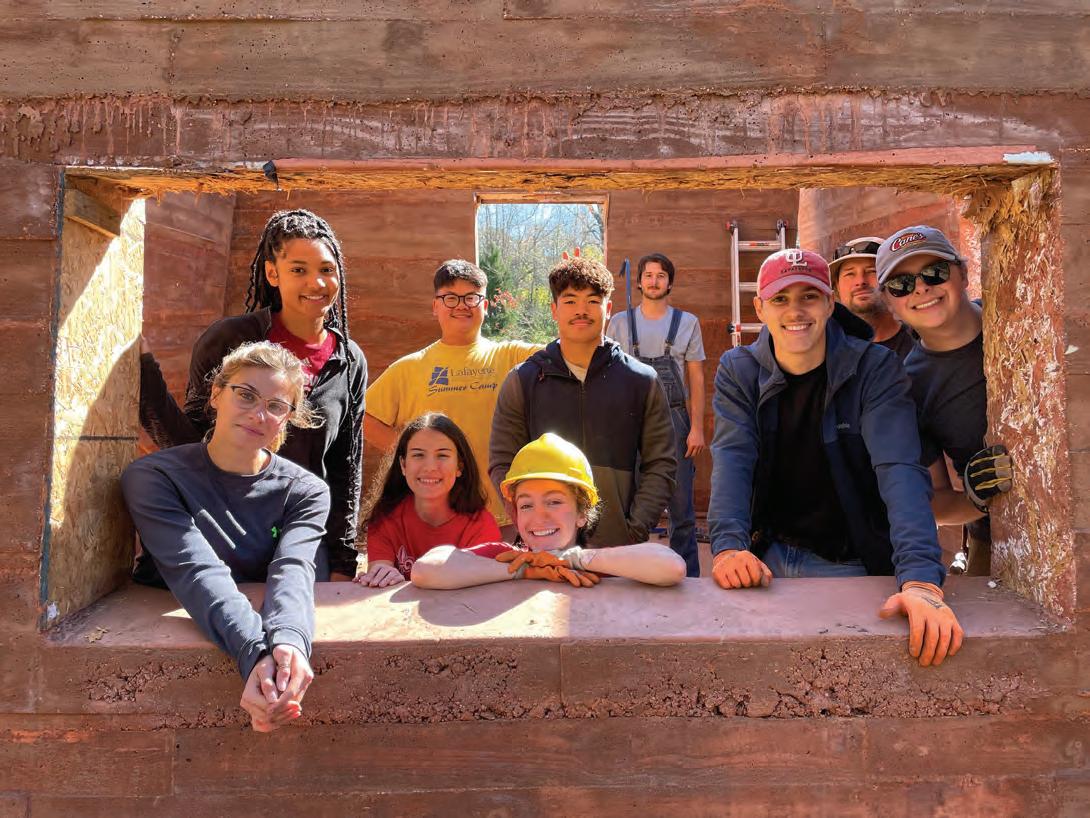
Though Reilly is not actively accepting formal applications for residencies just yet, she has had a few creatives (funneled through NUNU) break the HOUSEofCARDS in since its formal completion in May 2022. Broussard, who has lived away from Acadiana for the past six years, wanted to come home to research a long-lost cousin who he’d recently discovered was an original member of The Mystic Krewe of Apollo de Lafayette— the oldest gay Carnivale organization in Louisiana—for a biomythographic
collection of paintings titled Afters. A sequence of word-of-mouth connections brought him to George Marks, who brought him to Reilly. “It’s been, like, kind of a dream,” he said. For Broussard—who hasn’t been living in the studio, but using it primarily as a workspace—the effect has been twofold: as a uniqely quiet place to focus in on his work, and a portal transporting him home. “I do think there is a lot of symbolic resonance returning to Louisi
ana,” he said. “And the property itself is so stimulating. I see like twelve different animals every day, or insects. I haven’t been away from Louisiana that long, but then when I come back, it's like the biodiversity of this place is so strange and eerie and beautiful.”
One of the earliest overnighters at the
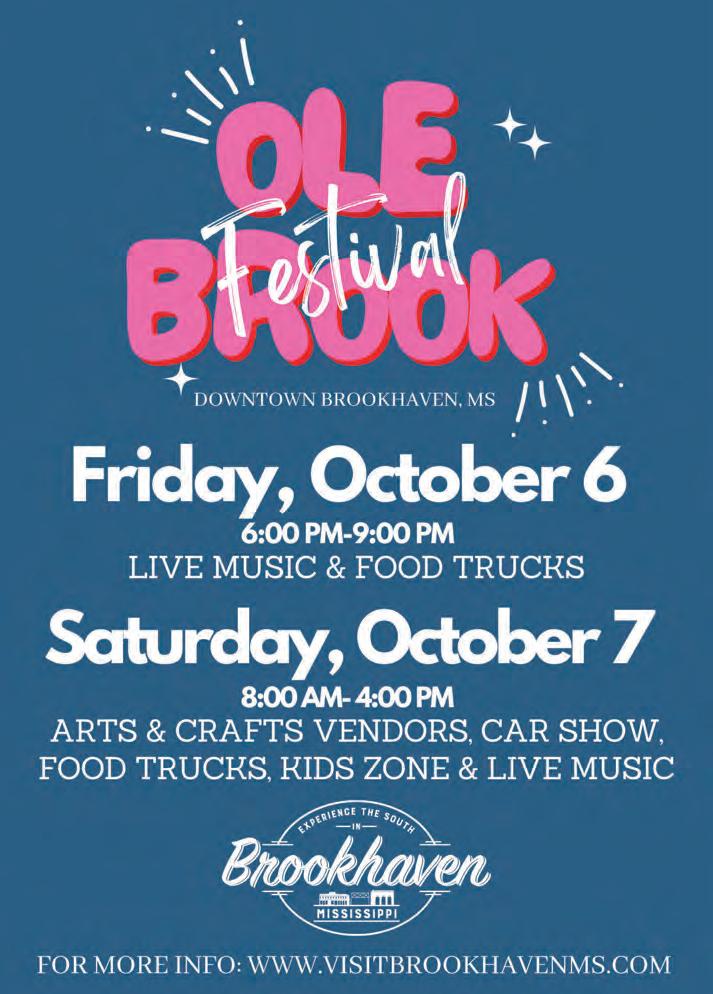


ing architects want to return to, partly because they built it to last. “You look at this and you get the dialogue of what went into it, and the process—it adds a soul to it,” said Willis. “We all put our soul into it. Everybody who worked on this project is encapsulated in it.” •
Learn more about Honey
Locust Artist Retreat at honeylocust.org and about the ULL Building Institute at architecture.louisiana.edu.

AUG 23 // COUNTRYROADSMAG.COM 44
Students working on the ULL Building Insitute’s House of Cards—from left to right: Lexi Palumbo, Elise Baranco, Vincent Nguyen, Lindsey Authement, Gabrielle LeBlanc, Rhilong Phan, Christian Willis, Hunter Darby, Jason Funderburgh, and Matthew Dufrene.


// AUG 23 45
Greg Harkins: The Last of the Masters
IN A THROWAWAY WORLD, TRADITIONAL CRAFTSMANSHIP RAGES AGAINST THE DYING OF THE LIGHT
Icannot say when I first learned about the chairmaker Greg Harkins. For many of us native Mississippians, he has always just been there, out in the woods of middle Mississippi somewhere, making oldtime wooden chairs with his hands. Pinning down the moment I became aware of him would be like identifying the first time I heard Friday night whistles in fall, or those low-lapping Gulf Coast waves. He’s been there too long to know. What I can do, though, is tell you when I first decided to pay Harkins a visit.

It was the beginning of 2021, and I was traveling I-55 north of Jackson when I noticed a billboard. There was old man Harkins, white beard and all, standing beside one of his rockers. “WANTED: Apprentice workers,” it read.
Coincidently, I had just recently read Mark Stowers’ Mississippi Folklife story about Harkins’ search for an apprentice. Harkins had come to realize that if his traditional method of chair-making was to carry on into the future, he needed to pass his knowledge along to someone, and soon. At that time, he was approaching seventy.
The story had left me curious about what it feels like when a craft you have spent your life mastering is in danger of vanishing with you, when you are the last of the line. Years ago, a cobbler told me that we have come to live in a “throwaway world”—a world without need for his sort of craftsmanship. Since then, I’ve wondered about the inner monologue that must accompany that realization. I figured Harkins might have some insight, and in March, I called the number on the billboard.
Harkins lives about fifteen miles north of Jackson down an unpaved road in a two-story house. When I pulled up, Claire Henson, his partner, welcomed me inside and offered some “cowboy coffee.” A few minutes later, Harkins came downstairs.
The first thing he did was hand me a prayer booklet, which he explained had been given to his father by a nun in 1924. His father was only three years old at the time, boarding a train in Tennessee bound for Mississippi, where he would meet his adoptive family. Harkins had only recently come into possession of the booklet, and as he relayed its story, he seemed to be blinking back tears.
It had not been five minutes since we’d met.
AUG 23 // COUNTRYROADSMAG.COM 46 TAKE
A SEAT
Even at seventy-one, Harkins looks bull strong. The things I noticed most about him—that his hands were thick and sinewy, that he smelled of wood polish, that he possessed a calm self-assurance—were each a result, I am sure, of his life’s work.
Harkins has been making chairs the nineteenth-century way since the mid1970s. He learned the craft during a three-year apprenticeship to a no-nonsense master chairmaker and his wife, Tommie and Mable Bell, who worked alongside Morgan Haynes, who learned from a man history only knows as Rouse. They were from a place on the Natchez Trace called Thomastown, where Harkins’s ancestors were from, and though each one has long since passed away, Harkins says their fingerprints cover every chair he makes.
In 1980, Harkins took some of his work to the Neshoba County Fair, looking to make a few sales. Ronald Reagan spoke that year and, as he did so, someone photographed Nancy sitting on her husband’s lap, in one of Harkins’s rocking chairs. Almost instantly, Harkins became a Magnolia State legend. Orders poured in. “If I had tried to plan all this, I couldn’t have,” he said at the time. “It just happened.” Since then, he has made chairs for six U.S. presidents, celebrities like George Burns and Bob Hope, and thousands of everyday folks who appreciate fine craftsmanship.
At one point during my visit, I asked Harkins what separates his chairs from those in national retail stores. He responded only by tapping his temple with his forefinger. That exchange took place in his workspace while I was sitting in one of his rocking chairs. Pitfalls await anyone who tries to describe how it feels to sit, but let me say this: That chair had a way of making gravity agree with you.
These days, there is a young man named Hodges Boland working in Harkins’s workspace. When I visited, he was rubbing polish on spindles. Harkins has imparted the basics of chairmaking to Boland, and he spoke highly of his artistic abilities. Right before this issue went to press, Harkins shared that Boland had recently completed his first chair constructed from top to bottom. But neither of them, when asked, ever committed to the idea of the twentytwo-year-old becoming a long-term apprentice.
I should say now that during my time with Harkins, he never quite opened up about passing down his craft, though it is clear that it continues to weigh on him. “What I want more than anything in the world,” he said, “is to teach people this art.” He was sincere, and Henson later shared that it stays on his mind—it’s why he paid for that billboard. But whenever I tried to get him to expound on the topic, he never quite answered, not directly—speaking
instead about the ways that his body is slowing down—how he can no longer stand on his feet all day long. Often, when I asked him about the unknown future, Harkins brought up the past.

He told the story of his maternal grandfather, who immigrated from Greece and made a life in America. He spoke in detail about how Tommie Bell made chairs for sixty-four years. He recalled the great effort of having the Catholic church his family built in Tho mastown moved onto his property. He told the story of his father, who never once spoke of his adoption and instilled in his son a drive to be worthy of the family name. He showed me a pho tograph of his daughter when she was young.
Henson later told me that when Har kins goes to Thomastown, he says he feels the spirits of his ancestors. Not figuratively—literally, he feels their presence, and draws strength from it. I suddenly saw more clearly how so much of what Harkins does is tied to the past. Building his own house. Grow ing the vegetables he puts on his table. Faithfully following recipes established decades ago. In making chairs like the ones his ancestors sat in, he is not only keeping a tradition alive, but staying in touch with his forefathers. For Harkins, this preoccupation with the past is more all-consuming than the future.
I let it bother me, for a while, that the story I hoped to write—about a mas ter craftsman trying to pass along what he knows before it is too late—did not materialize. I had arrived at Har kins’s place with visions of gleaning some hard-won wisdom from him, but instead had been given only what felt like disparate pieces of his past.
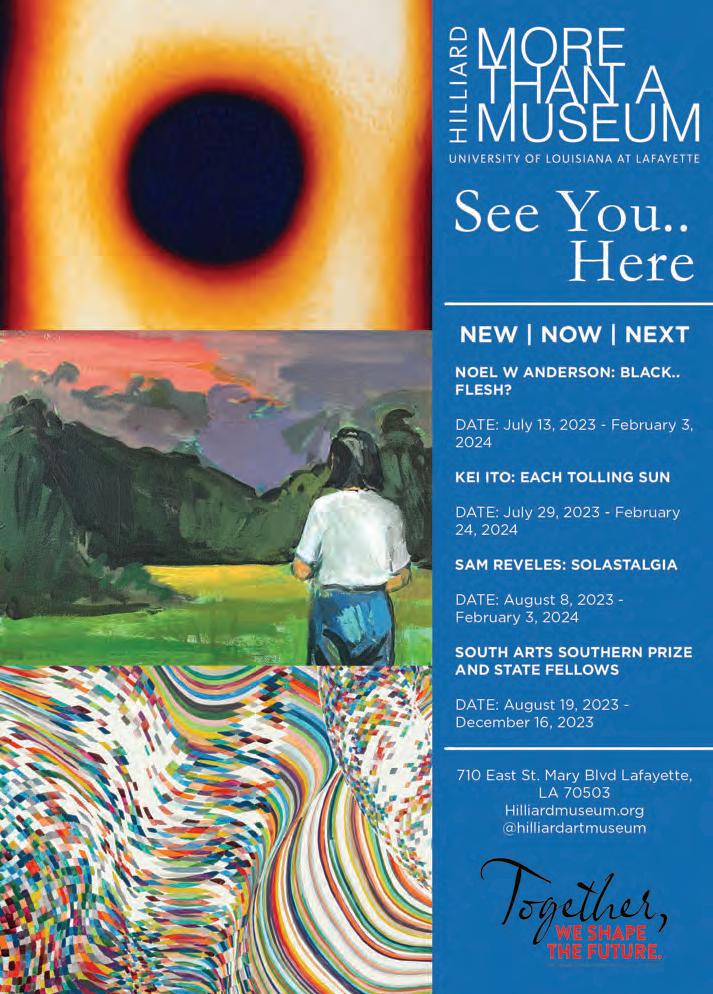

Then I remembered our first telephone conversation, when I called to arrange a visit. Harkins had been as pleasant as could be, but there was some awkwardness due to the fact that while talking with me he was also helping someone—I assume Boland—in some facet of woodwork. It was hard to tell when he was speaking to me, or to his student.
When I told him I was interested in talking to him about the need to find an apprentice, he responded: “When you’re fifteen, twenty-five, you’re never going to get old.” This made me grip my pen, ready to jot down what he might say next.
“Brace your drill on the table,” he said, having clearly gone back to Boland.
It happened again when I asked about the potential end of his line of work. “There is an end to this,” he said, and I got ready to record his next utterance, which was: “Worry about that later.”
I assumed he had turned back to Boland. Maybe he hadn’t, though. Either way, there was work to be done and, God-willing, there will be, until the end.• harkinschairs.com

// AUG 23 47
Restoring the Pink Palace

THE PAST AND FUTURE CONVERGE IN A CAREFUL RENOVATION PLAN FOR ONE OF A. HAYS TOWN’S MOST ICONIC WORKS
Story by Caroline Alberstadt • Photos by Paul Kieu
The iconic columned, Greek Revival building at the University of Louisiana Lafayette’s Hilliard Art Museum, a landmark of the Acadiana landscape, has stood since 1967 as a prime example of the architecture of Louisiana legend A. Hays Town. The structure has served as a cultural gathering place and formal backdrop for campus and community events—hosting 19,000 visitors per year. Time and functional alterations have impacted the building’s character, modifying Town’s original design and necessitating a modern-day restoration.

To return the structure to its roots, a $1.5 million capital campaign, ongoing since 2018, has been supported by locals and alumni, some well-known—such as the museum’s founder Paul Hilliard— and others anonymous. Fundraising cur-

rently stands at the 75% mark, thanks to a generous gift by Lafayette native Roger Ogden, namesake of the Ogden Museum of Southern Art in New Orleans. The funds will go towards restoring the 4,300 square foot building to its prior glory while simultaneously creating more usable space for classrooms, conferences, programs, and events. A café and dining facility is also planned for ULL students and the surrounding community to enjoy.
Considered to be one of the most significant architectural projects of the moment here in Louisiana, the mastermind behind the restoration is Lafayette architect Kevin Gossen of Gossen Architects. His admiration for the A. Hays Town style is evident in the architect’s sense of scale and proportion, as well as an assured knowledge of the details appropriate to the historical vocabulary
of each project. As a young boy growing up in Lafayette, Gossen admired Mr. Town’s work and sought to emulate his style.
When he was just a few years out of architecture school, he boldly called the renowned architect and asked for an audience. Town graciously invited him to his home in Baton Rouge, where he spent several hours talking shop with his mentor, even getting the chance to go into the attic to view flat files full of hand drawn plans documenting the architect’s many projects. He observed how Town’s style had evolved across the span of his career, increasing in confidence as he leaned into the use of time-honored, vernacular building methods.
Over the course of Gossen’s own career, he has continued to expand his design repertoire and embraced more diverse styles, but those foundational
principles of scale, proportion, and refined detail so signature to Town’s approach remain with him.
The magnitude of modifying a project as significant as Town’s might intimidate architects without Gossen’s keen eye for detail or drive for authenticity. He faces the great challenge of restoring while simultaneously modernizing the iconic architectural work. Incorporating new functional technology in a way that conceals modern building systems without compromising the exquisite architecture is priority one. Ironically, the more building technology advances, the more tools are available to camouflage it, with ventilation and lighting becoming smaller and more effective, without sacrificing performance. This is Gossen’s specialty. As a renowned specialist in preservation, Gossen aims to ensure the architecture is respected and preserved, acting as a
AUG 23 // COUNTRYROADSMAG.COM 48 TOWNIES
Lafayette architect Kevin Gossen specializes in historic restorations, and has long held a special interest in A. Hays Town’s work. He will lead the renovation project of the University of Louisiana-Lafayette’s Hilliard Art Museum Town building.
revival of Town’s original vision for the building. “I’ve been privileged to work on many of Mr. Town’s projects over the years, with the goal to respect and honor his original design intent, while delicately balancing modern amenities and client needs”.
Originally patterned off the Hermitage, built in 1812 in Darrow, Louisiana, the interior layout of the Town Building is based on the traditional Greek Revival home plan with a center foyer and hall, leading to the parlor and a Louisiana cypress wood-paneled library. Because the building is designed more like a large residence, it has been a particular challenge to convert its functional use to a space for public events. Use as an art gallery or museum space is impractical due to the abundance of large windows, which pose a threat to precious artworks by exposing them to the sun’s ultraviolet rays.

For this reason, the building has been somewhat underutilized, something the UL Foundation intends to rectify with this massive overhaul. The warm and inviting interior spaces of the Town building will offer room to gather for small parties, or to simply hang out and study. The newly renovated rooms on both the first and second floors will be more accommodating for small lectures, programs and classes—there are even plans to incorporate a smart classroom on the second floor.
Long overdue upgrades of building sys-

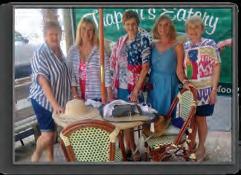
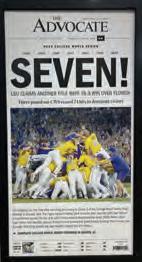


tems include bringing restroom facilities up to ADA standards, improving vertical circulation, and adding an elevator These improvements will expand capacity for programming within the space—making the building a more useful facility on the campus as well as providing a source of revenue via usage for private events. Future visitors can look forward to enjoying lunch in the parlor or having cocktails by the fireplace in the library of this beautifully appointed building as well as perusing a planned permanent exhibit dedicated to the building’s venerated architect.
Once nicknamed the Pink Elephant by locals, the renovation seeks to return the exterior walls to their former blush hue. Using traditional materials and building methods, the bricks that form the walls and columns were handmade from the red clay local to our area. These handhewn bricks could be brittle and imperfect, requiring a plaster coating to smooth out the uneven surfaces. The distinct color of the plaster was created with a mix of white lime and broken brick.The same method will be used in the new renovation to restore the soft pink glow to the currently stark white plaster walls.
Among the aesthetic priorities will be the replacement of the asphalt shingle roof with a more historically-accurate, but costly, slate tile roof—an ongoing project to be completed as funding becomes available. The tile for the original roof was reclaimed French slate from
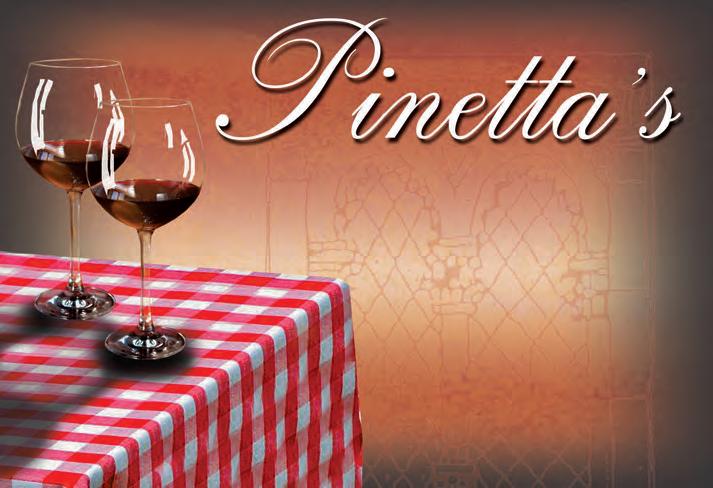

New Orleans which had been used as ballast on ships coming into port. Today, a single large door greets visitors to the building, but Gossen plans to recall Town’s original design using a pair of small French doors by creating a compromise: a single front door that appears to be a pair. This allows the opening to be more accommodating, and the style more aligned with the Town sense of proportion.
Gossen describes the building as a local landmark at ULL. “It’s important to the community to respect and preserve it,” he said. This was never clearer than when esteemed architects Eskew Dumez Ripple designed the adjacent Hilliard Art Museum, using the Town building as the key leitmotif. Instead of trying to compete with it, they created a front façade of reflective glass running parallel to the Town building across the courtyard, creating a mirror image in its reflection. It’s a “faceless façade”, says Gossen, giving the now historic building hierarchical dominance.
Gossen’s work carefully renovating the Town Building is in itself an act of homage to the man who left such an indelible mark upon the southern building landscape, and on his own life and career as an architect and preservationist. Mr. Town set the bar high for authenticity and made using local materials such as clay tile and heart of pine floors desirable, employing skilled craftsmen and applying age-old techniques. The endeavor
to restore the building will be like taking steps forward and backward at the same time in a grand gesture to reflect the vision of the master once more, while assuring the building will remain relevant to current and future generations. •
Visit hilliardmuseum.org/support to learn more about the Hilliard Art Museum’s capital campaign to restore the A. Hays Town building on its property, and learn more about Gossen’s work at gossenarchitects.com.
// AUG 23 49
680
Highway,
LA 70806 • 225-924-6437 • Elizabethangallery.com Elizabethan Gallery More Than Just A Frame Shop ONE DAY FRAMING AVAILABLE FRAMEYOUR VACATION PHOTOS, MEMORIES& CHILD’S CAMPART. HOT SUMMER SHOW
new
EUROPEAN RESTAURANT A BATON ROUGE TRADITION SINCE 1962 3056 Perkins Road 225-387-9134 Open Monday-Saturday Call for Hours
Jefferson
BR,
Featuring
work by Mickey Asche & Keith Douglas (Show hangs until Saturday, August 26th)
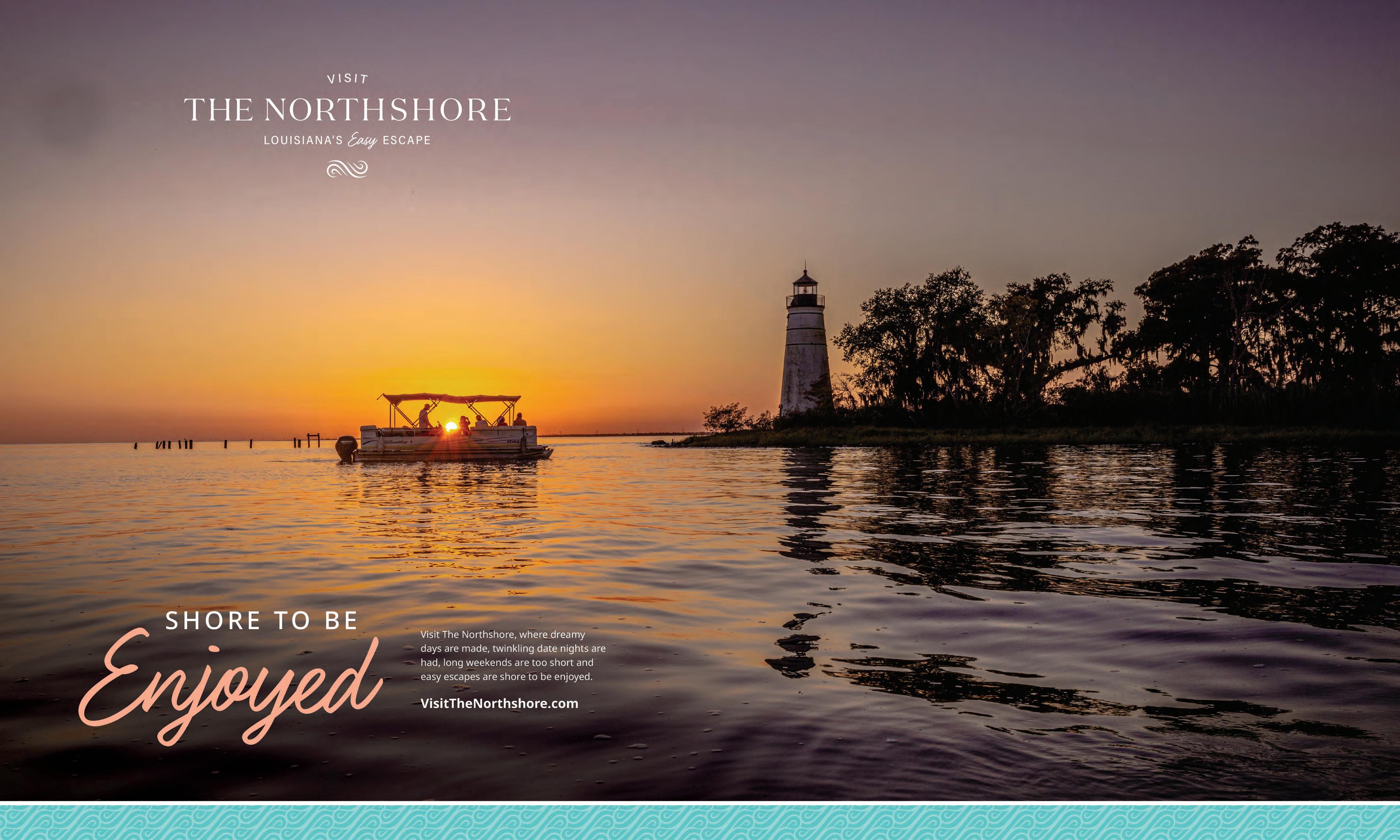
AUG 23 // COUNTRYROADSMAG.COM 50

//AUG 23 51
Cuisine
As Southern & Wild as Ever
AS A RESTAURATEUR
Observing Jordan Ramirez in haction is like watching Tony Hawk at the skate park. Keep your eye on him, there will be unexpected maneuvers.
Ramirez has been a fixture of the Baton Rouge food scene since he started working at Tsunami in 2006, before stepping up to manage the specialty foods section at Whole Foods. That experience, he said, opened his eyes to new ingredients, which inspired quite a bit of kitchen tinkering and experimentation.“Whole Foods was basically my culinary school,” he laughed.
It was during this time that, with the help of the LSU Ag Incubator, he fired up his hot sauce brand, Southern Wild, a luscious blend of habanero spice and olive oil, bottled and sold in local shops.

After leaving Whole Foods, he accepted an opportunity helping Galen Iverstine open his original butcher shop on Perkins Road in 2016, receiving world class training in nose-to-tail butchery along the way. In no time at all, his awards from local cooking competitions festooned the service counter.

Seven years later, on a Tuesday night close to quitting time, I’m sitting at the bar at the first restaurant Ramirez could call his own—Baton Rouge’s beloved Pan-Asian hotspot Chow Yum Phat. Opened by Ramirez and Chef Vu Le in White Star Market in 2017, the eatery found its home in the Perkins Overpass district in 2019, and still serves Southern Wild hot sauce on its Taco Tuesday specials.
I’m passing up the tacos, though, opting instead for the day’s special frozen drink and my first attempt at The Mandu: spicy beef bulgogi dumplings, fried, with melted cheese, kimchi salsa, Gochujang aioli, pickled jalapenos and scallions, and a big bowl of curried vegetables rich with lemongrass-infused coconut milk. As I scrape my chopsticks together, about to dig in, someone taps me on the shoulder. It’s Ramirez out of kitchen uniform, dressed in a pressed shirt, his coffee brown hair tumbled loose from his traditional backward ballcap, stopping by the restaurant after scooping another
I SPY KIMCHI
AUGUST 2023
52
THE MAN BEHIND BATON ROUGE'S FAVORITE RAMEN // 53 THE SECRET TO A PERFECT BISCUIT •
CHEF PROFILE
BATON ROUGE HOT SAUCE CONNOSSIEUR AND BUTCHER JORDAN RAMIREZ IS THRIVING
Jordan Ramirez has a long history with iconic Baton Rouge culinary institutions. Find him these days at his Pan-Asian hotspot under the Overpass, Chow Yum Phat, or next door at the neighborhood bar, ZeeZee's.
Best of 225 award, the third consecutive for Chow Yum Phat.
“Crawfish put us on the map,” Ramirez says of Chow Yum Phat’s lip-tingling, Vietnamese version bathed in lemongrass butter and served with edamame, quail eggs, and handfuls of fresh cilantro—along with Louisiana’s traditional corn and potatoes. When it isn’t crawfish season, diners can experience more of what Ramirez describes as ‘fun food,’ including ‘slurping-is-encouraged’ noodle bowls, crispy fall-off-the-bone tender wings tossed with funky sauces, dumplings steamed or pan-fried crisp, and fluffy bao buns stuffed with almost anything, including a soft shell crab or hot chicken. “I love combining Southern and spicy flavors,” he said.
The pro tip for dining at Chow Yum Phat is to go with a table full of friends— allowing for a more expansive sampling experience. The enticing menu makes it almost impossible to order for a single or table for two—when this is the case, order extra for the next day’s lunch, or make plans to return again and again to get the full experience. From the small plates section, the tempura-ish salt-and-pepper cauliflower tossed with fresh jalapeño slices and Yuzu aioli is my go-to, and I can never resist the crispy fish curry.
Ask your server what the restaurant’s most popular dish is, though, and they’ll tell you the ‘Oskar’s Wild,’ ramen bowl, with its smoky broth and Korean beef, kimchi and perfectly-cooked halved
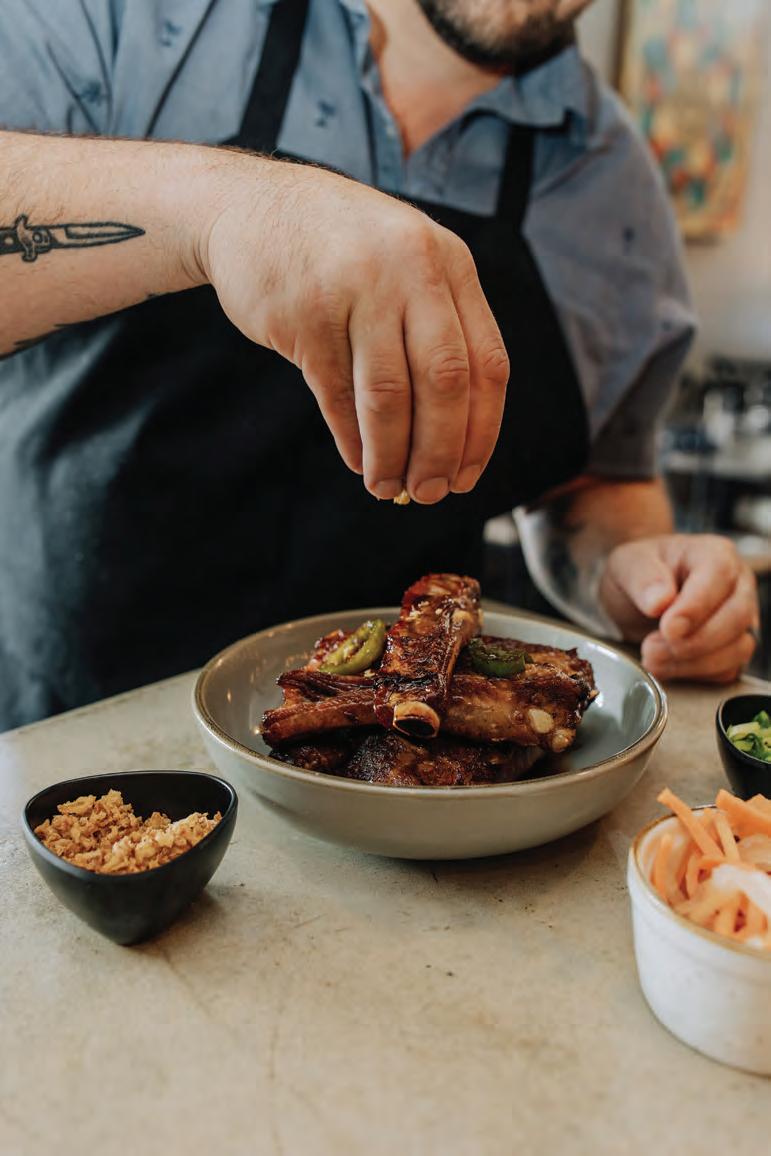
egg—named for Ramirez’s now six-yearold son Oskar. His four-year-old daughter June’s namesake dish is the vegetarian version, with house-made vegetable stock. “We roast a bunch of vegetables to make the stock and blend it with soy milk to make it creamy. It’s one of my favorite things,” he said. “I pour it in a coffee cup and drink it for breakfast.”
Celebrating almost four years at Chow Yum Phat’s overpass location, the ever-adventurous Ramirez has some new things up his sleeve. Next door, the beloved old watering hole George’s is now ZeeZee’s, a neighborhood bar and eatery Ramirez opened with other community partners in December. When word got around about opening a George’s-reminiscent community-centered concept (which also nods to the old Baton Rouge institution of Zee Zee Gardens) CYP’s proximity made it a no-brainer for Ramirez to get on board, creating a slightly-elevated barfood menu. Speaking on the success of the last six months, he is quick to salute the kitchen and recommend a menu favorite. “The made-inhouse pizza rolls are insanely good,” he said. “Every game, it’s packed. It’s a really cool atmosphere.”
A pinnacle of fresh ideas steeped in respect for Baton Rouge tradition, Ramirez’s last decade seems ever-seasoned by momentum. His gears are always churning. Speaking of his family, and their impact as sustaining inspiration, he mentions his admiration for his
sister Janie Ramirez’s venture as executive chef at Dai Due in Austin—a farm-totable restaurant where everything served is produced in Texas. “I’d love to go work there for a week one of these days,” he said. And I wonder to myself how long before he’ll conjure up a similar concept in Baton Rouge. It’s anyone’s guess. For
now, he is happy to credit his success to his wife, Erica. “All the things I’ve done inevitably led me to wanting to open a restaurant, and my wife giving me the support to go out and do this. I blame it on her, for better or worse.” •
chowyumphat.com

//AUG 23 53
FRESH-BAKED Rise & Shine
When an early pandemic lay-off inspired Kanya Michelle to launch her home-based bakery, Shreveport Cottage Homestead, she started out making old-fashioned holiday pies and scones. But then, she noticed a gap in the world of small-scale specialty bakeries: handmade buttermilk biscuits.
“There were already a million people in Shreveport making pies and all of these things, but no one was specializing in biscuits,” she said. “It was kind of surprising. A good buttermilk biscuit is a staple of Southern cooking, but they’re getting harder and harder to find.”

Two years later, with her recipes wholly developed, Kanya officially relaunched her business in the summer of 2022 as Shreveport Biscuit Company. Since then, she’s emerged as one of the star vendors at Shreveport Farmers’ Market, where her towering, Instagram-ready biscuit sandwiches have on occasion attracted an hour-long line of customers. Shreveport Biscuit Company has also released several varieties of frozen, ready-to-bake biscuits that are currently sold by local marketplaces and gourmet grocers in Shreveport, Haughton, Lafayette, Metairie, and New Orleans. With her biscuit-making operation rapidly outgrowing her kitchen, she moved into a commercial production space last September, hired her first employee in the spring, and has been looking at real estate for a potential brickand-mortar location.
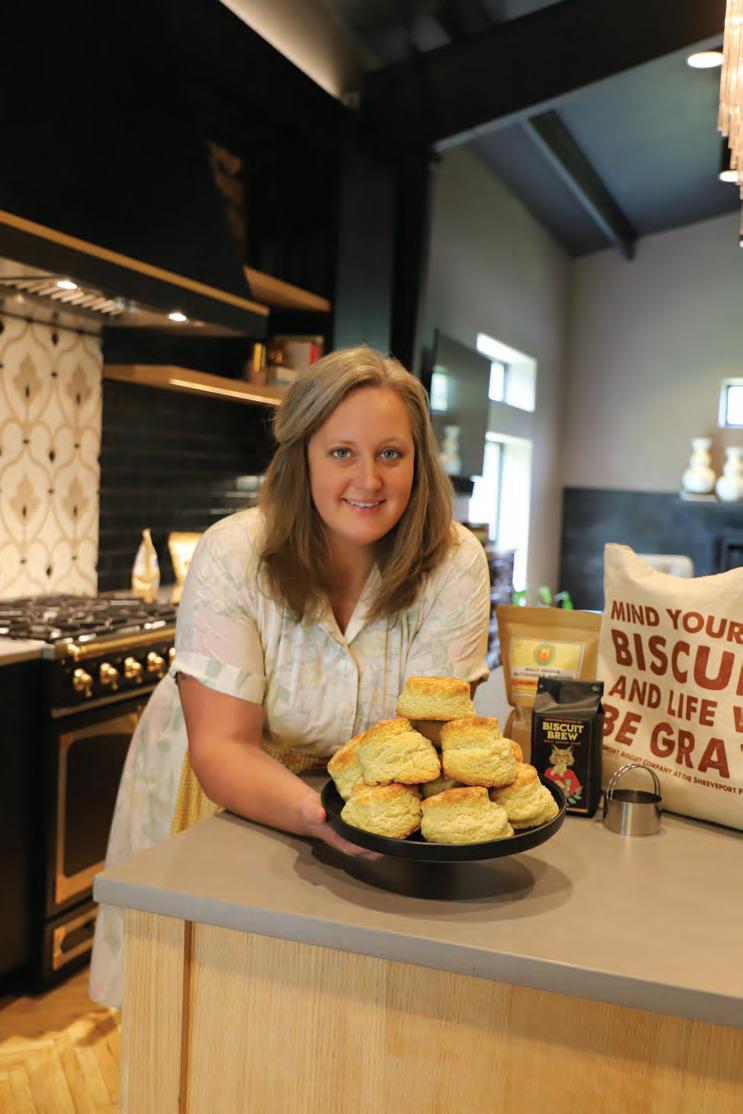
Kanya Michelle's biscuits are somehow dense and pillowy at once, tall, crisp-crusted, and outlandishly buttery without being greasy or falling to pieces. Each biscuit half is as substantial as a slab of focaccia, so they stand up well to toppings—making the way for Kanya’s regular releases of seasonal biscuits that incorporate “just about every fruit” as well as herbs, cheeses, and more. Her
biscuits-as-strawberry shortcakes are especially popular during the scorching summer months. Blackberries (which she uses in her top-selling biscuit) “belong in a biscuit; they come out almost cobbler-like.” Peaches? “Not so much.”
On the savory side, there are Kanya’s Louisiana-made kimchi and cheddar biscuits, as well as the cheese-and-pepper variety, which features minced jalapeños mixed into the dough while they’re “still kind of raw, so they retain their fruitiness.” Asked to name her personal favorite, Kanya appointed her blackberry biscuit stuffed with good, local breakfast sausage—a combination of sweet and savory flavors that “hits every biological craving note.”
In conceiving of her recipes, Kanya sources her ingredients with care and frequently teams up with other small Louisiana food businesses, creating small-batch releases more in the style of a craft brewery or streetwear company than a bakery. Recently, for example, she collaborated with Lafayette’s Bougie Bologna to create the “Bougie Biscuit”. She’s also collaborated with several local woman-owned small businesses like Sweetport, Goody Granola, Moonlight Harvest Mushrooms, and Special Reserve Coffee Roasters. She’s served a biscuit Monte Cristo and draped a buttermilk biscuit with rainbow-shaped sprinkles for Pride month. These aren’t your grandmother’s buttermilk biscuits—except when they are.
According to Kanya, the key to making great biscuits is incorporating the butter into the dry ingredients correctly. She chills her butter in the freezer before using a handheld cheese grater (“Not a box grater, but a grater with a handle— it’s a total gamechanger.”) to shred the butter into the flour mixture. She stores her mixing bowl in the freezer between batches, which keeps her biscuit dough cooler and makes it easier to handle. If she adds other ingredients to a batch
of dough, such as macerated berries or kimchi, she chills those ingredients as well, all in an effort to prevent the butter flakes from dissolving. Preventing the butter from melting, she said, “gives you even pieces of butter that produce moisture, flakiness, and pockets as the biscuit bakes.”
Kanya doesn’t quite feel like a chef, she said, but she doesn’t deny her wellearned expertise on biscuits. “It took me a good, long time before I felt like I had a solid footing,” she said. “It’s some
milk biscuit less than five years ago. She doesn’t have a passed-down family biscuit tradition or fond memories of rolling out biscuits while holding onto her grandmother’s apron strings. Before moving to Shreveport, she’d spent much of her adult life in Hawaii and New Jersey—not places exactly wellknown for their biscuit cultures. In the early days of Shreveport Biscuit Company, she struggled with imposter syndrome, anxiety, and self-doubt. But the relationships that she’s established with customers, market organizers, and other Louisiana food entrepreneurs have helped her gain confidence and stay laser-focused on growing her business.
“My friend group has become filled with women like me, small business owners who are trying to do more and are capable of doing more,” she said. “I feel really grateful for the couple of years of chaos that we all just experienced, for the way it all panned out. Five years ago, I’d never made a biscuit. Now, I can’t imagine doing anything other than making biscuits for the rest of my life.” •
Shreveport Biscuit Company’s frozen, ready-to-bake biscuits can be purchased at local marketplaces and fine grocers across Louisiana, including Sunshine Health Market in Shreveport, Mahaffey Farms and Station 80 in Haughton, The Market at Tops in Lafayette, Laughing Buddha Nursery in
Biscuit Company newsletter, visit
AUG 23 // COUNTRYROADSMAG.COM 54
SHREVEPORT'S KANYA MICHELLE IS LIVING PROOF THAT A GREAT BISCUIT CAN CHANGE YOUR LIFE
Story by Chris Jay • Photos by Christina Ogea
Kanya Michelle baed her first buttermilk biscuit less than five years ago, and now is Shreveport's bonafide biscuit queen. Photos by Christina Ogea, courtesy of the Shreveport Biscuit Company.
November 10-12, 2023


Louisiana’s Most Beautiful Food & Wine Event


Featured Events for 2023

Friday Night Winemaker Dinner featuring Miner Family Vineyards presented by Didier Consulting

St. Francisville Saturday Night at the Magnolia Cafe & 3V Tourist Court presented by Visit Mississippi

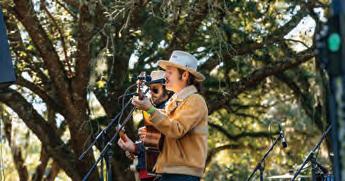
Sunday Grand Tastings at the Myrtles

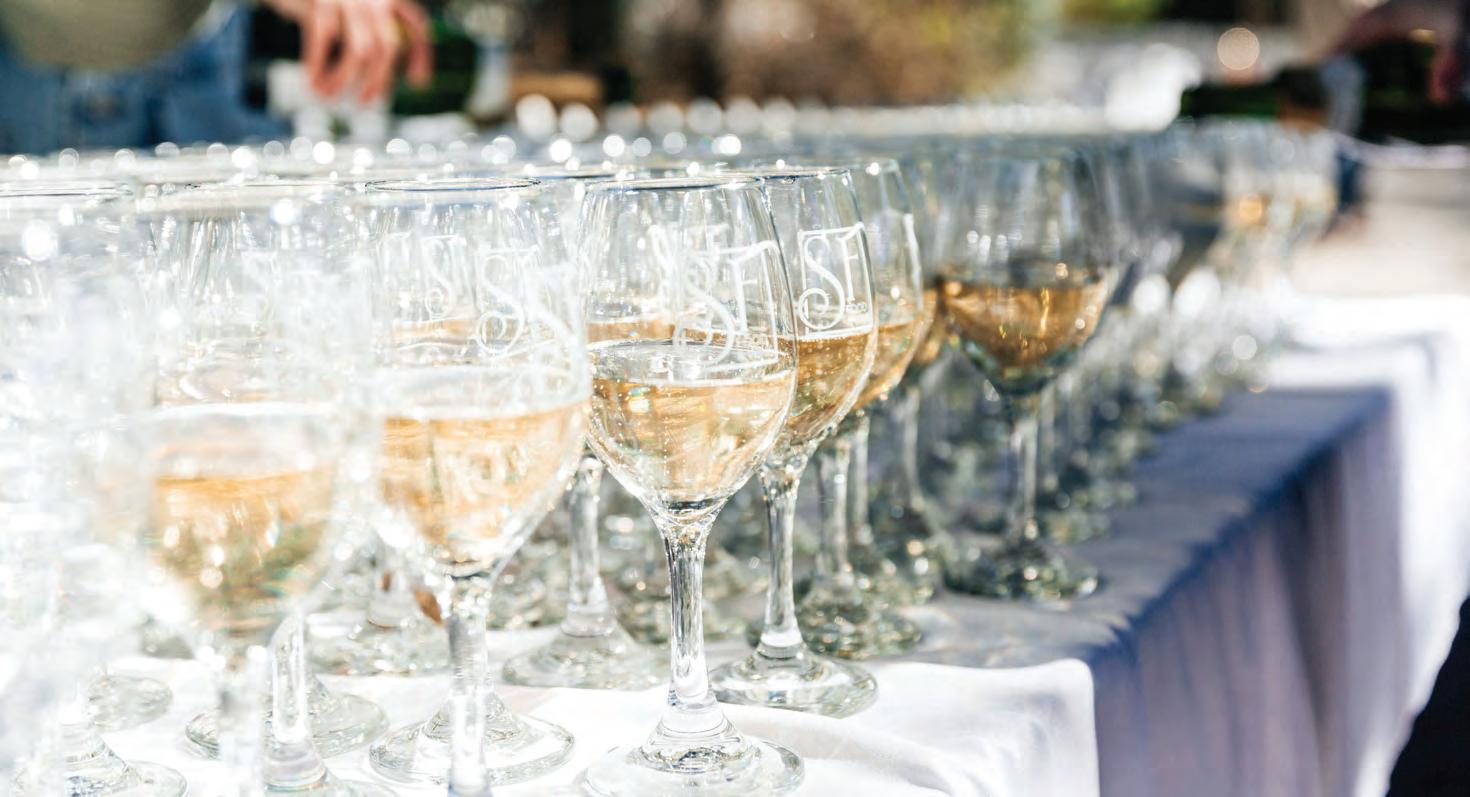
Craft Beer and Brats Garden presented by Bank of St. Francisville Spirits at the Myrtles’ Courtyard presented by Paretti Jaguar Land Rover




Country Roads People’s Choice Chef Experience presented by Williamson Eye Center City Group Hospitality Tasting Experience



Zero Proof Wellness Bar Presented by Pennington Biomedical Research Center Making Raving Fans Hospitality Group Tasting Experience


For Tickets Visit www.stfrancisvillefoodandwine.com

Presented with generous support from

//AUG 23 55
at the Myrtles, St. Francisville, LA

AUG 23 // COUNTRYROADSMAG.COM 56
TOP OF THE MORNIN'
Meyer the Hatter
Aclothes. One of the Crescent City’s most refined districts, Downtown was once a mecca of twentieth-century fashions. Men would dress in suits and ties, women in hand gloves and dresses. And almost everyone wore hats.
There’s a place where this old-time sense of style lives on; just make a right turn on St. Charles Avenue. Tucked between Rubenstein’s—a men’s fashion store that has been open since 1924—and a Marriott Courtyard is Meyer the Hatter.
Step inside the “South’s largest hat store,” and you’ll be transported: pastel-colored flat caps hang from the shelves, fedoras and straw hats are stacked on top of one another inside of and piled on of display cases, towering to the ceiling. Bowls are filled to the brim with 99-cent feathers in all different colors. At the corner of the store is a spiral staircase, leading to two additional floors where spring and winter hats are stored until the start of each season.
picking up a Shantung straw hat along the way—a Stetson Gulfport he designed in the ‘90s.
Sam’s grandfather, Sam H. Meyer, established the original 15'x15’ hat shop on the first block of St. Charles Avenue in 1884—calling it Meyer’s Hat Box and specializing in selling hats made by Stetson, a 158-year-old American hat manufacturer known for its unique cowboy-style looks. By 1934, his son, Andrew joined his father at the family business. In 1937, they moved the shop down the block.
Once they returned from their service in the Army Air Corps during World War II, Andrew’s sons, Sam Meyer II and William, began working full-time with their father. In 1961, the Meyers relocated Meyer the Hatter to its current location on St. Charles Avenue. Paul Meyer, Sam’s son, took over the business in 2009, carrying on the 129-year-old family business alongside his father, who still works at the shop three days a week.
Hats have always been part of the fashion landscape—for the most part. According to Paul, they fell out of the mainstream between the ‘60s and ‘70s—until John F. Kennedy reignited the accessory’s popularity by wearing a top hat at his inauguration and holding it in the air at the parade.
“It’s been pretty steady since,” Paul said. “The hats still serve a purpose. They complete your outfit.”
The business has expanded since its days of limited collection lines from Stetson, Dobbs, and Kangol. Now, Meyer the Hatter sources its hats from wholesalers all over the world.
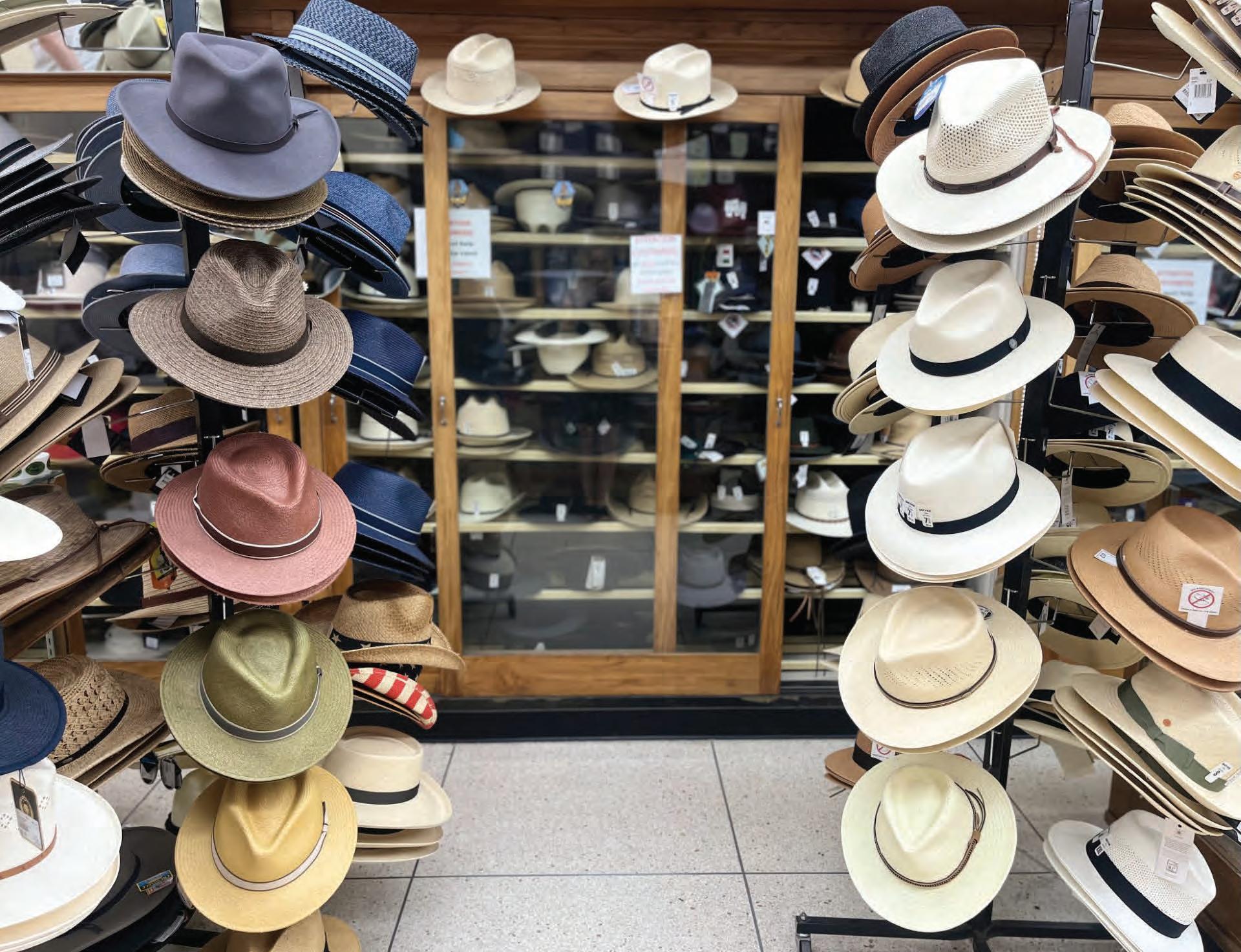
The shop’s selection of Panama straw hats comes from Ecuador, the Raffia hats from Madagascar, the berets from France. The Shantung hats come from China and Japan. The Meyers also partner with American factories located in Pennsylvania, Michigan, and California. Of Meyer the Hatter’s entire collection, dress hats—such as fedoras—are the top-seller. “This is our business,” Paul said. “This is our livelihood. We keep it going.” • meyerthehatter.com
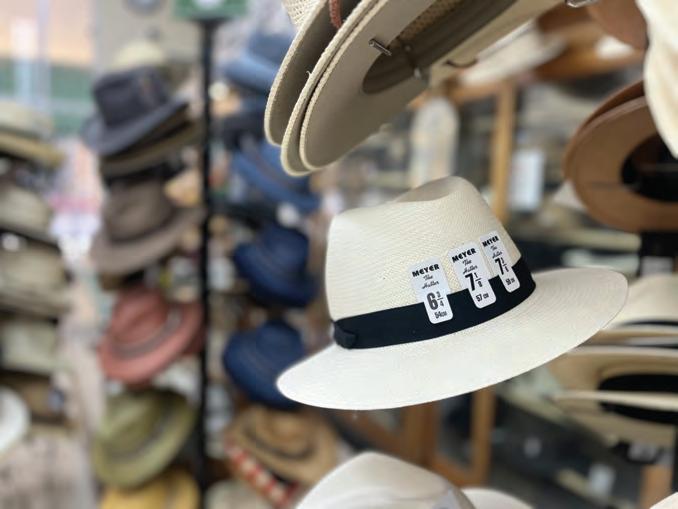
//AUG 23 57
-
NEW
CAUTIONARY AUGUST 2023 Culture
BY DESIGN
57 TIMELESS STYLE ON ST. CHARLES STREET // 58 AN ANCESTRAL JOURNEY THROUGH LOUISIANA'S PLAN
TATION COUNTRY // 62 THE GENIUS OF ALL THINGS "POP BUILT" // 63
ORLEANS'S
INSIDE THE "SOUTH'S LARGEST HAT STORE"
Story and photo by Poet Wolfe
Strange True Stories of My Louisiana Ancestors, Part III
PILGRIMAGE TO PLANTATION COUNTRY Story
Parts I and II of Flournoy's "Strange True Stories" series can be found in our April and May 2023 issues, respectively, and on our website at countryroadsmag.com.
It was November 2020, in the thick of a global pandemic and following back-to-back hurricanes, when hI found myself driving through South Louisiana, down I-10, then I-310. On River Road in Destrehan, I stopped to view Hans Geist’s massive “Mile of History” mural spanning the wall outside River Road Market, illustrating 300 years of St. Charles Parish history. I jumped back in my car, proceeding south on Hwy 90 towards Morgan City.
Elevated sections of highway ribboned the damp terrain, preserving the natural beauty of bayous, swamps, and rivers below. I passed a sign for Des Allemands in St. John the Baptist Parish, where Highway 90 parallels the Old Spanish Trail, weaving through craggy cypress trees draped with moss, like shadowy George Rodrigue paintings. I crossed Bayou Lafourche near Raceland and the Atchafalaya River bridge into Berwick before bending north toward Patterson. Along the way, historic markers staked the plantation-dotted landscape, some bearing the names of my ancestors.
They were, after all, why I came. I had followed the spiritual pull to connect to these places that figured so prominently in my lost family history. I wondered if historic markers might be the only thing left to link me here.
My ongoing quest to trace the history
of the Charpantiers, who fled the French Revolution and settled along Bayou Teche in St. Mary Parish, now expanded to ancestors throughout South Louisiana, including the “German Coast” of the Mississippi River. In the 1720s, French leaders lured German settlers to Louisiana to help tame the wild, unruly land. Despite severe hardship, the Germans flourished and blended with the French, sprinkling my French line with German names.
Tracing my paternal Planchard/Roussel line through the region, I found several properties once owned by relatives, some still standing. I created a map, intending to visit as many as possible.
Mostly, I wanted to visit the original land where Joseph Charpantier and his wife, Marie Adelaide de Tavanne, (or Alix de Morainville) built their plantation. Researching Attakapas region land grants in the Library of Congress, I stumbled across a rare 1795 map charting planters in the region, and an obscure document referring to “Charpantier’s Bend,” which corresponded with land records for Charpantier Plantation. Magnifying the planter map and turning it sideways, I could barely make out the names of property owners. Then, bam —I spied the name "Charpantier" scrawled at a bend in the river where Bayou Teche meets the Atchafalaya River.
Comparing the bend on the old map
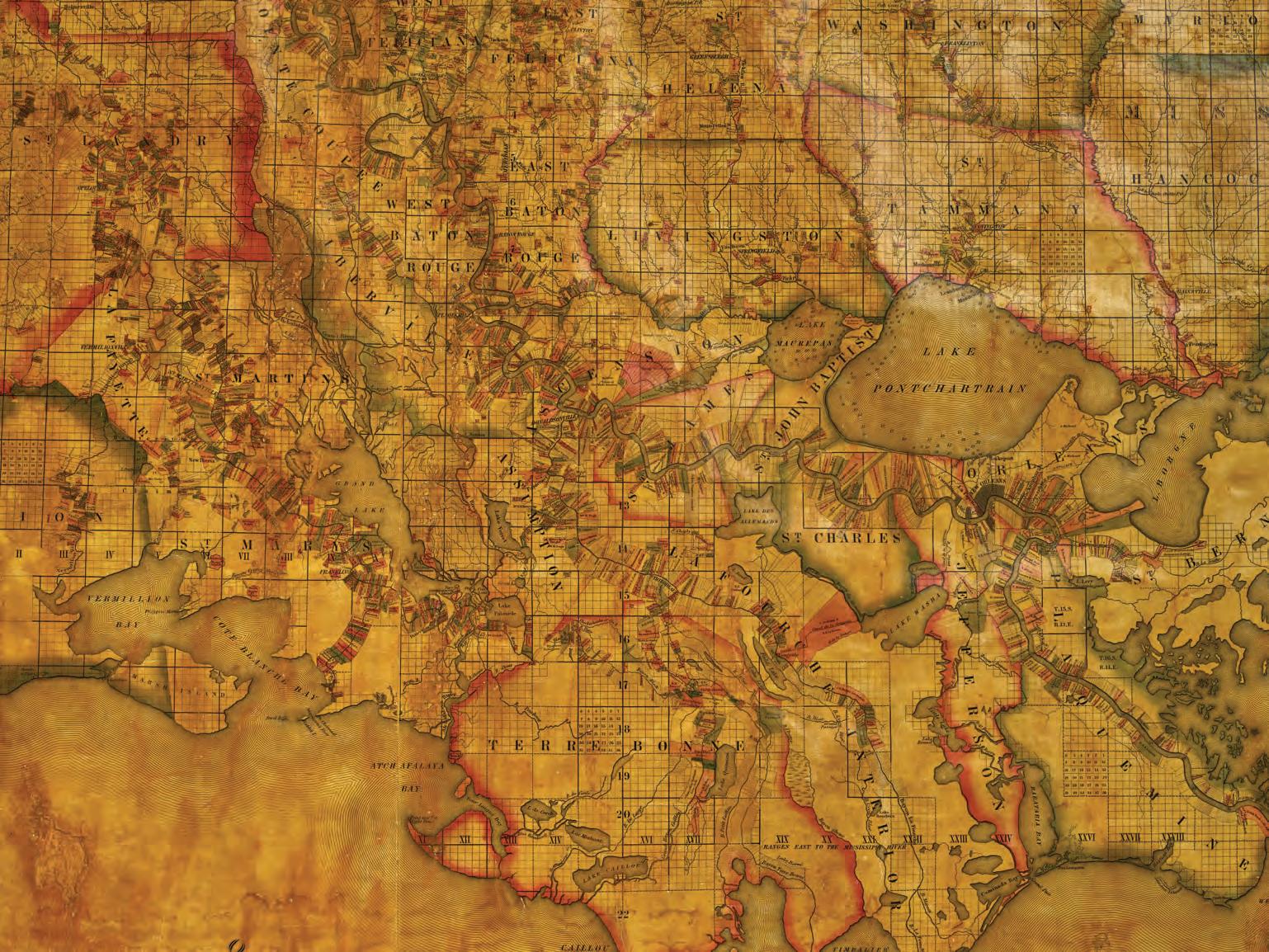
with the same location on Google Earth, I zoomed in, searching for houses or businesses—finding nothing, just a vast sea of sugarcane fields stretching for miles, with only one dwelling—a steel fabricating company. The guy who answered the phone told me the land next door might be owned by the Aucoins or Hymels. An online phonebook for Patterson listed several Hymels and Aucoins, but gave no addresses.
Going down the list, I politely relayed my spiel about tracing ancestors again and again. Some assumed I was a scammer or trying to sell something, but after about six calls, I hit pay dirt. Merry Hymel listened patiently before asking, “So wait, you’re who and you want to do what?”
I started over. She seemed to remember mention of the Charpantier Plantation associated with her family’s land, but she didn’t know the history. “I understand,” I conceded. “I only want to walk on my ancestors’ land and maybe take some dirt as a memento. I’m coming through Patterson next week and I need permission to be on the property.” I pictured a shotgun-toting farmer taking aim at me, unleashing a pack of snarling hounds.
“Okay, I guess that’s fine,” she said in a weak voice, still leery.
I hung up feeling like I’d won the lottery. I had. An hour later Hymel called back to say that her family could show
get.” She called again the next day with a few names and numbers of residents who would know the history of the area. “Tell them I told you to call.” Hymel also gave me the number for Idlewild Plantation, directly across the bayou from the Hymel property. As luck would have it, Idlewild was already on my planned map, as it was built by my ancestor, Georges Haydel (Heidel).
By the time I called Idlewild, I had repeated my speech so many times I sounded like a robocall, but now I held an ace. “Hi, Merry Hymel gave me your number. I’m researching my family history in St. Mary Parish. My fourth great grand-uncle built Idlewild Plantation, and I’d like to see it when I visit the area next week.” He agreed to meet with me. The trip was on.
Deeper south, the drive started to take on a middle-of-nowhere vibe. I punched in GPS information for Idlewild Plantation on the Lower Atchafalaya River, southeast of Patterson, where I had set up the first appointment of my trip.
Even the GPS screwed up the directions, leading me down a series of deadend roads before I found the quiet treelined lane leading to Idlewild—a classic white-columned raised Greek Revival plantation home, guarded by enormous oaks. When I called the week before, a man who went by the name Captain Caviar (or John Burke, owner of Captain
AUG 23 // COUNTRYROADSMAG.COM 58
GENEALOGY
A
by Nina Flournoy
A portion of John La Tourrette's historic 1848 reference map of Louisiana showing land ownership and plantation boundaries in the regions around Idelwild and the Hymel property where the author's ancestors once lived, photographed by Carol Highsmith in 1946, on display at the Great River Road Museum at Houmas House. Library of Congress.
Caviar Swamp Tours), told me his mother lived at the plantation, so it wasn’t open to the public. “But tell you what, come on by and we’ll give it a try.”
The epitome of a sea-faring captain, with full, graying beard and navy cap, he showed me around his quaint white house on the grounds of the property. Unusual items on the walls and shelves included nutria slat boards used by Acadian fur trappers, and a taxidermy plaque of a Choupique (Shoepick)—a 200-million-year-old species of fish still thriving in the Bayou Teche, which flows about ninety feet from his back porch. Most fishermen consider Choupique a “trash fish,” but Captain regards it as a treasure.
Having grown up traversing the bayou, he discovered that the Choupique’s eggs made delicious caviar. After learning how to harvest and package the eggs, he created the Louisiana Caviar Company in 1986. Area seafood connoisseurs discovered his successful enterprise, including famed New Orleans Chef Emeril Lagasse, whose wife Alden Lovelace bought the company a few years ago along with partners Amy Hollister Wilson and Alison Vega-Knoll.
Now with time on his hands, Captain started a swamp boat tour from his backyard dock, retaining the name “Captain Caviar”.

As he escorted me across the lawn toward his mother’s home, I hooded my eyes to admire a towering live oak, with
one grand limb sloping to the grass. Captain nodded, “Yeah, people pull off the road to take photos of our tree all the time.”
When I stepped back to get a photograph, he matter-of-factly stated that the 477-year-old tree is haunted, as is his home and the main plantation house, since long before his family moved there in the ‘70s. A ghost-hunter crew for the Travel Channel’s Ghosts of Morgan City had even allegedly captured an image of a female spirit in the main house, moving across his mother’s dining room.
“We didn’t need anyone to confirm it. We’d seen for ourselves. Others have too,” he said, recounting a crawfish boil when a guest pointed up to a young girl peering out of the top window of Captain’s house. “Everyone saw her. Then she vanished. That’s the attic. No one goes up there.” He said a few psychics and a shaman believe at least three hangings took place from the oak tree. “I’m not surprised, considering the history of the area,” he shrugged.
No telling when or if those hangings occurred, but Burke’s right about the history. In this corner of Louisiana known as the “sugar parishes,” vigilante lynching went on well beyond Reconstruction. From 1877 to 1950, 549 “racial terror lynchings” were reported in Louisiana, the fourth highest rate in the country, according to The Equal Justice Initiative. More than one hundred took place here
in sugarcane country, where lynching statistics tell only a fragment of the larger story—starting with the enslaved labor-dependant plantation system itself.
You can’t walk beneath oaks like the one at Idlewild without sensing the weight of history each ring holds. The numbers make it tangible. In 1795, the year Joseph and Adelaide settled on Bayou Teche, Louisiana’s enslaved population numbered less than 20,000. By 1840 it climbed to around 168,000, soaring to more than 331,000 in 1860—rising with the sugar and cotton industry in the region, which made Louisiana’s 22,000plus planter/slaveholders the wealthiest in the nation. The year the Civil War broke out, Louisiana produced about one-sixth of all the cotton grown in the United States and all of the sugar. This is where the planters in my family line made their fortunes.
The high-risk, high-cost business of sugar cultivation did little to deter planters who knew sugarcane’s enormous potential for profits, and the subsequent generational wealth it guaranteed families. They understood the human cost of their business, too, and proceeded regardless. Sugarcane cultivation was brutal, demanding numerous hands to carry out often back-breaking labor. Enslaved families working on cane plantations in Louisiana died at a substantially higher rate than those working in cotton, tobacco, indigo, or rice farms. To keep sugar
production going, sugar barons simply replaced the enslaved who succumbed with a steady flow of young Black men coming through the auctions in New Orleans.

Of course, I knew my Louisiana planter ancestors were unapologetic slaveholders, but until I was here, standing on their soil, I had never allowed the horrifying reality of that history to thoroughly wash over me. But here it is, everywhere.
Walking toward the main house, Captain pointed out a rut in the grass, running the length of the lawn. “You’re walking on what was once the Old Spanish Trail.” The system of east-to-west trails dates to the 1600s, when Spain controlled all of Louisiana, and once extended through swamps, deserts, and mountains, linking Florida and California. Confederate and Union troops took this path during the Battle of Bisland. During that campaign, Union General Nathaniel P. Banks used Idlewild for his command post, forcing the Haydel family out. After the war, Union Captain I. D. Seybern, who had served in the vicinity, bought the property. It remained in the Seybern family until the Daniels purchased it in 1977.
My ancestor Georges Haydel (Heidel) had originally built the house for his daughter in 1850. His Heidel ancestors, whose name became Haydel, arrived in Louisiana in the early 1720s. They were among the first to settle the rugged
//AUG 23 59
ANGELA GREGORY:
Portraits & Process
August 18, 2023 through August 11, 2024
Opening Reception
August 18, 2023
6 - 8PM
"MY FRENCH ANCESTORS AND THEIR DESCENDANTS REFLECT THE SOUTH LOUISIANA STORY—A BITTER-SWEET BLEND OF CAJUNS, EUROPEAN IMMIGRANTS, AND ENSLAVED AFRICANS, CULMINATING IN A CREOLE BLOODLINE STEEPED IN STRUGGLE, GLORY, TRAGEDY, PRIDE, AND SHAME. WAR AND HARD TIMES SENT THEM SCATTERING, LETTING TIME ERASE ANY SIGN THAT THEY EVER LIVED ON THIS SPOT.



German Coast. In time, they became wealthy planters, building several significant sugarcane plantations, including two that are still standing: Evergreen and Haydel Plantation, better known today as Whitney Plantation.
Today, Whitney holds the title of Louisiana’s only former plantation site to exclusively center its activities around the history of enslavement that took place on its grounds, and at every plantation in this region. There is little doubt that Georges Haydel depended on enslaved labor to construct Idelwild (and certainly on the riches their labor created to fund it), which was once situated on an 800-acre dairy farm and sugarcane plantation. The 1850 slave census listed him as the “owner” of thirty-four enslaved people, all of whom worked at his sugar plantation in St. Mary Parish. He died before Idlewild was completed in 1854.
Though of German descent, Haydel designed the plantation house using English and French features, while incorporating Dutch details, reflecting Patterson’s stint as a Dutch settlement in the early 19th century. Idlewild’s hallless layout features French doors between rooms, front and rear galleries, five fluted Doric columns, a full entablature with denticular cornice, a continuous brick wall encircling the foundation, three dormers, a graceful roofline, and ornamental cast-iron balustrades. The enslaved people who lived at Idelwild stayed in quarters beneath the main house.
Captain peered into the French “guillotine” sash windows before knocking on the door. Through transomed side-light windows, I could see his mother, Pam Daniels, releasing the locks.
“Mom this is Nina Flournoy. The house was built by her great-great-great grandfather or something,” Captain began.
I apologized for the bad timing, with a pandemic sweeping the country. “I totally understand if you’d rather I stay outside. I could just walk around the grounds if that’s okay.”
Sizing me up for two seconds, she graciously pushed open the screen door. “After you’ve come all this way? Please, come on in,” she said.
Stepping onto the varnished hardwood floor, I felt instantly transported. Worn brass knobs, heavy paneled cypress doors, cypress aedicule motif mantels, and crochet table clothes all denoted a place lost in time. Daniels eased through each room, pointing out the tall gallery windows with jib doors, an upholstered “shaving chair,” chandeliers, and a vintage etagere displaying an exploded Civil War musket ball discovered on the property by Daniels’ late husband Dr. Walter H. Daniels.
A gable at each end of the 5,800 square foot “cottage” has a balustraded balcony resting upon slender columns. Captain led me through one rear room to a narrow, enclosed staircase. As we ascended the dimly lit stairs leading to the attic, he relayed the “blue shirt” story.
“One night I rounded this corner and saw a blue shirt going up the stairs. Just a blue shirt.” When he tried to flip on the light, it didn’t work, and hasn’t worked since that night, despite electricians’ many attempts to fix it. “The Union army wore blue shirts,” he noted. The Travel Channel medium concluded the apparition was most likely a nurse from the Yellow Fever epidemic named Nina Nordoff.
A group of Ursuline nursing nuns also occupied the house for a time, living on the upper floor when it served as a Civil War hospital. Daniels pointed to a rectangle cut-out on one wall, where nuns scrawled a message in French. The former owners added a translation underneath: “Study your profession with care and you will become wise, work hard and you will become rich, be frugal and temperate and you will preserve your wealth, be just and you will not fear eternity.”
Among the abandoned items Daniels’s family found in the attic were pieces of early 19th-century apparel: pantaloons, lace frocks, a silk bustle, and hats—which she carefully restored and displayed—alongside the elaborately beaded ball gown she wore as queen of a Mardi Gras krewe in New Orleans, where she grew up. She mentioned that, like I, her brother had long researched her Normand and Goudeau family lines in New Orleans.
AUG 23 // COUNTRYROADSMAG.COM 60
YET, HERE I WAS."
with music by Sariah Storm & The Mysteries
She showed me a rare photo she’d found of Union officers and nurses posing on the front steps when the house served as a hospital. In the shot was Captain Seyburn, who bought the house after the war. Daniels called my attention to a nurse seated in the middle of the shot. “We’ve identified her as the woman we see walking through rooms from time to time,” she said .
“Are you ever afraid here?” I asked, and immediately wanted to kick myself, since her husband had passed just the year before and she now lived in the house alone.
“No,” she shook her head, theorizing, “Maybe time simply overlaps. I don’t think they know we’re here.” Daniels said many residents of old homes in the region report similar spirit sightings, and most consider it part of the terrain.

After admiring a mural she painted depicting the view of Bayou Teche from her kitchen window, we said our goodbyes. Outside, Captain pointed toward the bayou. “You can see the Hymel land right there.” I held my throat, struck by the sight of the banks where Alix and Joseph first set down their American roots.
Captain told me to take Main Street through Patterson, turning north onto Bridge Road, and crossing the short bridge over Bayou Teche. From there I followed Merry Hymel’s directions, heading east on Par Road 108 before turning up the dirt road. I smiled recalling her South Louisiana accent on the phone. “Dirt? You want dirt?”
I explained that after searching for years, I had finally pinpointed the location of the Charpantier land. “I’m going to put some dirt in a container to represent my family’s little piece of the original property.” She liked the idea and mentioned that her son and niece also have a house on the land.
Going up the long dirt finger toward her son’s house, Hymel’s daughter-in-law Ashley approached my car, wiping her hands on her jeans. “We’re boiling crabs out back,” she smiled. “You’re welcome to join us.”
Ashley walked me out to where they estimated the original home might have stood. I told her my relatives were among the first sugarcane planters in the area. Regional historian Shane Bernard told me that the Union Army badly damaged the Charpantiers’ main house during the war, but I don’t know what happened to their sugar operation.
We approached a shed where the Hymels had collected several corroded hand-forged pieces discovered over the years. “They made their own tools,” Ash-
ley said, as her husband, Bill, approached. “Take whatever you want. If it means something to you, feel free to take any of it.”
I picked up a rusty metal nut. “I’ll just keep this small one. Anything more might be tough to explain to airport security.” I wrapped the crumbling metal piece in my eyeglasses cloth and stuffed it in my pocket like a chunk of gold.

Strolling the expansive landscape felt like walking inside a painting. Laced oak, pine, and cypress branches formed a natural boundary at the water’s edge, where smooth black cypress knees poked out of the bayou. The sunset’s gold-orange light rippled atop the inky water and streamed through trees, throwing shadows across the grass. Just beyond a thick growth of ferns, a lady glided toward us.
Hymel wasn’t at all what I expected from her voice on the phone. A lovely woman with wavy salt-and-pepper hair, she looked at home in her worn jeans and denim shirt. I pegged her as a beauty who brushed off lifelong compliments and, rather than paint her nails, chose to get her hands dirty. Literally. As I gushed over the picturesque property, Hymel divulged that she’d studied landscape design at LSU. This place was her masterpiece.
The two women pointed out indentions on ancient trees, deep ruts, wells, and other clues as to how the Charpantiers might have lived. Hymel suggested a particular spot where I should dig. Scooping dirt with the screw-top lid, I packed the jar to the brim. I imagined generations of Charpantiers—Marie Adelaide, Joseph, their son Michel, their grandchildren, and great-grandchildren—milling among us, tickled that blood kin made the effort to acknowledge the land where they thrived. My French ancestors and their descendants reflect the south Louisiana story—a bitter-sweet blend of Cajuns, European immigrants, and enslaved Africans, culminating in a Creole bloodline steeped in struggle, glory, tragedy, pride, and shame. War and hard times sent them scattering, letting time erase any sign that they ever lived on this spot. Yet, here I was, one of their own, kneeling beside the Bayou Teche in the very dirt where they first began building their family after leaving France.
Maybe Daniels was right. Maybe time does simply overlap.

Driving away with dirt under my fingernails, I swore that if I did nothing else that week, I’d be gratified to have just done that. But, as it turned out, my trip had just begun to get interesting. •
Post script: Upon returning to Dallas, I discovered that I’m a distant relative of the Hymels through my St. Mary Parish relatives. This means that the Hymels are related to the Charpantiers—the original owners of the land on which they now live. And, not only am I related to the Feltermans, but the Normand branch of Pam and Captain’s line intersects with my paternal line—not through my St. Mary Parish relatives but linked to my New Orleans family. Small world. —NF
//AUG 23 61
IN THE NEIGHBORHOOD
Unsung Designs
STRINGBEAN SUPPORTS AND HOMEMADE AIR CONDITIONERS
By Ed Cullen
People who design buildings must combine form and function. Their designs excite the brain while holding gravity at bay. Function designers are willing to sacrifice aesthetics for practicality. Our work doesn’t have to be pretty, just stand up to a stiff wind.
As the summer wears on, I delight in the garden support constructions of friend John, a retired physician. It has never surprised me to learn that a person I first knew as a surgeon turned out exquisite furniture in a woodworking shop clean enough to perform surgery. Whether you’re building stringbean supports or repairing broken bodies, your brain, eyes, and hands have got to be working together.
John, a pediatrician, once helped design a device that removed skin lesions by freezing. These days, he more often designs what look like tram systems of cane poles to support vegetables that haven’t the sense to stop growing.
In my garden, there is a whimsical birdhouse made of metal, round in its body, and topped by a conical roof. It’s ornamental, not meant for occupancy, because the roof isn’t attached. The roof sits atop the bird house until the wind blows it off or it’s unseated by the vibration of a passing garbage truck.
Each year, little brown birds build intricate nests that fill the cylinder of the ersatz bird house. When the top blows off, and I discover the event soon enough to reseat the roof, the family of birds stays on. My inattentiveness may cause occupants to leave early. This I regret, but, as I’ve said, it’s an ornamental house that birds have adapted to their use.
My Uncle Floyd once designed an air conditioner as impractical as my bird house. He stuffed hay between two sides of wire to make a straw sandwich. The hay burger he attached to one side of a window fan he stuck in a window. He rigged a garden hose to drip water through the straw. In theory, a breeze passed through the dripping hay to cool the room.
This might have worked out West where the humidity is low, but my uncle’s design studio was in humid south Arkansas. I became his guinea pig when I arrived by train for my summer stay. After one night under the contrivance, I awoke to find my pajamas and bed clothes soaked.

“That’s it, Floyd,” said my Aunt Lucille. “Get rid of that thing or you’ll be the one to tell your sister her son drowned in his sleep.”
As I’ve grown to something approximating adulthood, (I’m seventy-seven this month) I’m attracted to things colored screaming neon: green, orange, yellow, blue. It started with water pistols and persists in my choices of smart phones.
I’ve designed a few things of my own; for instance, garden gate hinges from the leather tops of worn out Birkenstocks and a shed door closer that employs a coat hanger and weight. One of my grandsons calls my mechanical doodles “Pop-built.”
“Is this Pop-built?” Emerson asked as we hauled our bicycles across my favorite piece of neighborhood designwork. It’s a stile for pedestrians and cyclists. The land bridge lets residents of adjoining neighborhoods avoid Highland Road south of LSU by passing through a hedge on a low ridge. There is a gap in a fence left from the days when cattle grazed. Going through fence and hedge over the stile is like stepping through a time portal. I didn’t build the stile. It’s made of concrete, a medium I’ve never mastered. There are steps for feet and a ramp running beside the steps for the wheels of bicycles. It is the design work of a psychiatrist who lives across the street. Another example of a medical person turned practical clinician.
My father-in-law—the family’s first Emerson—quoted Shakespeare, understood the stock market, and was the kind of teacher who taught his children things they needed to know. He hung his old suits on a post by the barn as a scarecrow and clothes horse. He designed a board and batten house for his tree farm, using lumber milled from trees on the place. He designed a hog barn, which became an outdoor bathroom for a granddaughter who refused to potty in the woods.
As my street’s stand-in grandfather, I have made friends with a neighbor named Ory, four. Early this summer, Ory followed a simple pattern I dug in my garden to plant seed potatoes in hopes of getting French fries. Brother Anders, two, provided comic relief, spinning the propellors of whirlygigs I’ve restored after visits from other short people.
Ory and Anders arrive at my frontyard garden in an electric car. The boys have placed Anders’s scooter in the car’s open trunk. They are men of the open road with designs on travel, until their mother discovers they’ve momentarily escaped the pull of her gravity. She reins them in with a voice designed over the ages to exact obedience.•

AUG 23 // COUNTRYROADSMAG.COM 62
The Man Behind the Myth
DID BERNARD DE MARIGNY REALLY BRING THE GAME OF CRAPS TO THE NEW WORLD?
By Kent J. Landry
Picture the old man on a quiet morning, walking slowly along the banquette through the neighborhood that bears his name—perchance reminiscing about his younger years, back when his feet were nimble and his dueling hand steady. Right in the middle of this early suburb of New Orleans lays the street now known as Burgundy. Once, though, it had another name: that of the game that brought the old man much notoriety: Craps St.
In 1868, Jean-Bernard Xavier Philippe de Marigny de Mandeville—better known as “Bernard de Marigny”—was eighty-two years old; just a shell of his former self. Having lost most of his fortune, he spent his days wandering his neighborhood, the Faubourg Marigny (pronounced Mary-Knee), the tract of land carved out of his father’s former plantation. Sitting out on his front porch in his night clothes, this man wrote down his memories of past exploits and Louisiana’s storied history. Looking at him, passersby would hardly believe that the man was once a rich landowner, stately politician, real estate developer, and author; but also a playboy, a rogue, slave owner, and gambler extraordinaire. Those same people would have no idea that this old man hosted the Duke of Orleans; would scarcely believe that he helped persuade Andrew Jackson to allow the pirate Lafitte and his ragged band of Baratarian pirates to assist in defending the city against the British on the plains of Chalmette. They wouldn’t know that the tired old man was once President of the Senate, helped write the first state constitution, and twice was a candidate for governor.
Within the lore of New Orleans’s history, the story goes that Marigny died nearly penniless, his fortune drained from his gambling debts, most notably from craps, and was thus forced to partition his family’s land, living out the remainder of his life in relative poverty and obscurity. This tale has been retold and perpetuated so often to each successive generation that it is now stated as fact. However, Bernard de Marigny de Mandeville’s story should not simply be distilled to the whims of a dice game, since the true story of his life, in truth, is grander and more intertwined in the fabric of New Orleans than a game of chance. So, it is into this assertion and the life of the man himself—a model of Creole aristocracy, fond of wine, women, duels, and dice—that we delve.
Jean-Bernard Xavier Philippe de Marigny de Mandeville is the namesake not only of the city of Mandeville
just over Lake Pontchartrain from New Orleans, but also to the funky neighborhood just east of the French Quarter, commonly known as Faubourg Marigny. And of all the enigmatic and eccentric people that are a part of the rich history of gambling in Louisiana, he was one of the most colorful.
Marigny was a leading man of his time. Born in New Orleans in 1785, he was the son of a prominent French family who had ties to the early settlement and administration of the Louisiana colony. After his father died when he was fourteen, Marigny, headstrong and spoiled, was sent by his guardian first to Pensacola, Florida and then overseas to England, perhaps to be polished into a respected gentleman. Due to his insouciant attitude toward commerce, however, and the fact that he spent more time in gambling establishments than in respected places of business, Marigny was eventually summoned back to Louisiana. It was said that during this sojourn overseas he learned the game of hazard, a forerunner of craps. While the actual inventor of craps may never be known with certainty, it is widely accepted that Marigny brought the game back to New Orleans in the early 1800s, and was responsible for its rapid spread in the New World.
The much-repeated apocryphal tale seems to have come from one main source: a small opuscule by the writer Edward Tinker called the Palingenis of Craps. Published in 1933, this unsourced book—of which only four hundred copies were printed—paints a glowing picture of Bernard Marigny, described as a “swaggering, gallant, fantastic figure,” who lit his cigars with ten dollar bills. Though Tinker was a respected writer of his time, this fanciful book is steeped in the oft-exaggerated, glorious mythos of old New Orleans.
Other writers took hold of this story and expounded upon it. John Churchill Chase, in his entertaining and enduring book, Frenchmen, Desire, Good Children and other Streets of New Orleans, detailing the origin of street names in New Orleans, expands on this craps theory by explaining that the term “craps” was itself derived from derisive comment made by Kentuckians who floated down the Mississippi River to unload their goods in the port of Orleans. The Creoles and “Kaintocks”—as the Americans were derisively known—were at odds over the economic soul of the city. Chase espouses the Kentuckians responded to the slur by calling the French Creole elite "Johnny Crapaud". In French, "Crapaud" means “Frog,” and the insult was thought to be either in reference to the
fact that the French ate frog legs or because they appeared froglike, bent over the tables playing the game introduced by Marigny. The scornful term was shortened to simply ”craps” after the American gamblers took up the game. No frog legs needed.
Other sources dispute these claims, and any gambling historian worth their dice surely knows that a version of craps had been played for hundreds of years before Marigny. Roman soldiers were said to have played an early version of the game using pig knuckles as dice and their shields as a table, from which we deduced the term “rolling the bones.” And an early cousin of craps, the English game called hazard, was said to have been invented by Sir William of Tyre while he laid siege to the city of Hazarth during the Crusades. Arab people also have claim to craps, as they played a similar game called Al-Dar, which means “dice” in Arabic.
What we do know, as pointed out in The History of Gambling by the prolific underworld writer, Herbert Asbury, is that craps was played in pre-revolutionary France, and that bets had been wagered on rolls of the dice long before the sharpening of the guillotine and the rolling of heads. Based on Asbury’s contention, I would have to concur that it is more than likely the game, instead of being brought back to New Orleans from his journeys abroad, was rather introduced to Marigny by the Duke of Orleans during his visit to Marigny’s father in 1798. It is wholly conceivable that the Duke, the future King Louis Philippe, waiting out the bloody revolution in his home country, taught the promising young lad the game as they enjoyed long afternoons escaping from the stifling Louisiana heat.
Though there is little doubt that Marigny was responsible for spreading the game and increasing its popularity, the unsubstantiated claims of Marigny teaching everyone he knew the dastardly dice game and then losing to everyone he played until his fortune was vanquished, thereby having to subdivide his property to pay for his debts, is hyperbole at best.

In truth, Marigny did lose much of his fortune and sold off the vast majority of his property, as he himself admit-
ted in his twilight writings. However, author Scott Ellis in his book The Faubourg Marigny of New Orleans makes the claims that Marigny’s economic downfall was more the result of the Panic of 1837—which ended the tariff on imported cotton and caused many plantations to file for bankruptcy—and the disastrous crop failures of 1850 and 1851, than it was to craps. This was also, lest we forget, the era of the American Civil War—which devastated the slave-dependant economy of the entire region. It was a recipe for dwindling fortunes.
Today, craps is played in every major casino in the world. If it’s not the most popular table game, it is usually the one where people are having the most fun. All the yelling and hollering you hear in a casino is probably coming from the craps table. All those things would have probably happened anyway, if it weren’t for Bernard Marigny—but then again, possibly not.
So, as we tumble over Bernard Marigny’s bones and ponder his influence on the game of craps and New Orleans, it’s impractical not to acknowledge all that he was: the gambler, the politician, the scamp and mogul, the real estate tycoon, the slave owner, and the head of the Creole aristocracy. A man of his time, for sure—carrying with him all that implies—but to anyone who has ever rolled the dice and prayed for their point to hit, or strolled down Frenchmen Street to hear some cool jazz, or by chance were able to enjoy a lazy afternoon under the oaks at the beautiful Fontainebleau State Park in Mandeville, we owe Bernard Marigny at least a nod of recognition. He was one of the main men who put Louisiana on the map, both literally and figuratively, and to any person from Louisiana his story should roll on. •
//AUG 23 63 HISTORY
Bernard de Marigny. Courtesy of The Historic New Orleans Collection, gift of Mr. G. William, Nott, 1974.61.1
Escapes
DESIGN IN THE DELTA
TEASURES IN THE BARN
You Can't Separate McCartys from Merigold
THE INTERNATIONALLY-RENOWNED POTTERY THAT IS QUINTESSENTIALLY MISSISSIPPI


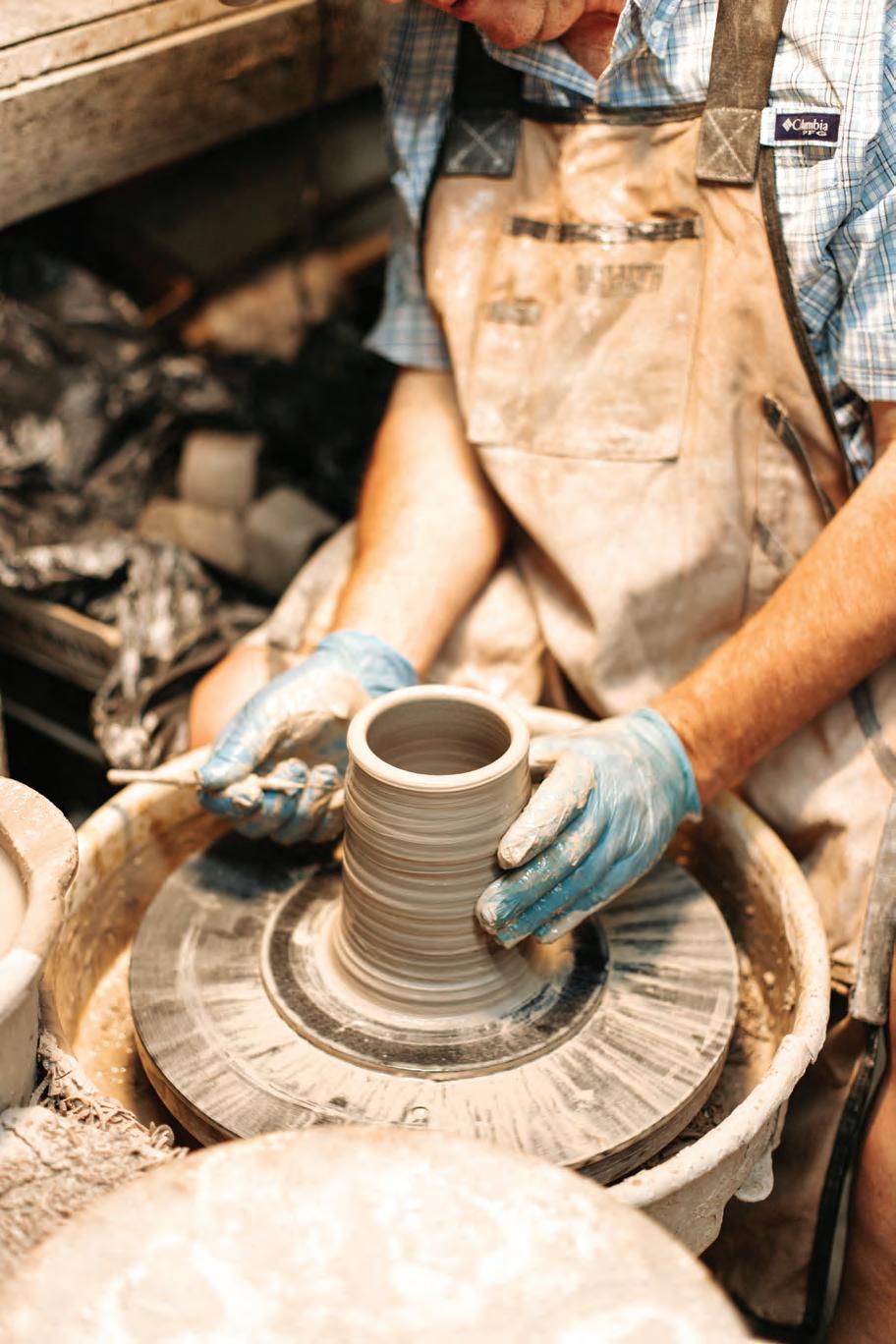
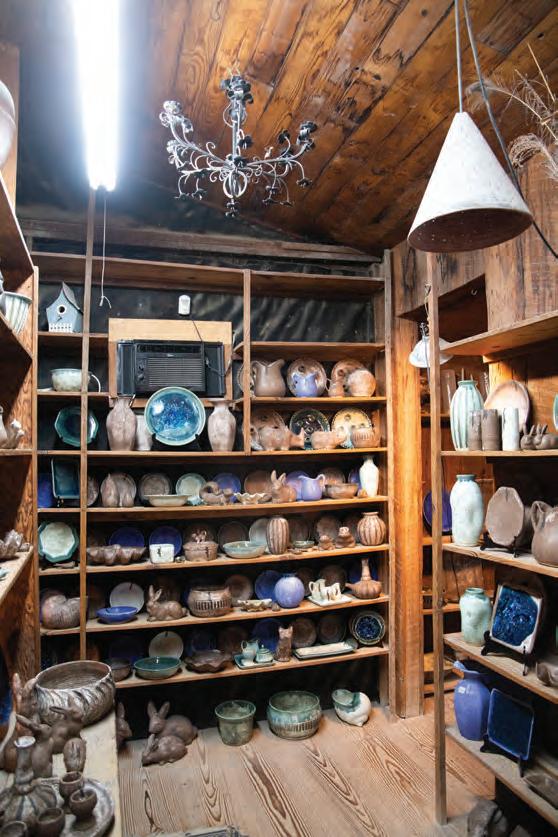
There is a scene that plays out from time to time—where someone at some social gathering somewhere (as far away as San Francisco, New York City, or even overseas) recognizes a piece of McCartys Pottery, with its patented glaze and signature, trademarked black squiggle, a symbol of the Mississippi River.
“They don’t say, ‘What a lovely piece of art’,” said Stephen Smith, who manages his family’s iconic pottery
shop in Merigold. “They say, ‘What’s your connection to Mississippi?’ That usually starts a whole process of ‘Where are you from? Who do you know? Who are your people?’ It’s no longer about the art. It’s about the connection.”
Together with his brother, Jamie, Stephen spends his days keeping that connection to the region alive— forged some seventy years ago with two penniless artists in a mule barn-turned-pottery studio in the sleepy Delta
hamlet of Merigold, Mississippi. But, in truth, it began long before that—when Lee McCarty was being raised within the self-sufficient pioneering culture of the early twentieth century Delta, his childhood shaped by the hardships of the Great Depression. Raised by a single mother, Lee's second parents were family friends Albert and Margaret Smith. Years later, he and his wife, "Pup," in turn became like second parents to their godchildren, Stephen and Jamie Smith (Albert and Margaret’s great nephews) who now carry on the McCartys legacy.
Lee and Ouida fell in love in the early ‘40s at Delta
AUG 23 // COUNTRYROADSMAG.COM 64
64 IDEAS FOR YOUR TRADITIONAL MISSISSIPPI WEDDING
66
IN,
AND LOOK AT SOMETHING (A PETRIFIED FOREST)" AUGUST 2023
REGISTRY //
"COME
PAY $5–$10,
Story by Mimi Greenwood Knight • Photos by Shelby McClure
State University, just before Lee volunteered to join the army during World War II. When he returned, Pup had graduated. They married and went together to Ole Miss where Lee completed his education degree, before acquiring his Masters at Columbia University. They then returned to Ole Miss so that Lee could gain teaching experience at the on-campus high school, teaching chemistry. In the meantime, Pup convinced Chancellor J.D. Williams to let her audit a pottery class. When she showed up for class the first day and realized her classmates were mostly Ole Miss football players, she entreated Lee to join her. This is how they discovered their shared love of pottery. Already painting and jewelry making, they invested in a foot-operated potter’s wheel and a small kiln for their home, eventually establishing a small studio in their garage. All they needed was clay.
Lee mentioned this to his high school class off-handedly one day, and one of his students said, “Mr. Lee, if you call my dad, I’m sure he’ll give you some clay.” That child was Jill Faulkner, and her father was William. McCarty called him and “Mr. Bill” told him, “Come on. I’ll show you where the shovels are, and you can dig all the clay you want.” Thus, the mythic reputation of McCartys pottery was sparked, with some of the couple’s earliest works created from the clay found in a ravine at William Faulkner’s famed Rowan Oak. Those and other early pieces can sell now for more than thousands of dollars a piece.

























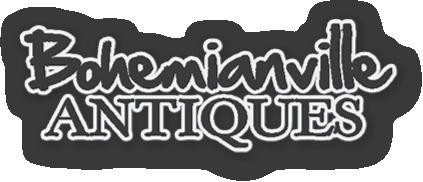
The reason the business is called “McCartys” and not “McCarty’s” can be attributed to Margaret Smith, Lee’s foster mother and a woman ahead of her time. “Aunt Margaret sold life insurance,” Smith said. “She was the first female member of the Million-Dollar Round Table in the 1940s. She told Aunt Pup, ‘When you open this business, you call it McCartys, not McCarty’s, or everyone will assume it’s Lee’s business. You are equal members of a team.’” When they returned to Lee’s hometown of Merigold in 1953 to officially open McCartys Pottery in August of 1954, that’s exactly what they did.
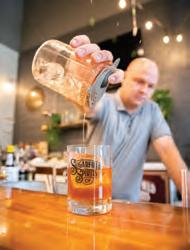


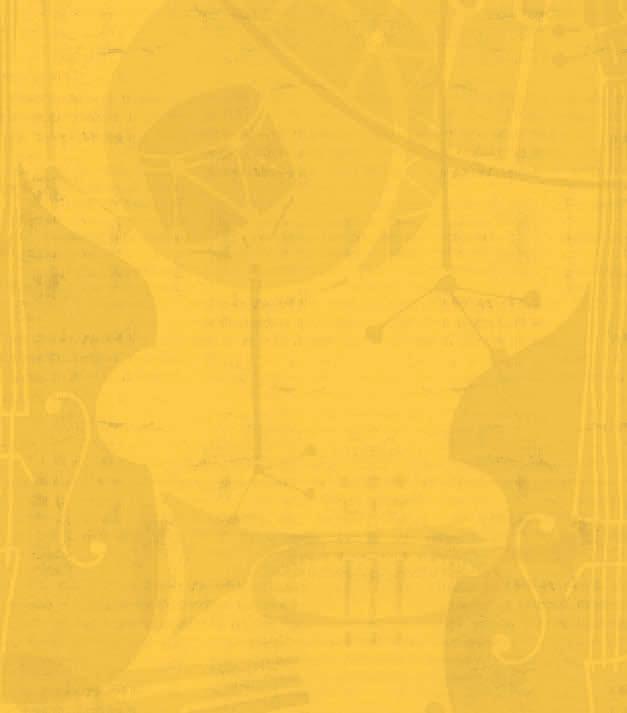
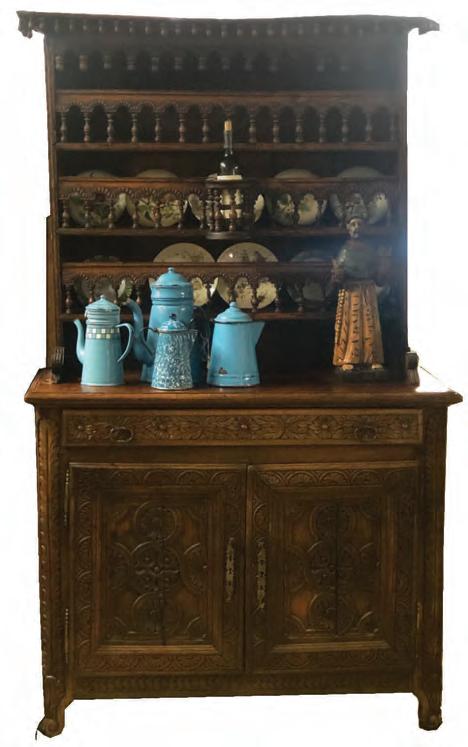
“Just like those pioneers before them, when Uncle Lee and Aunt Pup began their studio, they didn’t want to be beholden to anyone,” Stephen said. When family and friends offered to help the couple financially, they always turned it down. The one thing they did accept was Albert and Margaret's old mule barn, which hadn't been in use since mechanizing their farm. That became the McCartys’ pottery studio.
“They had no air conditioning,” Stephen said. “They slept upstairs just above the kilns. On sweltering summer nights, they’d put a mattress on the floor in front of a set of French doors, and that’s where they slept. During the winters, even with the heat from the kiln, they slept in their coats and sweaters. If you want the definition of a starving artist, that’s it.” What mattered to the McCartys was not creature comforts but the independence to pursue their art any way they chose. They expanded the footprint of the barn little by little, as they could afford to add onto it. The gardens at McCartys barn were inducted into the Smithsonian Archives of American Gardens in 2012.

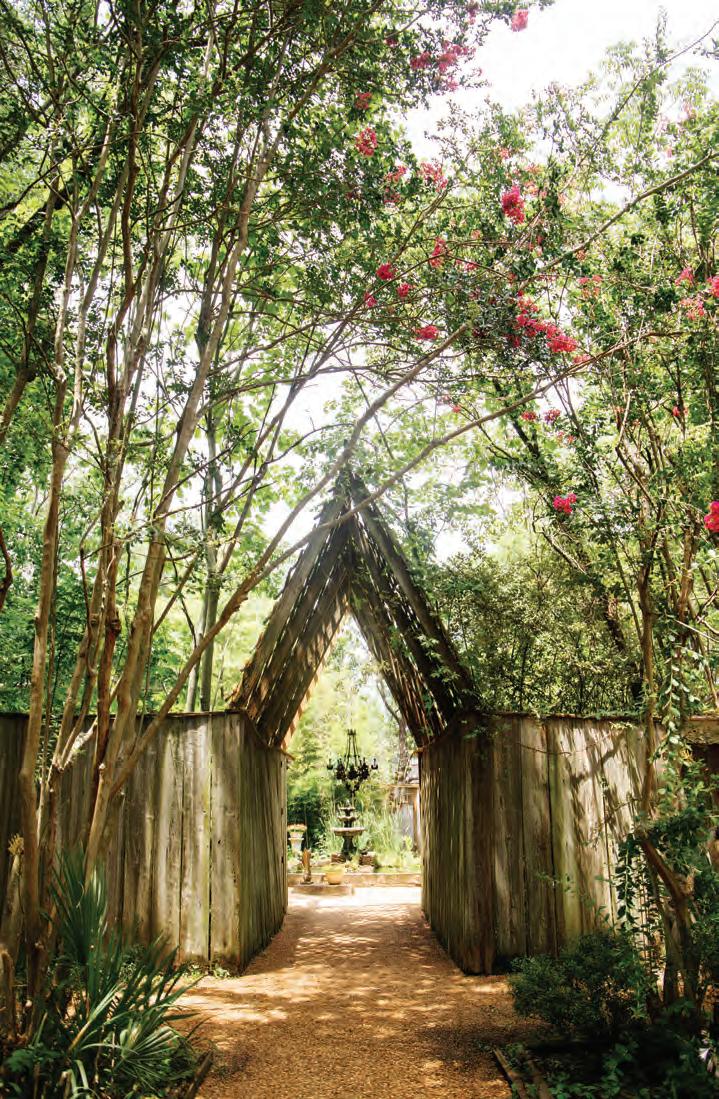
//AUG 23 65
| visit la sweetspot .com @visitlasweetspot PLAN YOUR VISIT TODAY! Nestled between Baton Rouge and New Orleans, a place at the heart of what makes Southern Louisiana such a special destination, there’s just so much to see, taste, experience and savor in Ascension Parish. Louisiana’s Sweet Spot
“They lived life on their own terms, and they were perfectly happy whether they made it financially or not,” said Stephen.


Today, McCartys is still housed in that same old mule barn, known to collectors simply as “the barn”. In 2012, with the help of the Greenville Garden Club, the gardens surrounding the barn were inducted into the Smithsonian Archives of American Gardens, quite an honor for Merigold, a hamlet of just over 500 people. Even though it takes up two acres in the middle of a residential neighborhood, it can be hard to find, unless you know where you’re going. There’s no sign—and never has been. “Uncle Lee believed that, if you create something of quality, people will find you,” Stephen said. And find them they do, traveling to Merigold from all over the country, and even from abroad.
For almost seventy years, McCartys wheel-thrown stoneware pottery has been sought by collectors all over the world, but nowhere more than in the Delta. Just as a couple isn’t considered truly married in New Orleans until they’ve second lined at their wedding reception, a couple isn’t considered truly married in the Mississippi Delta until they’ve received a piece of McCartys Pottery off the registry. It’s a rite of passage for many young women to visit the studio with their mother or grandmother to select their first piece of McCartys. And although neither of the Smith brothers know their way around social media, fans of the pottery have set up Facebook and Instagram pages with tens of thousands of followers.

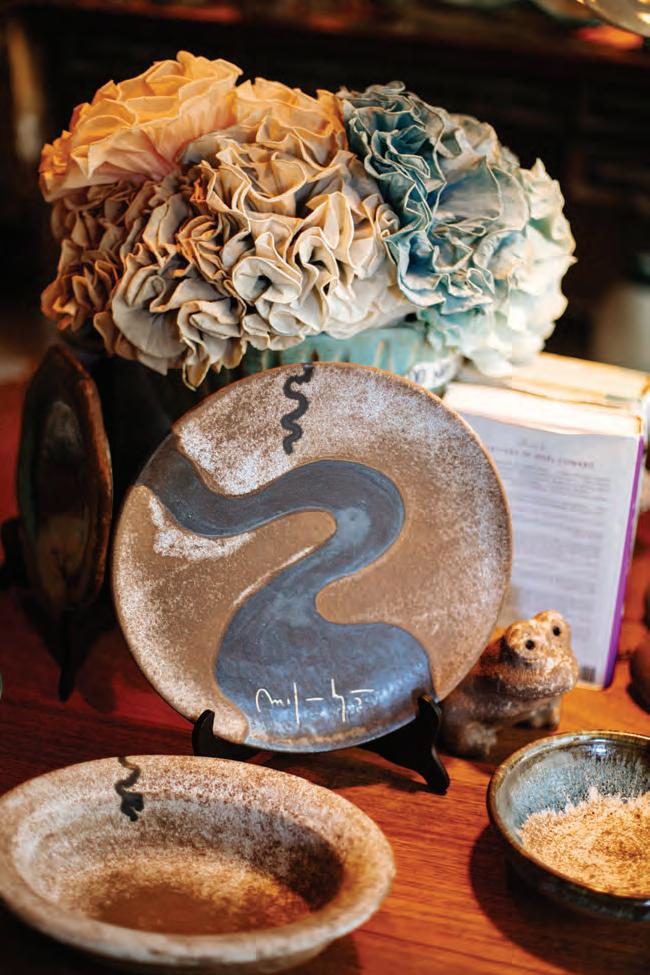
Jamie, who showed promise at the wheel as early as age five, returned to Merigold in 1998. He had been working in business in Birmingham, Alabama, before ultimately heeding the call to return home and apprentice with his godparents as they got older. He quickly realized he needed someone to help him run the business end of things, while he concentrated on the art. His brother Stephen accepted the call, too, retiring from his law practice in Georgia at age thirty-two and returning to his roots.

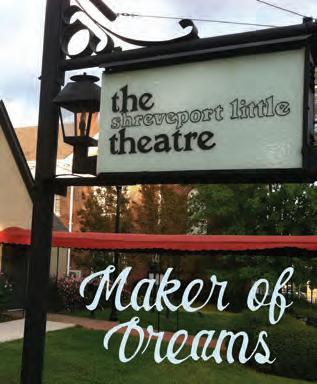
“When I left Merigold, I swore I’d never return,” Stephen said. “But that’s the pull of this area. Even when I lived in Georgia, I was still a Mississippian. That’s Uncle Lee and Aunt Pup’s legacy. They showed others you can stay in Mississippi and still pursue your dreams. If they can take a dilapidated mule barn and create a business that’s known worldwide, if they can create beautiful gardens with their own hands that are now part of the Smithsonian, if they can make something from nothing, you can stay in the place you love and live life on your own terms, too.”

It looks like that McCartys legacy is destined to continue on. Even as Jamie sits at his Uncle Lee’s pottery wheel and recreates his godparents’ designs, even as Stephen delights the next generation of artists with tales of the heart and soul his godparents put into their creations—Jamie’s youngest child, Elizabeth McCarty “Carty” Smith has taken her own place at the pottery wheel, excited to learn from her dad how to carry this art form into the next generation.
“You can’t separate McCartys from Merigold and you can’t separate Merigold from McCartys,” Stephen said. “Uncle Lee and Aunt Pup were going to be successful artists whether they met each other or not, and they could have found that success in New York or California—or anywhere. But it took the two of them together, right here in Merigold, in the Mississippi Delta, to create everything that is McCartys.” •
AUG 23 // COUNTRYROADSMAG.COM 66
www.lpb.org www.lpb.org/livestream Monday, August 21 at 7PM Wednesday, August 23 at 7PM Tuesday, August 15 at 7PM
Petrifying Antics
About 36 million years ago, a river flowed through central Mississippi. Among hthe flotsam and jetsam it carried were massive logs, which became buried under mud on their way downriver, possibly as part of a Red River Raft-style massive logjam, where they fossilized. There they waited for the slow processes of geology to reveal them again. By the mid-1850s, the light loess soil and red riverine soil that cover much of Mississippi had rinsed away from some of the stony logs, revealing them to human curiosity—and depredation. People came both to marvel and to nab, and many of
the fossils were lost before the Schabilion family acquired the land in 1962 and began developing a protected attraction. Today, this, the only petrified forest in the eastern United States is preserved and open to visitors near the town of Flora— and well worth a detour if you’re passing through central Mississippi.
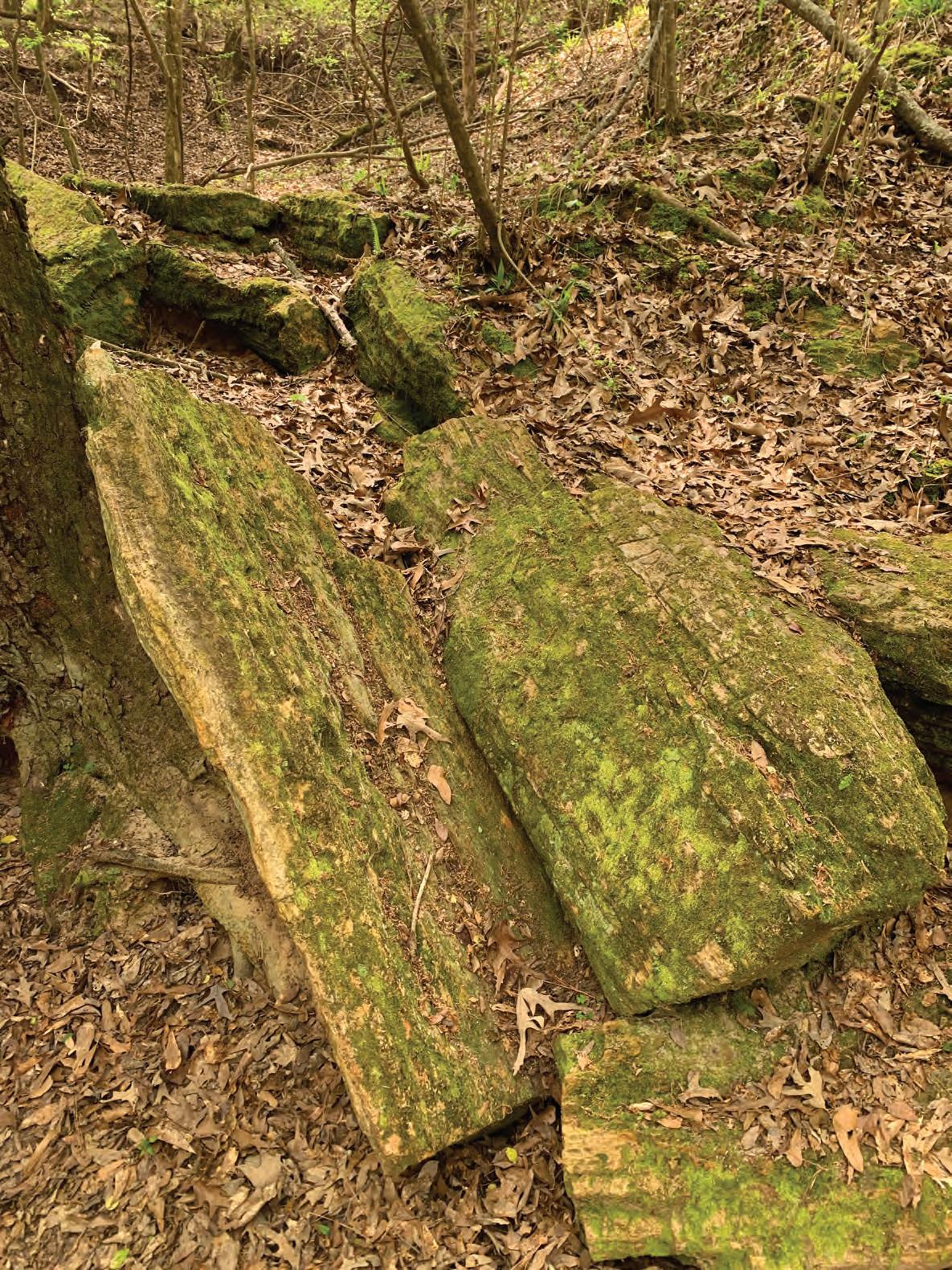
If you’re like me, you learned in school or from various dinosaur-related media that “fossils happen when living matter turns to stone over time.” I accepted this for decades before I realized it was effectively transubstantiation and that I didn’t understand the process at all. Per the National Park Service, the missing
ingredient is water. After some organism dies and is covered in sediment or some other protective substance that postpones or prevents decay, water with high mineral content seeps into small cavities in the organism. The dissolved minerals ultimately crystallize, time wears away the surrounding tissues, rinse/repeat, and voila—a fossil eventually emerges. While the process seems imprecise, scientists have been able to examine ultrathin slices of fossilized trees and identify species via preserved cell structure, even designating previously known, extinct species. (One is named Florxylon—“wood from Flora”.)
One of the main tricks to successfully traveling with others is triage: pick a small number of personal priorities, stick with them, and otherwise let fate and the whims of your companions reign. On a recent family trip through Mississippi, I latched onto the petrified forest like a terrier. I had been several years ago, in that gauzy, unmeasurable time called “before COVID,” and I had vague but pleasant memories of a shady walk, a respite from highway driving. I wanted to see it again, so I added it to our itinerary—a privilege of being the driver.
Flora is just far enough out to not quite feel like a suburb of Jackson—from Jackson, Vicksburg, or the Natchez Trace, it is a detour, but not an “ugh that’s going to take all day” one. The front of the gift shop/museum/visitor’s center presents a comfortably touristy face: low wooden buildings looking out over an unpaved lot are how America says “come in, pay five to ten dollars, and look at something.”
The first thing you’ll see is a cross-section of a sequoia trunk, its rings labeled with momentous years in human history: while we were busy with flash-in-thepan events like “the Battle of Hastings” and “the Civil War,” the infinitely wiser trees simply grew. Per the visitor’s guide, the main path through the “forest” runs about six blocks. It feels longer, which I mean as a compliment. If you’re traveling with someone with limited mobility or endurance, there’s a shortcut—you can walk in together, leave your companion on a benchlike log to enjoy the forest while at rest, then collect them as the path loops back toward the end— this much of the trail can be accessed in a wheelchair. The entire path is shady, with the trees creating the rare situation of “outdoors but cozy.” A trail guide comes with admission, which you can follow as closely as you want. Like most documents of this sort, there’s a scavenger-hunt quality (“Have you found number six?!”), but without it I wouldn’t have thought to look at a particular petrified chunk to see that, indeed, it does look like a frog, and I enjoyed learning that animals make little dens in the hollows of petrified logs that collapse. (Of course they do, but it’s nice to know for sure.) The petrified wood is fascinating, but make time to savor the living forest, too. Even without the fossils, the path would be an excellent nature walk.
When you return to the main building, you’ll pass through a couple of museum rooms densely packed with fossils and stones, then emerge into a vast gift shop, well-appointed for rockhounds. I’ve rarely, if ever, praised a gift shop, but the profusion of stones and fossil, from both nearby and all over the world, defies even casual browsers not pick up a souvenir. You’ll want to remember this surprising bit of natural history in the middle of Mississippi. •
mspetrifiedforest.com
//AUG 23 67
OUTDOORS BUT COZY
A FORAY TO THE FOSSILIZED FOREST IN FLORA, MISSISSIPPI
Story and photo by Chris Turner-Neal
A fossilized tree in Flora, Mississippi's Petrified Forest.

AUG 23 // COUNTRYROADSMAG.COM 68
Merchants Baton Rouge, LA Allwood Furniture 20 Arts Council of Greater Baton Rouge 17 Baton Rouge General 29 Becky Parrish Advance Skincare 16 Blue Cross Blue Shield 34 BREADA- Main Street Market 32 BREC 59 East Baton Rouge Parish Library 72 Elizabethan Gallery 49 Franciscan Missionaries of Our Lady University 7 Louisiana Public Broadcasting 66 LSU Rural Life Museum 61 Pennington Biomedical Research Ctr. 22 Pinetta’s European Restaurant 49 Stafford Tile and Stone 27 Window World of Baton Rouge 24 WRKF 89.3 FM 66 Young Entrepreneurs Academy 44 Bogalusa, LA Bogalusa Blues Festival 23 Brookhaven, MS Brookhaven Tourism Council 44 Cleveland, MS Visit Cleveland 13 Erath, LA The Acadian Museum 45 Ferriday, LA Brakenridge Furniture 9 Fredericksburg, TX Visit Fredericksburg 35 Grand Isle, LA Grand Isle Tourism Department 62 Hammond, LA Tangipahoa Parish CVB 71 Houma, LA Explore Houma 30 Jackson, MS Visit Mississippi 5 Lake Charles, LA Louisiana Food and Wine Festival 43 Visit Lake Charles 14, 15 Lafayette, LA Allwood Furniture 20 J & J Exterminating 26 The Hilliard University Art Museum at the University of Louisiana at Lafayette 47 Mandeville, LA Visit the Northshore 50, 51 Mansura, LA Avoyelles Tourism Commission 19 Morgan City, LA Cajun Coast CVB 62 Louisiana Shrimp and Petroleum Festival 31 Natchez, MS Brakenridge Furniture 9 Katie’s Ladies Apparel 16 Monmouth Historic Inn 36 Natchez Pilgrimage Tours 37 Olivina Boutique 39 Visit Natchez 39 New Iberia, LA Iberia Parish CVB 10 New Orleans, LA Historic New Orleans Collection 25 New Orleans Public Library 56 Stafford Tile and Stone 27 New Roads, LA City of New Roads 47 Opelousas, LA St. Landry Parish Tourist Commission 59 Plaquemine, LA Iberville Parish Tourism Department 38 Port Allen, LA West Baton Rouge Museum 60 West Baton Rouge CVB 18 Raceland, LA Louisiana’s Cajun Bayou 40, 41 Ridgeland, MS Ridgeland Tourism Commission 3 Shreveport, LA Shreveport- Bossier CVB 33 Scott, LA Bob’s Tree Preservation 61 Sorrento, LA Ascension Parish Tourism Commission 65 St. Francisville, LA Bohemianville Antiques, LTD 65 St. Francisville Food & Wine Festival 55 The Corbel 2 The Magnolia Cafe 53 Town of St. Francisville 53 Ville Platte, LA Evangeline Parish Tourist Commission 60 Woodville, MS Community Grocery 6
Directory of


// AUG 23 69
into memories of the hurricane. “The first house I ever went into, it reminded me of what I saw looking into the window of my grandma’s house [in Waveland, Mississippi] after Katrina, and it just flooded me in a way that I didn’t expect.”
Trosclair turned to the materials being broken down by nature and time within these structures. “All of these layers that had been covered up over time were now exposed and kind of unraveling to create these new patterns of design and beauty through that,” she said.
Architectural Skins
NEW ORLEANS ARTIST CARLIE TROSCLAIR’S INVESTIGATION OF THE SPACES IN WHICH WE DWELL
By Jordan LaHaye Fontenot
On an afternoon in the fall of h2021, New Orleans artist Carlie Trosclair walked out into Cobscook Bay, shuffling her waders through the shallow sludge at low tide, cursing—dragging a full-scale latex casting of a porch behind her. The water would rise again, as high as twenty-four feet, by the afternoon.
Upon Trosclair’s arrival in Eastport, Maine—where she would complete an eight-week residency with the Tides Institute and Museum of Art—the shift of the bay’s remarkable tides had instantly struck her. “How do y’all not flood?” she wondered, haunted by images of waterlogged houses in Pointe-au-Chien in the wake of Hurricane Ida, a disaster cleanup she’d only just finished lending her hand to a few weeks prior.
She soon learned that Eastport’s waterfront structures are built with recesses beneath the buildings, which accept the tide—taking the water in, then allowing it to flow back out. “I was just like, ‘Oh my God, that is a real-life example of what it looks like to work with nature, within the architecture,’” she said.
Dragging her most recent sculpture into the Bay, her body recalled the exhaustive labor of rebuilding in that post-hurricane haze. She set the casting up against the remnants of an old pier, and she waited, watching as it ever-so-slowly buckled beneath the rising waters. “Of course, the image of this shell of space, engulfed in water over time— you know, of course subconsciously there is a layer of that disaster there.”
Trosclair often speaks of her work in terms of layers, conceptually and materially folding in on itself, crinkling here and stretching there, ever peeling away, posed to unveil another layer, another idea. Recent years, shaped by a 2019 return to her hometown of New Orleans,
have brought her to dissect influences deeply buried: how the city, and its architectural fragility, have innately shaped her journey as an artist—and particularly as an artist so preoccupied with the philosophy of structure, and its eventual ruin. Of course, water—and its capacity for destruction—is an indelible part of that story. And for Trosclair, who was a nineteen-year-old student at Loyola in 2005, so is Katrina.
“I feel like I didn’t have a chance to process all of it.” She recalls being miles away from home, evacuated, sitting with her dad and trying to navigate an early version of Google Maps to find their house, to see if the roof was still there.
Almost a decade and a half later— most of which Trosclair had spent living away from New Orleans—this memory arose when she arrived in the city for a five-month residency at the Joan Mitchell Center in the Tremé in 2019.
“You know how you can go onto Google Maps and look at a home, and go back in time? I spent probably weeks walking through that neighborhood back in 2007,” she said. “And I felt these layers of time folding in on themselves. It was almost like I created this space where I mentally jumped back . . . It was really kind of overwhelming. It was the first time that I thought about the place that I was from, and the place that I grew up, in this lens of what had happened architecturally—which of course is a stand-in for what happened to the people.”
Despite this, a retrospective look at Trosclair’s body of work even prior to her Joan Mitchell residency reverberates with themes of infrastructural legacy, decay, and rebirth. After completing her MFA at Missouri’s Washington University in 2010, she remained in St. Louis, embarking on explorations of the city’s abandoned homes, which fold themselves

This exploration of dwellings and habitation, exposure to the elements and abandonment, and the human body’s intimate relationships with space sustained Trosclair’s artistic practice for over a decade—culminating in ever-evolving studies presented as site-specific sculptural installations staged all across the country, but often within St. Louis’s abandoned buildings themselves, where she carved lacework designs into crumbling wallpaper and peeled back plaster just so, to reveal hints of the bricks laid behind it.
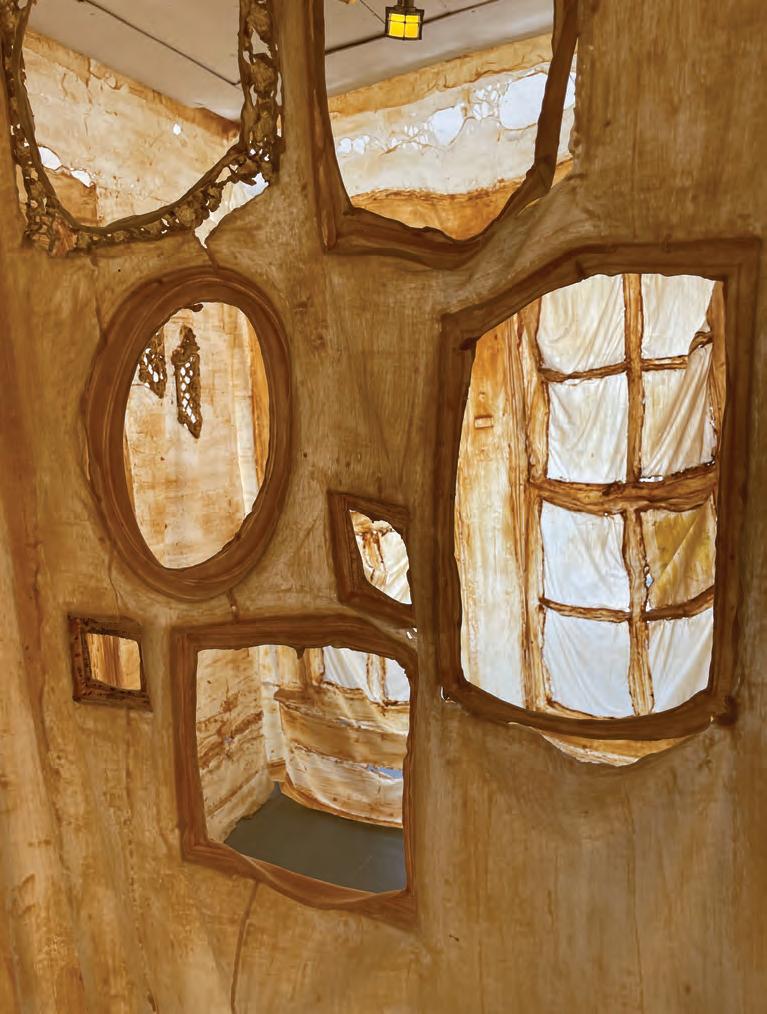
“The term ‘architectural skin,’ was a part of my work really early on,” she said.
In recent years, this concept has manifested more literally in Trosclair’s latex work, through which she creates phantom-like sculptural casts of everything from doorknobs to entire front porches. It started materially, in a search for something that would physically embody this idea of skin while also being tactile and malleable enough to hold its own form.
“Then, conceptually, it folded in really beautifully,” she said. A natural material traditionally used in architectural restoration work, latex is usually used as the intermediary to create a plaster cast. Trosclair turns this method upside down, using the latex instead as a sort of shedded shell—“like cicadas, or snakeskin”.
“Latex holds this temporary moment of a surface or structure, and it kind of crystallizes that moment, not only in the imprint of what is physically present, but also by transferring actual particles. It
kind of embeds that moment.”
Her work these days is focused on pushing latex as a material as far as she can, carrying the concept to ever new, though always contiguous, places. For a 2022 installation, she honed in on concepts of reflection, and on the relationships between past and present: a latex cast of a ceiling fan posed immaculately from its place above, doubled just beneath by a sagging, limp residual version of itself. The idea came to Trosclair while walking to her car, wearing galoshes, in New Orleans—noticing the rippled, broken reflections of the shotgun houses in the floodwaters after a short burst of rainfall. The installation was included in her exhibition as part of Houston’s Project Row Houses Southern Survey Biennial in 2022–2023, along with within|between, for which she cast the entire interior of a room, then placed it inside the room—allowing viewers to walk in between the real wall and the ghost wall. “It’s kind of like this imprint, or imaginative kind of past or something—or future,” she said. This installation will be exhibited again at the Ohr O’Keefe Museum of Art in Biloxi from August 17–December 13 as part of the Southern Arts exhibition of its State Fellows for the Visual Arts, before touring across the region in 2024.
In the meantime, Trosclair is casting cypress knees. The concept started, as it so often does, with her thoughts on layers, and time, and water—and more recently, breath. “I’ve been thinking a lot about breath when it comes to the body, a lot about inhale and exhale,” she said. “And I didn’t even know when I started casting these, but there is a theory that cypress knees pop up out of the water to get air back down to the roots. An aeration system. Breath. It’s almost like everything just subconsciously cycles back to itself.”•
carlietrosclair.com
AUG 23 // COUNTRYROADSMAG.COM 70 Sponsored by Tangipahoa Parish Tourism
PERSPECTIVES: IMAGES OF OUR STATE
Carlie Trosclair.“Pentimento,” 2015. Hand cut conrete in an abandoned building. 10’ x 20’ x 2”
Carlie Trosclair.“within|between,” 2022, latex. 9’x 9’x 9’

// AUG 23 71







































































 By Alexandra Kennon
By Alexandra Kennon

























 RE-EXAMINING AUDUBON
RE-EXAMINING AUDUBON



























































 BY DR. LAUREN CROSS
BY DR. LAUREN CROSS



 Story by Jordan LaHaye Fontenot •
Story by Jordan LaHaye Fontenot •






























































































































































